
If you are coming to visit Provence, don't stop in Avignon!
Once here, like a siren, the city will entrance you and you won't want to leave!
And just to see the sights, you can spend days wandering the neighbourhoods within the city walls and never get bored.
Avignon is full of history and full of life.
Capital of the Vaucluse and the Côtes du Rhône, seat of the popes and city of art and culture, theatre, cinema, museums, big stores and little shops, Avignon is a small city that has everything a big one has, and then some...
From medieval streets and houses to private mansions from the Renaissance, passing through all its old and enticing squares, some no bigger than a tiny lane... And the diverse dining opportunities, ranging from family-run restaurants, good and inexpensive to some of the greatest Michelin-starred chefs.
Avignon invites you for a stay beyond all imagination.The historic city centre, the Popes' Palace , all the episcopal buildings and the Saint Bénézet Bridge are listed as world heritage sites by UNESCO.
The historic centre radiates from the Place de l'Horloge .
Here, you find the City Hall built between 1845 and 1851 over a former cardinal's palace of which it has kept the old fortified tower, transformed into a belfry in the 15th century with clock and Jacquemart. Next to it, the municipal theatre, also from the 19th century, houses the Avignon opera and, all the way at the top, the delightful Belle Époque style carrousel still turns.
Originally the forum of Avenio, the city's name under the Romans in the 1st century BC, the Place de l'Horloge is still the “centre” of Avignon. A meeting place, bordered by cafés and restaurants, the square is always bustling. Just like the Place du Palais higher up, a vast esplanade where you could spend the day just watching all the street performers in summer.
And as its name implies, here stands the formidable Popes' Palace, emblem of the city and awe-inspiring monument to the importance of Avignon in the Christian world of the Middle Ages.
Built in the 1300s, mainly by two popes - the austere Benedict XII and his successor, the much less ascetic Clement VI, - the palace would become the biggest gothic edifice in all of Europe. A tour of the palace, which includes the popes' private apartments with their fabulous frescoes, is one one of the musts of Avignon.
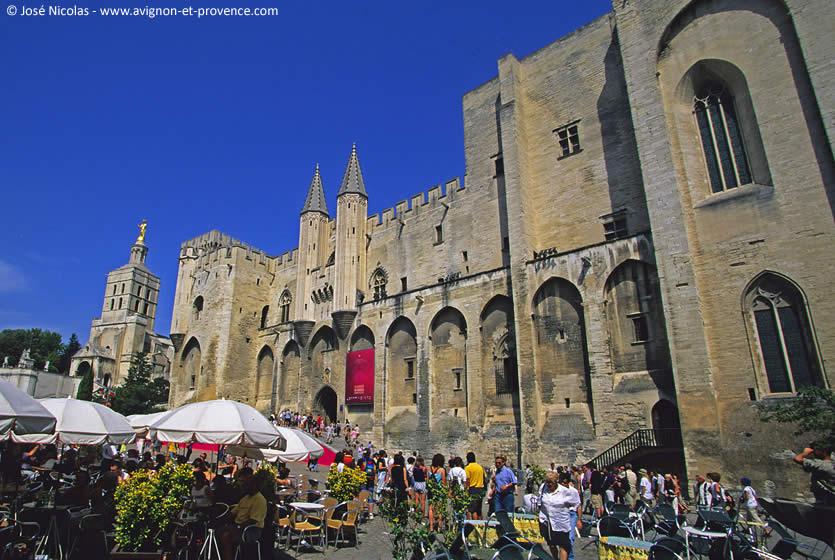
Palace of the Popes Square, Avignon Festival
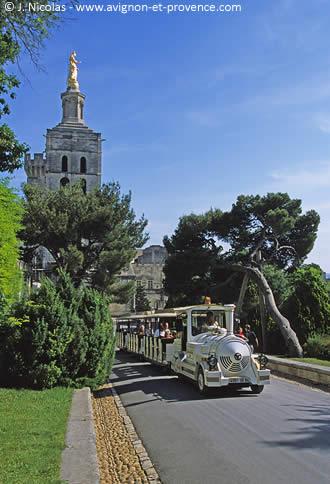
Next to the palace, the Notre-Dame des Doms Cathedral , built in 1150 in a Provençal Romanesque style, was put on the first very list of historic monuments in 1840. From the top of its bell tower, the statue of the Virgin Mary, entirely gilded in gold, 6 metres high and weighing 4500 kilos, blesses and protects the city.
Across from the palace, dragons and eagles stand guard over the imposing edifice of the Hôtel des Monnaies , once the city's mint. And not far away, the Petit Palais , a former cardinal's residence turned into a museum, houses an impressive collection of Italian primitive art, old sculptures by Avignon artists and paintings from the Avignon School.
If all this splendour and exuberance already has your head spinning, go up to the Rocher des Doms , the cradle of the city, for a refreshing break amongst the peacocks and swans by the pond. From this spot, you have panoramic views over the entire city, its tiled roofs and bell towers and over to Villeneuve-les-Avignon and all the surrounding areas.
At the bottom of the Place de l'Horloge , the main avenue, Rue de la République , divides the city into two. On one side, the Rue Saint Agricol leads to the chic and bourgeois quarter with the Rue Joseph Vernet , the 5th Avenue of Avignon where designer clothing and luxury goods shop abound, and the Place Crillon , with the prestigious Hotel d'Europe in a former private town mansion built in the 16th century for the Marquis de Graveson.
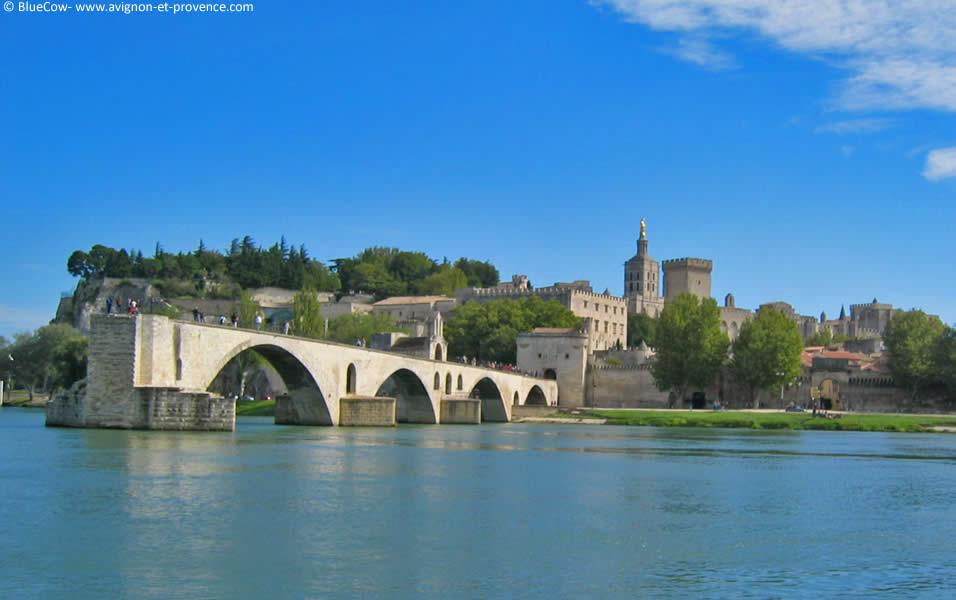
Panoramic view over Avignon from the Barthelasse Island
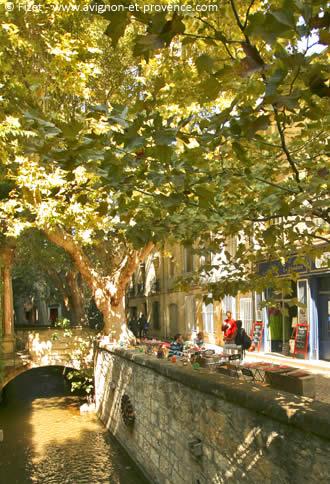
On the other side, the pedestrian and shopping zone leads to the Place Pie and the Halles , the covered market adorned with a hanging garden . A meeting place for the people of Avignon, the stalls offer all sorts of foods and treat. Don't go with an empty stomach!
Not far from there, the Place des Carmes also has two very popular markets: a flower and farmers' market on Saturday mornings and the flea market on Sundays. The square gets its name from the magnificent Carmelite cloisters and its 13th century convent church.
Or you can head to the bohemian quarter of Avignon and the Rue des Teinturiers bordered by the little Sorgue river. If it is not the centre of Avignon, the street is one of its “hearts”. Today haunted by artists and musicians as well as born and bred Avignonnais, this delightful cobblestone street dates from the Middle Ages and the period when the textile industry was in full swing.
If the water wheels, of which four still remain from their heyday, no longer turn, the street certainly swings with its wine bars, small cool restaurants, musical evenings, all in the shade of the sycamores and in an almost village-like ambiance.
If you want to open up your horizons, go do a tour of the ramparts . The Avignon city walls constitute the 2nd longest continuous wall in the world, after the Great Wall of China. You can access the walls' walkway from the Rocher des Doms or from the Saint Anne stairs behind the palace.
Then, go dance on the famous bridge of Avignon . The Saint Bénézet Bridge was built around 1180 – miraculously, according to legend, by a simple shepherd – to link the city to Villeneuve-les-Avignon.
Over the years, a war and successive flooding by the Rhône partially destroyed the bridge. Today, the 12th century Saint Nicholas Chapel remains, as well as four arches of which the span constitutes, according to a prestigious civil engineer, an amazing feat for the period.
At the foot of the bridge you will find the landing pier for the cable ferry that will take you free of charge to the Barthelasse Island for a stroll in the countryside just a stone's throw from the city.
Unless you prefer exploring one of the museums of which Avignon has many. Between the collections of contemporary art (the Lambert Collection ) and of paintings ( Musée Angladon and Petit Palais ), the museum of Fine Arts ( Musée Calvet ), of archaeology ( Musée Lapidaire ) and of period furnishings and decorative arts ( Musée Louis Vouland ), you will be spoiled for choice.
And let's not even talk about the religious edifices!
Rabelais wanted to call the city the Ile Sonnante, or the Chiming Island, because of all the churches, chapels and convents. We can't list all of them here but mention should be given to the exquisite Saint Pierre Basilica , particularly captivating when illuminated at night, the majestic Saint Didier Collegiate Church and the Protestant church of the Temple Saint Martial.
Everywhere, just around a corner or on a small square, you will come across a penitents' chapel or small church, all of them housing treasures and artworks of inestimable historic value.
A city to be savoured in all seasons thanks to the many events that take place throughout the year, Avignon really takes on another dimension during its “5th season” in July, when the Avignon Theatre Festival takes place.
This festival of dance, music and theatre was founded in 1947 by the actor and director Jean Vilar (2016 will be the 60th festival). The shows are performed everywhere throughout Avignon, even in the streets. Today, it enjoys international renown but, with the less formal Festival Off , a close audience rapport has been maintained.
Advice to visitors: with all the pedestrian zones and one-way streets, driving can be difficult for those who don't yet know the city. On top of that, parking is sometimes a nightmare. If you are staying in one of the city's hotels, inquire at reception about the best way to park. If you are coming just for the day, consider leaving your car in one of the lots just outside the ramparts, such as the Parking des Italiens or on the Ile Piot; both of them have a free shuttle service into town every few minutes that even operates late into the evening in summer.
Art of living
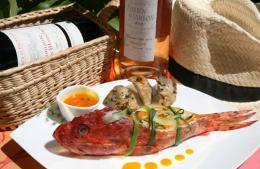
Gastronomy, markets of Provence, regional products, Christmas traditions, celebrities of Provence....
Where to sleep?
454 EUR/night*
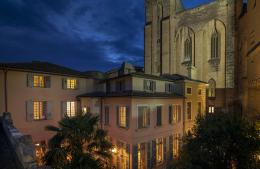
Hotels - Avignon and the surroundings
450 EUR/night*
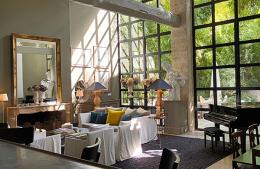
Vacation rental - Avignon and the surroundings
Numéro 15 – Les Confidences
160 EUR/night*
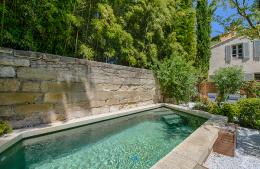
Bed and breakfast - Avignon and the surroundings


10 Top-Rated Things to Do in Avignon
Written by Lisa Alexander Updated Dec 22, 2023 We may earn a commission from affiliate links ( )
An excellent starting point for exploring Provence , the historic city of Avignon awes with its stunning papal palace. The UNESCO-listed Palais de Papes was the residence of seven Popes from 1309 to 1377 and is a testimony to the wealth and power of Christendom during the Middle Ages.
The tourist appeal of Avignon goes beyond its amazing UNESCO World Heritage Sites. This city is known as a center of art and culture. Attending festivals are some of the main things to do in Avignon throughout the year, from the popular summertime Jazz Festival to a traditional Christmas market in December.
Enjoy the relaxing Provençal atmosphere of this small town as you explore the quaint streets, such as the Rue des Teinturiers and elegant squares like the Place des Corps Saints. At the heart of Avignon, the Place de l'Horloge is lined with shady plane trees and filled with cafés where patrons sit and watch the world go by.
Avignon also makes a good base if you want to explore nearby towns and attractions. Discover more places to visit in and around this historic city with our list of things to do in Avignon.
See also: Where to Stay in Avignon
1. Palais des Papes
2. pont saint bénézet, 3. rocher des doms, 4. musée du petit palais, 5. basilique métropolitaine notre-dame des doms, 6. eglise saint-didier, 7. place de l'horloge, 8. basilique saint-pierre, 9. avignon festivals, 10. musée calvet, where to stay in avignon for sightseeing, day trips from avignon, provence's ancient roman sites, hilltop villages of the luberon, saint-rémy de provence, villeneuve-les-avignon, map of things to do in avignon, other interesting places to visit near avignon.
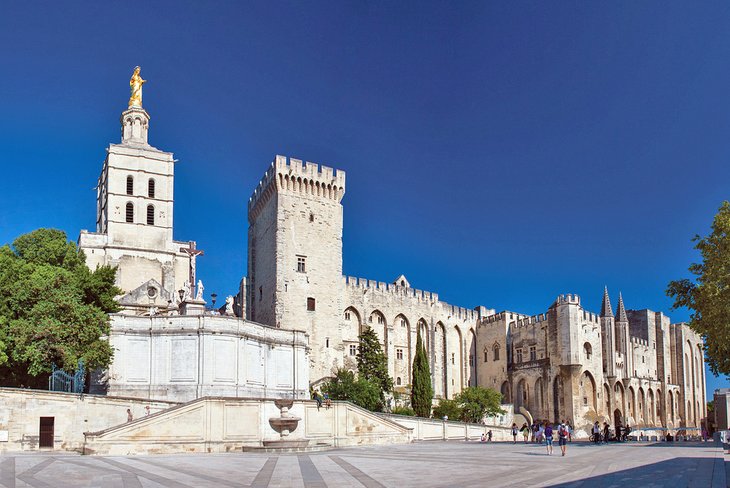
To visit the Palais des Papes is to witness the power of the Papacy during the Middle Ages.
Designated as a UNESCO World Heritage Site , this imposing palace was the most important monument in Christendom during the 14th century, when Pope Clement V moved the papal court from Rome to Avignon.
You can take a tour of the interior to see the 20 rooms that are open to the public. Although most of the furnishings have disappeared, the interior offers a sense of the vastness of the space. The halls, stairways, bedrooms, and chapels were all built on a grand scale around a central courtyard.
Highlights include the Great Audience Hall , an enormous hall embellished with wall paintings; the Grand Tinel banquet room; the Saint Martial and Saint John chapels , decorated with well-preserved frescoes created by the Italian painter Matteo Giovanetti; and the Great Clementine Chapel, a huge single-aisled church where official ceremonies were held.
From the Great Chapel, there is an entrance to the loggia where the large traceried Fenêtre de l'Indulgence (Window of Indulgence) offers a view of the Great Courtyard . From this window, the Pope used to give his blessings to the faithful.
Address: Place du Palais, Avignon
Official site: http://www.palais-des-papes.com/en
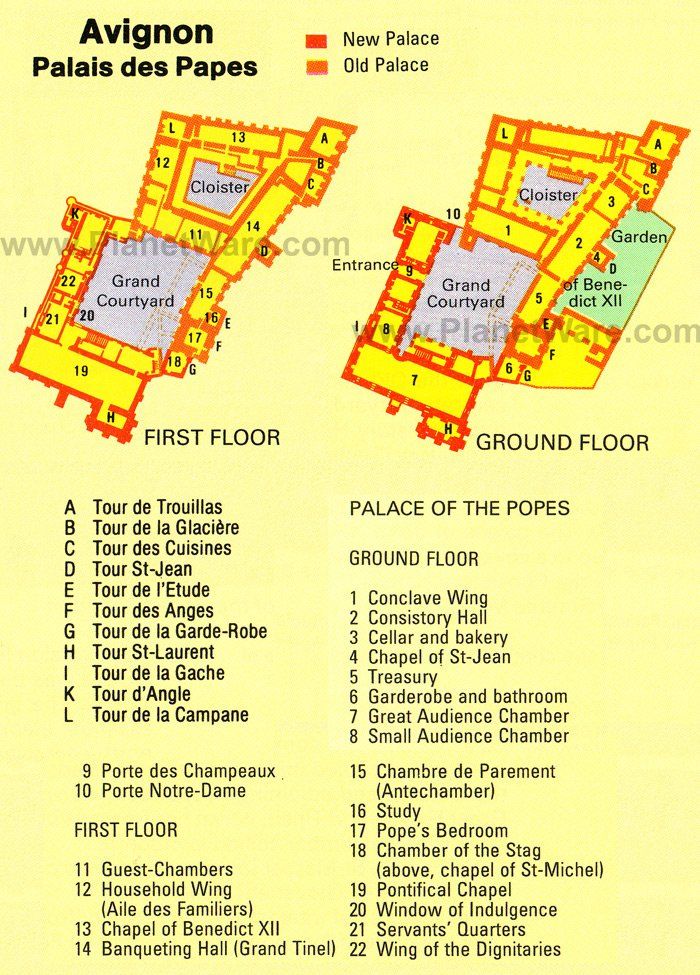
This graceful 13th-century landmark is one of Avignon's most iconic sites, and walking its length is among the top things to do in Avignon.
The Saint Bénézet Bridge is intriguing for its romantic half-ruined state and legendary association. Many are familiar with the famous song about the bridge (" Sur le Pont d'Avignon "), which was originally composed in the 16th century.
During the Middle Ages, the Pont Saint Bénézet was an essential crossing on pilgrimage routes between Spain and Italy. The bridge was used for transportation across the Rhône River until the 17th century (when the structure collapsed).
The Pont Saint Bénézet is listed as a UNESCO World Heritage Site and is open to the public as a museum. The site features multimedia displays that show how the bridge and its setting evolved over the centuries. The entry ticket includes an audio-guide. You can also admire the 13th-century Chapel of Saint Nicolas, which is part of the bridge.
A short walk from the Pont is a delightful public park, the Jardin du Rocher des Doms . Built on the Rocher des Doms hillside, this leafy English Garden, with its ponds, water pools, and terraces, provides sensational views and a refreshing environment for relaxation.
Address: Boulevard de la Ligne, Avignon
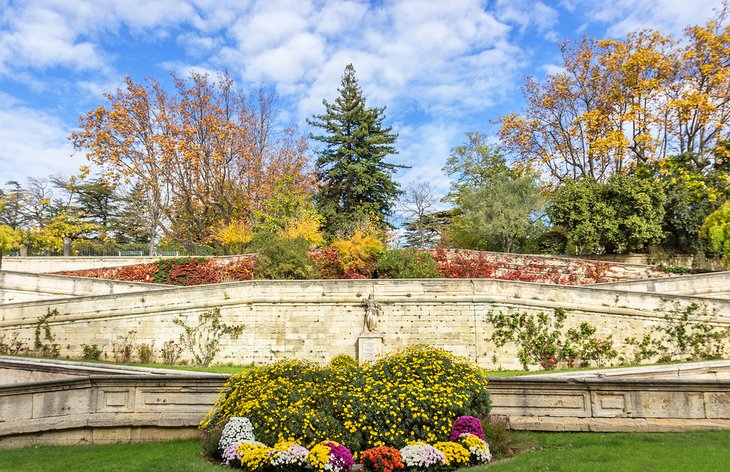
A short walk away from the Palais des Papes, the Rocher des Doms is a rocky promontory that offers an exceptional panoramic view of Avignon. This location has a gorgeous park on its summit, which is a wonderful place for a leisurely stroll.
From the gardens, you can see the Palais de Papes, the Pont Saint-Bénézet, the Rhône, and the islands of Barthelasse and Piot in the river, as well as the village of Villeneuve-lès-Avignon on the far bank.
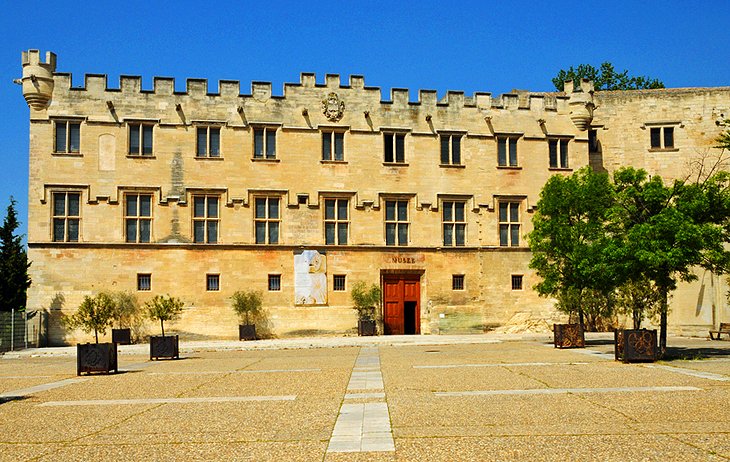
Built between the 13th and 15th centuries, the Petit Palais was the residence for Avignon's episcopal bishops before Pope Clement V created the Palais des Papes. This UNESCO-listed building was designed as a Gothic fort and is distinguished by the crenelated outer wall, a defensive feature typical of medieval and Renaissance fortresses.
The Petit Palais houses a fine arts museum with an exceptional collection of medieval art, Italian Renaissance paintings, Provençal paintings, and medieval Provençal sculptures. The collection includes masterpieces by Italian painters, including Sandro Botticelli and Louis Brea. The museum's most famous piece is Botticelli's Virgin and Child painting.
Temporary exhibits, related to fine arts topics, are held at the museum on occasion.
The Petit Palais museum has a café with outdoor seating in a quiet courtyard. The café offers a selection of tea, coffee, hot chocolate, and pâtisseries.
The museum is open year-round daily except on Tuesdays and holidays.
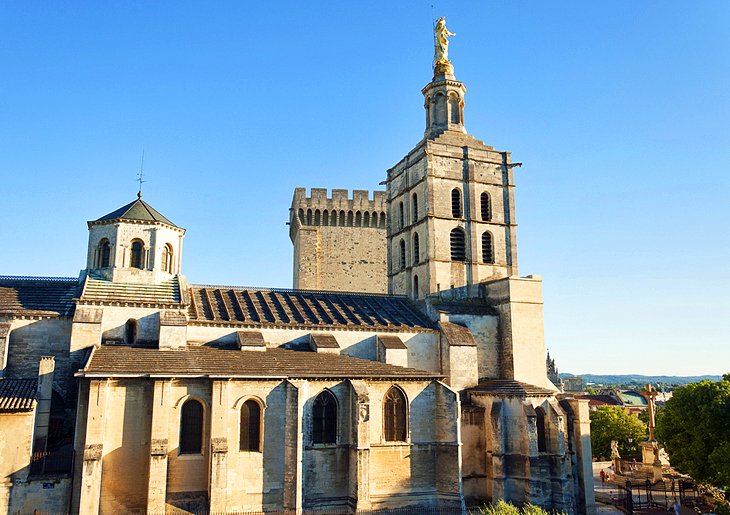
Although this building pales in comparison to the nearby Palais des Papes, the Basilique Métropolitaine Notre-Dame des Doms is still worth a visit. The monument stands on the Rocher des Doms hillside, which affords views of the Rhone Valley.
This beautiful cathedral has a serene 12th-century interior. While the nave, bell tower, and portico are Romanesque, other elements of the building were added in the 15th and 17th centuries.
Upon entering through the main doorway, you'll notice the remains of frescoes by Simone Martin. Inside the cathedral, there is an inspiring sense of space and intimacy.
The sanctuary is filled with noteworthy works of art, including a 12th-century marble bishop's chair, the Romanesque (former) main altar, the Late Gothic tomb of (pope) Jean XXII, and 15th-century frescoes portraying the Baptism of Christ.
On the cathedral's exterior, a splendid gilded statue of the Virgin crowns the tower with her hands outstretched to welcome the faithful.
The Basilique Métropolitaine Notre-Dame des Doms is open year-round daily.
Address: Place du Palais des Papes, Avignon
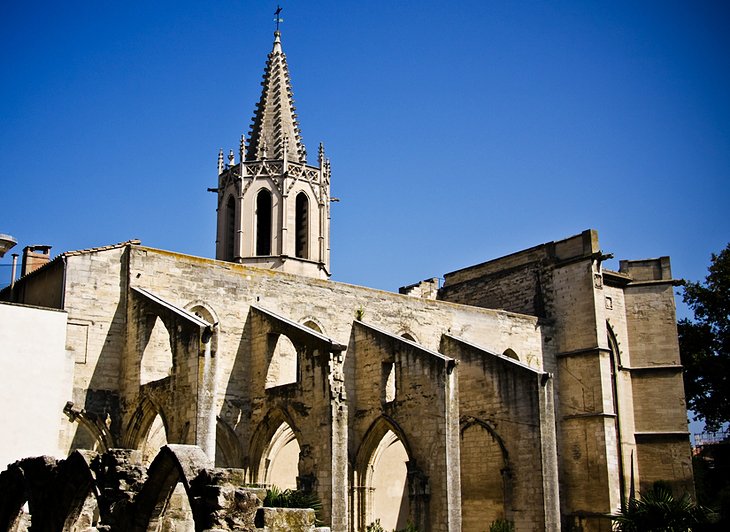
To the east of the Rue de la République stands the single-aisled Church of Saint-Didier.
Built between 1356 and 1359, the Saint-Didier Church exemplifies Provençal Romanesque architecture with its thick stone walls and large nave that gives the impression of an exceptional spaciousness.
This church contains one of France's earliest Renaissance works of art, the Way of the Cross, created between 1478 and 1481 by the Italian painter Francesco Laurana.
There are also remarkable 14th-century paintings such as the depiction of Christ's Crucifixion. Another noteworthy feature of this church is the Late Gothic pulpit with a flamboyant decoration style.
Address: Place Saint-Didier, Avignon
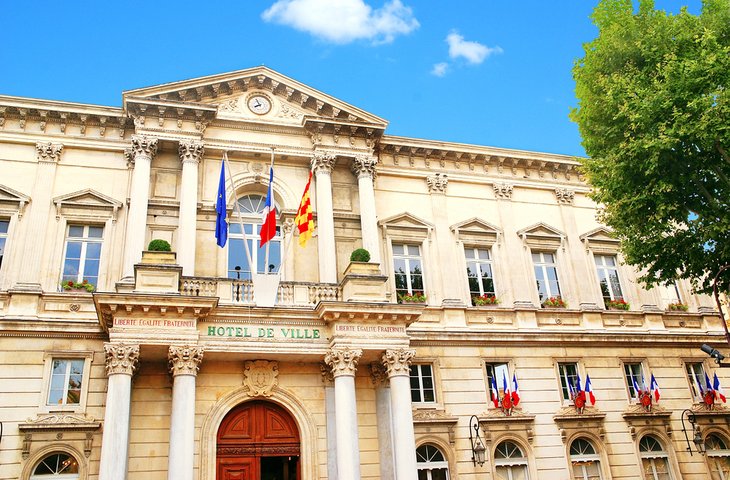
The idyllic Place de l'Horloge is a pleasant place to relax after a morning of sightseeing, at an outdoor café under the shady plane trees. Near the Palais des Papes, this beautiful square is the very center of Avignon life.
On the west side is the theater and the Hôtel de Ville (Town Hall). While the Hôtel de Ville was built in 1845, the building incorporates a charming 14th-century clock tower with life-sized figures on top, known as " jacquemarts ," that strike the hours.
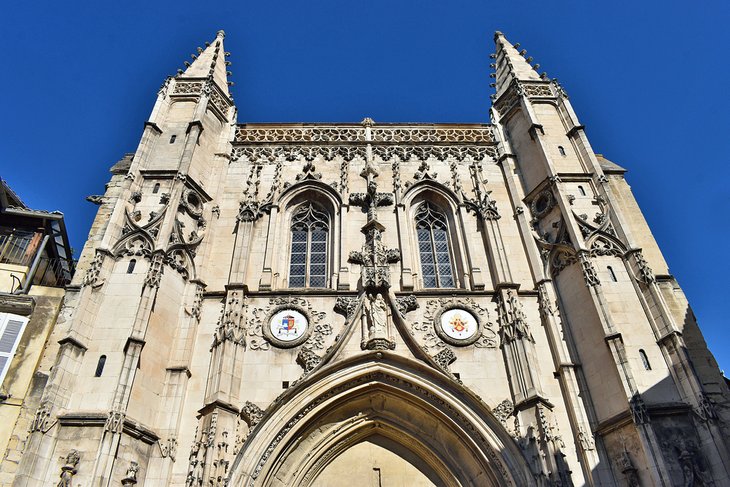
This site was dedicated to Saint Pierre of Luxembourg in the 7th century and the relics of the saint are kept here. Built in 1356, the Basilica of Saint-Pierre has a beautiful Gothic façade and carved Renaissance wooden doors dating from 1550.
The church houses several impressive sculptures, as well as paintings by Simon de Châlons, Parrocel, and Nicolas Mignard. There are also splendid Baroque choral scenes from the mid-17th century.
Classified as a Historic Monument , the Basilique Saint-Pierre is open to the public for visits daily year-round, free of charge.
Address: Place Saint-Pierre & Place des Châtaignes, Avignon
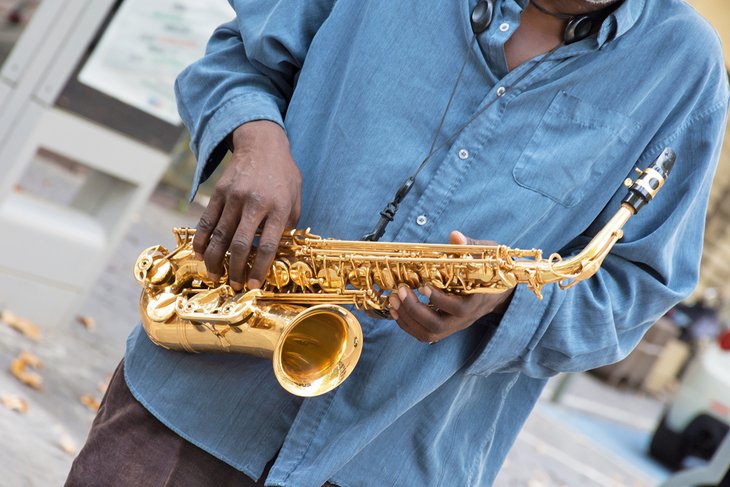
Avignon hosts dozens of cultural events and festivals throughout the year.
One of the biggest summertime events in Provence, the Festival d'Avignon presents a diverse cultural program that offers plenty of things to do, including theater productions, film screenings, dance performances, lectures, book readings, and workshops. The festival begins in early July and includes several events every day for over two weeks. Events are held at various indoor or outdoor venues throughout the city.
One of the most well-attended festivals is the Avignon Jazz Festival in late July and early August that takes place at the atmospheric Cloître des Carmes courtyard. This happening event is known as a "launching pad" for up-and-coming jazz musicians from all over Europe.
Other highlights of the cultural events calendar are the Agricultural Festival , which showcases products from farms of the region; the Médiévales des Carmes (a medieval festival that's free of charge) held on the second weekend of September; the Parcours de l'Art - Contemporary Art Festival in October; the Blues Rock Festival , in the nearby own of Châteaurenard, in October; and a Christmas market in December.
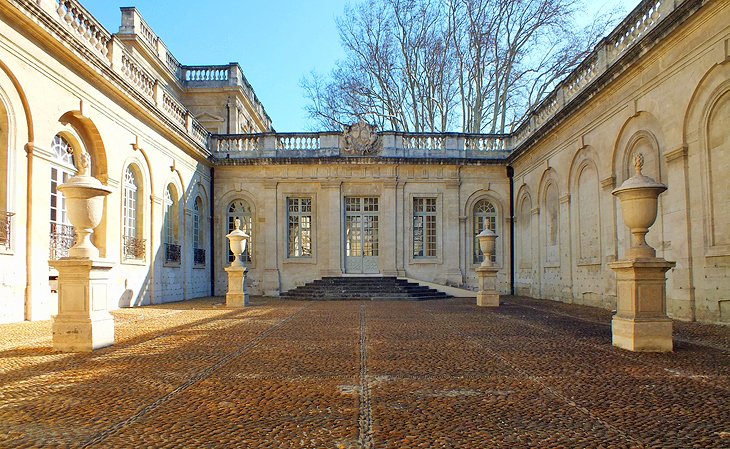
The Musée Calvet has a wonderful collection of antique sculptures, medieval paintings by Provençal masters, Italian paintings from the 16th to 19th centuries, French paintings from the 16th to the 20th centuries, as well as a selection of Spanish and Dutch works.
The museum began as the private collection of the doctor, a native of Avignon, Francois Esprit Calvet. Since 1833, the museum has been housed in the 18th-century Hôtel Villeneuve-Martignan near the Place de l'Horloge.
Address: 65 Rue Joseph Vernet, Avignon
Most tourists enjoy staying right in the historic center of Avignon, near the Palais des Papes and the Place de l'Horloge. Some of the more affordable hotels are near the railway station, about a 10-minute walk from the Place de l'Horloge. We recommend these highly rated hotels in Avignon:
Luxury Hotels:
- In an ideal location at the center of Avignon, the elegant five-star Hôtel d'Europe is a short walk from all the top attractions. The hotel occupies a renovated 16th-century mansion and has a Michelin-starred restaurant.
- La Mirande hotel has 26 exquisitely decorated rooms in a sumptuous 18th-century townhouse overlooking the Palais des Papes. This five-star hotel has a Michelin-starred fine-dining restaurant and a lounge where afternoon tea is served. Guests may choose to participate in the hotel's cooking classes.
- An upscale contemporary-style hotel, the four-star Hôtel de l'Horloge is steps away from the Place de l'Horloge, close to dozens of cafés and restaurants. Some of the guest rooms feature terraces.
Mid-Range Hotels:
- The Hôtel Garlande is found in a charming pedestrian area, at the center of Avignon, near the Eglise Saint-Didier. This three-star hotel occupies a renovated 18th-century building; guest rooms feature chic contemporary-style décor.
- The four-star Hôtel Mercure Pont d'Avignon Centre is about a five-minute walk from the Pont Saint Bénézet. The hotel's contemporary-style guest rooms are outfitted with flat screen televisions and coffeemakers.
- The cheerful rooms at the three-star Kyriad Avignon - Palais des Papes have pleasant views; some rooms overlook the Place de l'Horloge. Guests will appreciate the convenient location near many restaurants and cafés.
Budget Hotels:
- Mid-way between the train station and the Place de l'Horloge, the three-star Hôtel Central Avignon is a short walk away from the Palais des Papes. The hotel has a garden courtyard where breakfast is served.
- The Hôtel Le Colbert is tucked away on a quiet street between the railway station and the Place de l'Horloge. This two-star " hôtel de charme " features a shaded outdoor patio (where the continental breakfast is served) and quaint rooms but no elevator.
- The three-star ibis Avignon Centre Gare is just across from the Avignon train station and near the town's ancient ramparts. Guest rooms are compact but stylish and modern. Hotel amenities include a restaurant, 24-hour front desk reception, and a breakfast buffet.
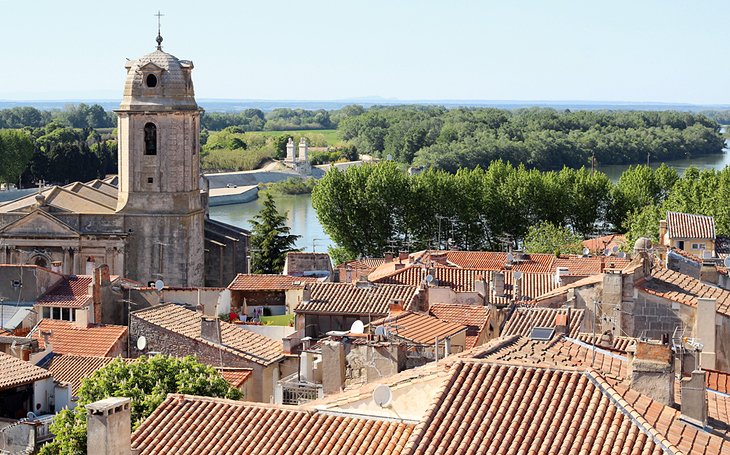
Only a 20-minute train ride from Avignon, Arles is a typical Provençal town, with a slow-paced lifestyle, pleasant outdoor cafés, and fascinating historic sites.
The highlights of Arles include a well-preserved 1st-century Roman Amphitheater and a UNESCO-listed Romanesque church.
For art lovers, the Fondation Vincent van Gogh is not to be missed, along with the Van Gogh Self-Guided Walking Tour , which identifies the landmarks captured in Vincent van Gogh's vivid brushstrokes.
Those who appreciate Vincent van Gogh's artwork will also enjoy the Van Gogh in Provence Small-Group Day Trip from Avignon . This unique tour stops at the sites in Arles and Saint-Rémy-de-Provence that are pictured in some of Van Gogh's most famous paintings.
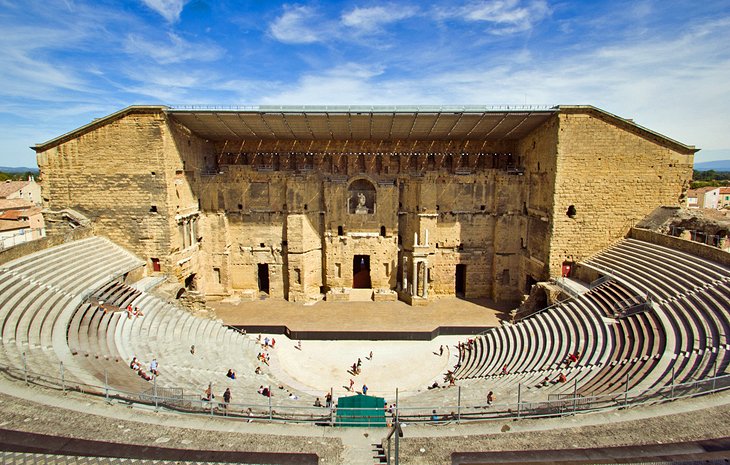
During ancient times, the area that is now Provence was home to a thriving Roman colony with bustling towns. Many of the Roman monuments have survived intact, such as the remarkable Roman Theater in the UNESCO-listed town of Orange that has seating for an audience of 7,000 people.
An array of well-preserved Roman monuments also await in Nîmes , a cultured town with an appealing old-world ambience. More fascinating archaeological sites are found in Vaison-la-Romaine : the remains of Roman porticoed houses, exquisitely detailed mosaics, and paved streets featuring gutters.
The sophistication of classical-era Roman civilization is perhaps best seen in the UNESCO-listed Pont du Gard aqueduct , a masterpiece of civil engineering that extended for 50 kilometers to supply water to the region.
The best way to see some of these amazing sites is by taking an organized tour. The Roman Sites Small-Group Day Trip takes travelers to the impressive ancient sites of Nîmes while sharing stories of Roman history and culture. This tour also stops at the UNESCO-listed Pont du Gard and the medieval town of Uzès, at the border of Provence in the Languedoc-Roussillon region .
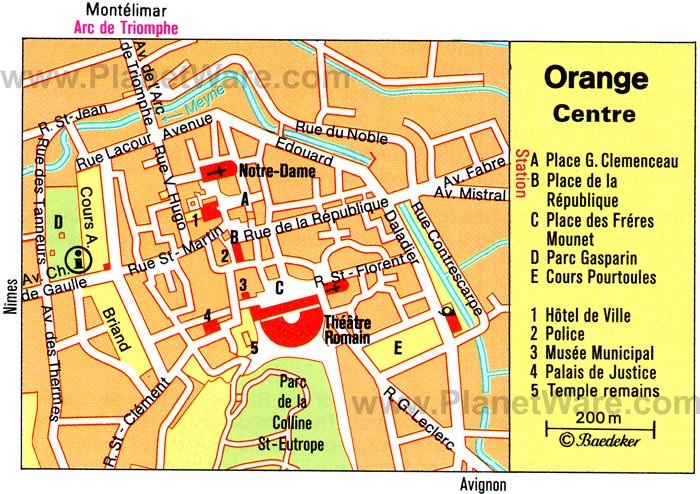
With its vibrant lavender fields and picturesque medieval hilltop villages, the Luberon is an appealing off-the-beaten-track destination in the Haut-Vaucluse area of Provence.
This idyllic rural area is protected as a UNESCO-listed nature reserve and is only accessible by car.
For an easy way to discover this lovely corner of Provence, take the Full-Day Highlights of Provence Tour from Avignon . This tour includes visits to the perched villages of Gordes and Roussillon, along with a stop at the spectacular fortified town of Les Baux de Provence.
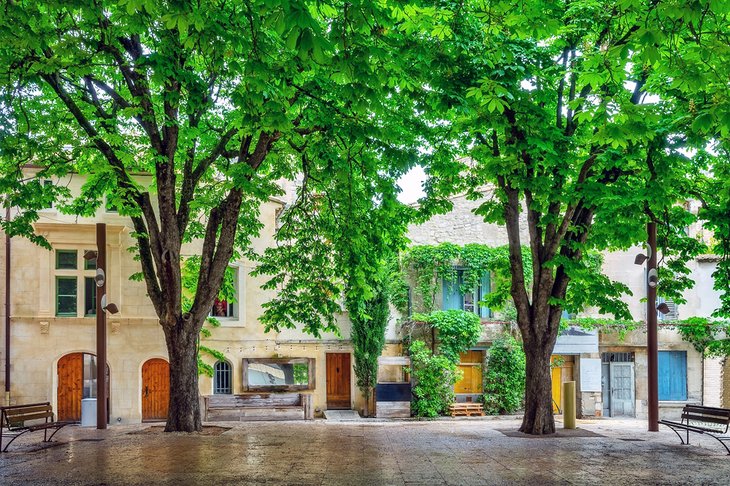
One of the sites that inspired Vincent van Gogh, Saint-Rémy de Provence is a characteristic Provençal village with elegant buildings, pleasant squares, and charming pedestrian streets.
About 20 kilometers south of Avignon in the northern foothills of the Alpilles, this village offers stunning views of the countryside.
Saint-Rémy de Provence is also well known for the Glanum Excavation Site where ruins from the ancient Graeco-Roman town are found. This extensive archaeological site includes the Monumental Gate from the 1st century BCE and a monument in memory of Julius Caesar.
Another famous person associated with the village is Nostradamus , who was born in Saint-Rémy in 1503. Admire the peaceful fountain that features a bust of Nostradamus.
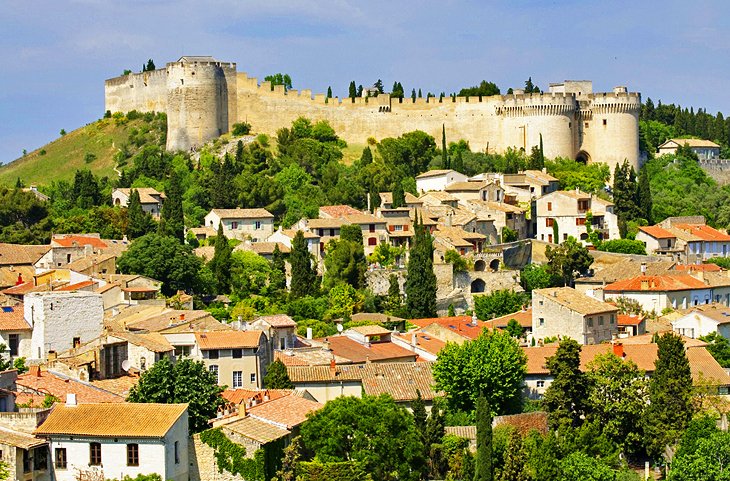
An easy 10-minute drive from Avignon, the village of Villeneuve-les-Avignon has a fascinating medieval fortress.
Built in the 13th and 14th centuries, the Fort Saint-André sits atop Mont Andaon and offers a magnificent view of Villeneuve, Avignon, Mont Ventoux, and the Lubéron and Alpilles mountain ranges.
The village also has an outstanding museum, the Musée Pierre-de-Luxembourg on the Rue de la Republique. One famous piece is the Coronation of the Virgin Mary , painted by Enguerrand Quarton in 1453. There are also noteworthy 17th-century paintings by great masters, including Philippe de Champaigne, Nicolas Mignard, and Reynaud Levieux.
Also worth visiting is the Chartreuse du Val de Bénédiction chapel built in 1352. The Gothic tomb of Pope Innocent VI lies within the chapel and a beautiful cloister adjoins the church.
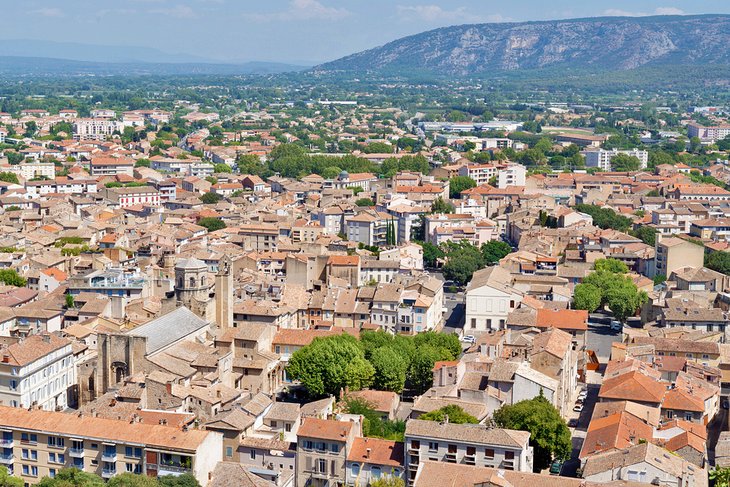
The little provincial town of Cavaillon has a rich cultural heritage, revealed in its remarkable historic monuments.
The Cathedral of Saint-Véran, founded around the 12th century, exemplifies Romanesque Provençal architecture. Its exterior is rather less attractive, but inside are lovely decorative capitals in the apse and a fine cloister.
Cavaillon also has a beautiful synagogue on the Rue Hébraïque (near Place Castil-Blaze) that is easily recognized by its arcades. Built in the Rococo style in 1772, the synagogue was later altered on many occasions. The synagogue now houses the Musée Juif Comtadin .
The Hôtel Dieu Archeological Museum on the Place Jean Bastide exhibits artifacts mainly from the Gallo-Roman period, along with Gallo-Greek antiquities and medieval items including a Merovingian altar-table. One room contains some interesting items of equipment from the old hospital dating from the 17th and 18th century.
A ticket to the Archeological Museum includes admission to the Judeo-Comtadin Museum in the historic synagogue on the Rue Hébraïque.
This sun-drenched town is surrounded by melon-growing farms. As would be expected, Cavaillon has a wonderful melon festival in early July.
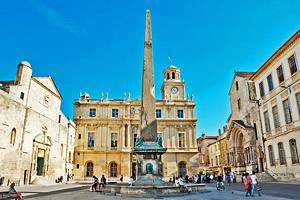
Highlights of Provence : Avignon is a great starting point to explore the many other interesting historic towns of Provence . The ancient ruins, leafy town squares, and outdoor cafés (painted by Van Gogh) of Arles are just 45 minutes away by train. Aix-en-Provence , another quintessential Provençal town, is one hour away by car or one hour and 30 minutes by train.
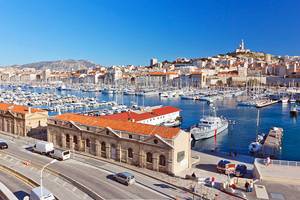
Seaside Splendor and Sunny Towns : The bustling seaport and cosmopolitan town of Marseilles is only 30 minutes away on the TGV fast train (or one hour by car). Many attractions near Marseilles are also worth a detour, such as the quaint fishing village of Cassis and the quintessentially Provençal town of Aix-en-Provence.
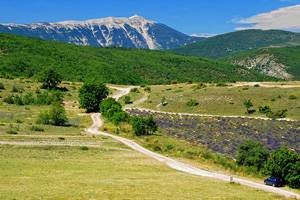
Charming Countryside : Travelers with more time will enjoy exploring the Lubéron area of Provence's Haut-Vaucluse countryside (about an hour's drive away), with its charming hilltop villages and picturesque landscape of rolling hills, valleys, and peaceful farmlands. The iconic Mont Ventoux in the Haut-Vaucluse is the highest mountain peak in Provence.
More on France

- Search Please fill out this field.
- Manage Your Subscription
- Give a Gift Subscription
- Newsletters
- Sweepstakes
- Destinations
How to Plan the Perfect Trip to Avignon, France
This enchanting French city is home to a historic palace, delicious food, and one of the oldest hotels in the country.
Lindsay Cohn is a writer, editor, and avid traveler who has visited 45 countries across six continents — and counting. She contributes to Travel + Leisure, Hotels Above Par, InsideHook, Well+Good, The Zoe Report, and more.
:max_bytes(150000):strip_icc():format(webp)/Lindsay-Cohn-8b22fb2d452f46f5a256755f4d0f42a5.jpeg)
A must-visit on any trip to the south of France , Avignon oozes history and culture. Set on the Rhône river, it’s best known for the enormous Palais des Papes (Popes' Palace), which reflects its pinnacle as the seat of the Catholic papacy in the 14th century. However, the ever-enchanting city actually dates back to Roman times and also possesses plenty of other photogenic attractions such as Rocher des Doms and Pont Saint-Bénézet.
A delicious destination to say the least, it’s home to a storied Provençal market, as well as many superb restaurants, from haute French dining to neighborhood bistros. Character-rich accommodations also await travelers after sightseeing and savoring. With direct trains from Paris, many travelers use Avignon as a springboard to explore the rest of Provence. But it’s certainly worth spending a few days here.
Gatsi/Getty Images
To help you plan the perfect trip to Avignon, we tapped three travel experts who also happen to be full-blown Francophiles to get the inside scoop on the best things to do in the capital of the Vaucluse department.
Top 5 Can’t Miss
- Visit the massive Palais des Papes (Popes' Palace) for a glimpse into the city’s papal history.
- Get a taste of local life at Les Halles d'Avignon.
- Snooze in classical French style at Hôtel La Mirande.
- Sample Provençal cuisine at a Michelin-rated restaurant or a cozy corner bistro.
- Sip and swirl world-class red wine in nearby Chateauneuf-du-Pape.
Christophe Bielsa
Best Hotels and Resorts
Hôtel la mirande.
Located right next to the Palais des Papes, Hôtel La Mirande is a five-star respite with a lovely atmosphere and rooms decorated in classical French style. “I love the underground space for cooking classes and private dinners ... as well as the cozy fireside bar for afternoon tea in the winter,” says Florence Gaudin, product manager at French Side Travel and on-the-ground guide partner for Black Tomato .
Auberge de Cassagne & Spa
For a refuge that’s just a short drive outside the city center, set your sights on Auberge de Cassagne & Spa . “A gorgeous Provençal house-turned-hotel with 35 impeccably decorated rooms, excellent spa facilities, a superb fine-dining restaurant, and beautiful gardens, it really feels like a luxury countryside retreat and is always a winner with our most discerning clients,” says Graham Carter, co-founder of Unforgettable Travel Company and leading France specialist.
La Divine Comédie
“My go-to suggestion for travelers who want a boutique stay that’s right in the heart of Avignon, La Divine Comédie took nearly seven years to rebuild,” says Carter. “Gilles, a stylist from Paris, and his partner, Amaury, converted a derelict building into a beautiful five-key, homestay-style property.” Each bedroom is individually styled and full of character with dozens of hand-picked art pieces and decorative accents.
Hotel d'Europe
One of the oldest hotels in France, Hotel d'Europe traces its roots back to the 16th century. Since then, it has been lovingly refurbished, but still retains a timelessness and enduring sense of regality. Travelers remark about the genuine hospitality and sophisticated decor. The shaded terrace is a lovely spot for a cocktail during the warmer months. And you can’t beat the location, just steps from the old city walls and Palais des Papes.
Buena Vista Images/Getty Images
Best Things to Do
Palais des papes.
Surrounded by medieval stone ramparts, the Palais des Papes (Popes' Palace) is a fortress and palace that served as the papal residence for most of the 14th century. Whether you’re interested in the religious or historical aspects of the UNESCO-listed site, it’s worth visiting to see one of the most emblematic landmarks in all of France.
Les Halles d'Avignon
A great place to get a taste of local life, Les Halles d'Avignon is a historic indoor market with many vendors selling traditional local products. Jason Susinski, director of product for Kensington Tours and Provence expert, encourages visitors to browse the selection of fresh produce, meats, cheeses, seafood, and baked goods. It also has a lovely vertical garden and cafes to stop for a coffee break in between shopping.
Oleg Anisimov/500px/Getty Images
Musée du Petit Palais
While most of the tourist attention focuses squarely on the Palais des Papes, it’s far from the only cultural attraction worth checking out in Avignon. First opened in 1976, Musée du Petit Palais boasts an impressive collection of Renaissance paintings, from local papals to those brought by Italian clergy.
Rocher des Doms
Lace up your hiking boots (though sneakers will certainly suffice) and get outside to soak in the panoramic views from Rocher des Doms, a peaceful park with gardens, fountains, and a privileged vantage point overlooking the city, river, and famous Pont Saint-Bénézet.
Châteauneuf-du-Pape
While there’s lots to do in Avignon itself, fans of old-world vin won’t want to miss the chance to sip and swirl the nectar of the gods on a day trip to nearby Châteauneuf-du-Pape (about 25 minutes away). One of the most well-known wine regions in all of France , it’s famous for producing top-quality reds and brims with many charming vineyards for tastings.
trabantos/Getty Images
Best Restaurants
Hiély lucullus.
One of the best restaurants in Avignon, Hiély Lucullus blends the cuisines of Provence and Peru in a deliciously creative way. The flavors and soul of both places come to life through tasting menus. Because it’s popular and books out so far in advance, Carter recommends securing a reservation well ahead of your trip.
Fou de Fafa
Looking for something a bit more laid-back that’s still guaranteed to be memorable and downright delicious? Fou de Fafa never disappoints. It’s casual and inviting, with homespun charm, elegant dishes, and a lovely terrace for an alfresco dinner.
Another resplendent option for lunch or dinner, and a favorite of Gaudin's, Avenio treats patrons to delectable plates like a goat cheese tart with smoked duck breast and an herb-crusted baked cod that channels the legacy of Provençal cuisine while bringing something new to the table. The setting is chic and modern yet relaxed. Not surprisingly, the tables book up fast.
La Fourchette
La Fourchette is an elegant neighborhood bistro serving traditional recipes like smoked haddock salad, curry fried oysters, and ratatouille made with seasonal ingredients. Photographs, books, and wood inject the space with heaps of warmth and personality.
Foodies and history buffs both flock to Sevin in equal measure. Set in a medieval residence next door to the Palais des Papes, it’s a historic gem for contemporary eats. If the weather and availability allow, try to snag a table on the terrace. And don’t forget to peruse the wonderful wine list.
Aleh Varanishcha/Getty Images
Best Time to Visit
While many travelers pack Avignon into a summer Provence itinerary, Gaudin is partial to the months of May, June, September, and October because of the great weather (it’s less hot than peak summer). Plus, you still get the advantage of long, sunny days to roam and explore. March and April tend to be quiet — with the exception of the week leading up to Easter — so it’s a good option if you’re looking to avoid the crowds and save a few bucks.
How to Get There
High-speed, direct trains run from Paris to Avignon throughout the day. The journey takes about two hours and 30 minutes and costs $62. You can easily pick up a rental car from Sixt at the Avignon TGV train station (Gare d'Avignon TGV) to explore beyond the city, too. International flights also land at Marseille Provence Airport (MRS), which is about 90 minutes away.
anamejia18/Getty Images
How to Get Around
It’s easy to navigate Avignon on foot. With so much to see and do in the surrounding countryside of Provence — from wineries and olive oil mills to lavender fields and medieval villages — Susinski recommends arranging a private guided tour to gain entry into some local experiences or renting a car to explore at your leisure.
Related Articles
Avignon travel guide

Visit Avignon (Provence-Alpes-Côte d'Azur, France)
Avignon is a historic town on the Rhone river in Provence, and a beautifully preserved medieval town surrounded by the original fortified city walls. The part of Avignon that is of most interest to visitors falls inside the fortifications and is called the intra-muros quarter, and the bridge (the Pont d'Avignon) which is just outside the walls.
The central historical part of the city, including the Palace of the Popes, the Saint-Benezet bridge, and the fortification walls that surround the city, is now a protected UNESCO heritage site and Avignon is also listed as one of the French 'secteur sauvegardé' towns (see Historic towns of France ).
Exploring Avignon
France This Way review: we recommend you allow two or three days to visit Avignon. Although you could perhaps visit the principal monuments in the town in a one day visit, you will discover there is a lot to enjoy and you will also want to spend time in one or two cafes and restaurants!
There is much more to Avignon than famous sites, and during a visit you will see a wealth of beautiful buildings, historical churches, a fine collection of museums, several gardens, an extensive pedestrianised historic center, and lots of cafes and bars.

The heart of Avignon for visitors has the Palais des Papes and the Place de l'Horloge to the north, the Pont d'Avignon just outside the city walls to the north-west of the Palace, and the main historic centre in the streets around the Palace and the Rue de la Republique, which is a long boulevard to the south of the Place de l'Horloge.
Many visitors will start a visit in the Place de l'Horloge and the large open area in front of the Pope's Palace, but note that the main Avignon Tourist Office is at the southern end of Rue de la Republique, several hundred metres south of the Place de l'Horloge, and has a great deal of useful information and maps to help you make the most of your visit - so we would also make that a priority! Among these are three suggested routes to explore the centre:
- the Promenade des Papes, that explores the streets around the Palais des Papes, the Pont Saint-Bénezet and the Rocher des Dome Park: an indispensable route that takes about an hour (excluding entry to the two monuments)
- the Promenade of the Museums and Townhouses, in the Place de l'Horloge and the streets such as Rue Joseph Vernet and the Rue des Fourbisseurs to the east and west of the Rue de la Republique, a route that takes about two hours (excluding entry to the museums)
- the Promenade "Au fil des Rues d'Antan", in the eastern part of the historic centre of Avignon, exploring the less visited part of the town and taking about three hours
Our own favourite regions in the centre of Avignon are the streets around Rue Joseph Vernet in the north-west of the historic centre, and the pedestrian area to the west of the Rue de la Republique and around the Church of Saint-Didier.
Place de l'Horloge and Place du Palais
The centre of the town for 500 years, this open square has the town hall dominating one side, with the 19th century theatre next door. Although the town hall was built in the 19th century, it incorporates the original clock-tower in its construction.
The square has been extensively remodelled over the centuries and took its present form at the end of the 19th century after earlier market buildings had been cleared away to make a more open space. As well as being surrounded by attractive buildings you will also find numerous restaurants here in the shade of the plane trees around the edges of the square: although these are not typically the highest quality restaurants in the town they are in a lovely location.
Adjacent to the north corner of the Place de l'Horloge is the main square in front of the Pope's Palace, the Place du Palais. As well as the Palais des Papes, you can also see the imposing Museum of the Petit Palais and the Conservatory of Music in this square.
Palace of the Popes (Palais des Papes)
One of the most important gothic buildings in Europe, the Palais des Papes is also one of the most impressive buildings in Europe. The size and grandeur of the palace can't be seen from a photo, but it is very large and dominates the square in front of the palace - which allows a clear view of the whole building.

Avignon was home to the popes from 1309 - 1377 and they built the palace while in exile here. Following centuries of neglect, misuse and attack the Palace has now been renovated and is finding a new lease of life as a tourist attraction. Guided tours will show you many of the highlights and chapels etc within the palace. The Palace is enormous, and comprises an 'old palace' and a 'new palace'. There are numerous gothic towers and splendours in the palace.
The interior of the Palace of the Popes is now much more austere than it would have been in days gone by. Although some effort has been made to recreate / renovate some of the original features e.g. the walls in the Pope's bedroom, the interior is still very barren. Nevertheless it remains a fascinating experience to pass through the great rooms where such important matters of state and politics were debated and plots were hatched.
The smaller, grassed inner courtyard is a highlight of the visit, as is the extraordinary chapel, 52 metres long, which forms part of the 'new palace', various frescoes and a grand staircase. Art exhibitions of a high quality are often held in the vast rooms of the palace.
See also Popes Palace for visitor information.
Advertisement
Pont d'Avignon (Pont St Benezet)
Not far from the Pope's Palace is the famous Pont d'Avignon, well known around the world because of the nursery rhyme about the bridge. Constructed in the 12th century, only 4 of the 22 original sections of this bridge now remain - the bridge was frequently damaged by the Rhone flooding and by war, and repairs were often made until the 17th century at which time efforts to maintain the bridge were finally abandoned.
The author of the famous song "Sur le Pont d'Avignon" is unknown. Interestingly, the original version was "Sous le pont d'Avignon" ('Under the bridge...") rather than "Sur le Pont d'Avignon" ("On the bridge...") and referred to the dancing on the island below - Island Barthelasse. The bridge no longer reaches the island.
France This Way review: because of it's fame visitors all want to see the Pont Saint-Benezet but in our opinion it was the one disappointment of a visit to Avignon: a road now passes under the bridge and to be honest we have seen lots of bridges elsewhere in France that are much more scenic and more interesting.
See article about the Pont d'Avignon

Rocher des Doms Gardens
The Rocher des Doms Park and gardens is up a grand sweeping entrance to the side of the cathedral (left of the Palace of Popes) and is a large English style gardens with various water features and views back across the city and the Rhone River. This is a good place to go if you are getting hot and bothered on the streets of Avignon!
Avignon Museums
There are many interesting museums in Avignon - for these see separate article about the Museums of Avignon
Pedestrian centre and shopping in Avignon
The main shopping region is partly pedestrianised and found around the bottom of the Place de l'Horloge east of the Rue de la Republique where there are numerous boutiques, shops and art galleries etc.
For 'high-street' shops follow the Rue de la Republique straight down from the bottom of the Place de l'Horloge. This long straight boulevard continues right to the edge of town and the railway station, and is lined with lots of impressive 19th century buildings (it was in the 1850's that rail opened to Marseille and Nice, bringing prosperity to the town). The Avignon tourist office is also along this road.
In these streets you will find more impressive churches (such as the Church of Saint-Pierre and the Church of Saint-Didier) and monuments - there are numerous features and things of interest to discover as you simply amble around Avignon, even if we don't list them all here!
Attractions nearby
A short distance north of Avignon you can visit the pretty village of Chateauneuf-du-Pape , now best known for the wines produced in the region but originally developed around a castle built by the popes in exile.
A visit to Avignon is ideally combined with trips to the other important historic towns in this region such as Arles , Nimes and Orange , as well as a visit to the most beautiful villages of the Luberon region to the east of here.
You can find more travel ideas in the Vaucluse guide and the Provence guide .
See also Find Avignon hotels
Photos of Avignon
Click any picture to start the gallery

Arrange a visit to Avignon
Book hotels, car hire and flights.
- Book a visit
Hotels in Avignon
Booking.com: best prices
See Avignon hotels

Reserve excursions
Map of avignon and places nearby, visit near avignon with france this way reviews.

Papal Palace, Avignon
The Papal Palace in Avignon is the most imposing gothic palace in Europe

Avignon Bridge
The Pont Saint-Benezet is the remaining part of the bridge on the Rhone in Avignon that was immortalised in the nursery rhyme 'Sur le pont d'Avignon'

Villeneuve-les-Avignon
Losing out in visitor numbers to famous Avignon across the river, in Villeneuve-lès-Avignon you will also find several places and sights that are interesting

Chateauneuf-du-Pape
Chateauneuf-du-Pape is a pretty village in Vaucluse, overlooked by a ruined castle and well known for the wines produced nearby

Saint-Laurent-des-Arbres
Saint-Laurent-des-Arbres is a small historic village with several imposing historic monuments in the Gard department

Saint-Remy-de-Provence
The historic monuments here are a testament to St-Remy-de-Provence's claim to be one of the oldest towns in France, and the time that Van Gogh spent here is also celebrated
... or see ALL recommended places to visit in Vaucluse
Tourist classifications for Avignon
Avignon is classified as a historical protected town centre' (secteur sauvegardé)
Address: Avignon, Provence, 84000, France || GPS coordinates: latitude 43.948, longitude 4.8059
Plan your visit to Avignon, Vaucluse
Sightseeing & tourist attractions to visit nearby.
- Avignon Centre : heritage site
- Notre-Dame-de-Bon-Repos de Montfavet (Avignon): religious monument
- Villeneuve-les-Avignon : secteur sauvegarde
- Fort Saint-Andre: national monument (2 km)
- Jardin du château de Brantes: remarkable garden (9 km)
- Jardin aquatique « Aux fleurs de l'eau: remarkable garden (11 km)
- Glanum: national monument (18 km)
- Beaucaire : recommended detour (20 km)
- Pernes-les-Fontaines : recommended detour (21 km)
- Orange Roman Theatre : heritage site (21 km)
- Pont du Gard : grand site of france (22 km)
- Carpentras : town of art and history (23 km)
Market days in Avignon, France
Regular market(s) are held in Avignon each every day except Monday. (Markets are held in the morning unless stated.)
The French version of this page is at Avignon (Francais)
French Places
We can help you visit any town, village or region of France...
Popular & Useful
① Ideas & inspiration ② Maps of France ③ Explore by region ④ Route planner ⑤ Places (by dept.)
France This Way copyright 2006 - 2024
- Cookies & privacy
- Index of places
- Practical Information
- Discover the Little Train & Open Tour Itineraries
- The 19 highlights
- Contact & Booking
- FR • EN
VISITE AVIGNON by Lieutaud
AVIGNON, AS YOU HAVE NEVER SEEN IT
VISITE AVIGNON invites you to discover the cities of Avignon and Villeneuve les Avignon in a tourist Train and an open-top bus, the Open tour.
A city tour with thrilling, fun and bucolic itineraries, with a 1 day ticket and more than 19 incredible points linking the Kingdom with the Papal city through the island of la Barthelasse.
A combined ticket (Open tour + Train) will allow you to enjoy the intimate wealth of the city centre of Avignon, the majesty of the river and discover Villeneuve-les-Avignon, a voyage through time…
The comments of these two itineraries are available in 10 languages to which is added a comment especially written and designed for children (in French only).
TOURIST TRAIN
The tourist Train offers an unforgettable tour within the heart of the city of the Popes, allowing you to discover its most beautiful sites: the Palace of the Popes, a UNESCO World Heritage site, the Rocher des Doms, its medieval streets, its picturesque areas and of course the famous bridge, le Pont d’Avignon.
Become regal at the top of our open-top coaches, your hair blowing in the wind… Our double-deckers will ensure you a beautiful discovery of Avignon and Villeneuve-les-Avignon. A pleasant and varied itinerary to admire the city of the Popes and its surrounding treasures: The Palace of the Popes, the famous bridge of Avignon, “on y dance, on y dance…”, but also its cardinal liveries, its abbeys, a fort, its towers, ramparts and, if you listen carefully, the murmur of plays… the Rhone and the green setting of the island of la Barthelasse will offer you a natural and relaxing break… and if you wish to, you can continue your visit by bike!
We wish you a very nice ride!
FROM AVIGNON TO VILLENEUVE
TAKE A STROLL FOR 24 HOURS ALONG THE 19 HIGHLIGHTS

Inscrivez-vous à la newsletter
Abonnez-vous à notre lettre d'information pour recevoir nos dernières actualités.
Vous avez été inscrit avec succès !

Things to do in Avignon
Discover the places and activities not to be missed

Avignon, the Popes’ city Looking for a picturesque, vibrant, and historically rich destination in France? Look no further than Avignon! Nestled in the heart of Provence, this enchanting city is a must-visit for travelers seeking an unforgettable experience. With its breathtaking architecture, charming cobblestone streets, Avignon is a true gem waiting to be explored.
- Pont d’Avignon
The Popes’ Palace
Doms garden, on the other side of the rhône.
From the iconic Palais des Papes, a UNESCO World Heritage site, to the vibrant local markets bursting with aromas of fresh produce and fragrant herbs, Avignon offers a unique blend of culture, art, and gastronomy. Immerse yourself in the vibrant atmosphere of the Avignon Festival, the largest theater and performing arts event in the world, or wander through the quaint streets, discovering hidden cafes and boutique shops. Whether you’re a history buff, a food enthusiast, or simply seeking a romantic getaway, Avignon is sure to captivate your senses and leave you longing for more.
Pont d’Avignon
As the famous French song goes… “on y danse, on y danse”… But there’s so much more to discover! The world-famous Pont d’Avignon, or Pont Saint-Bénézet , is often the starting point for exploring the city’s historic centre. Although today it no longer joins the two banks of the Rhône, the bridge offers a pretty view of the city of Avignon and the Rocher des Doms. A great chance to snap some photos of the Popes’ Palace before venturing into the old town!
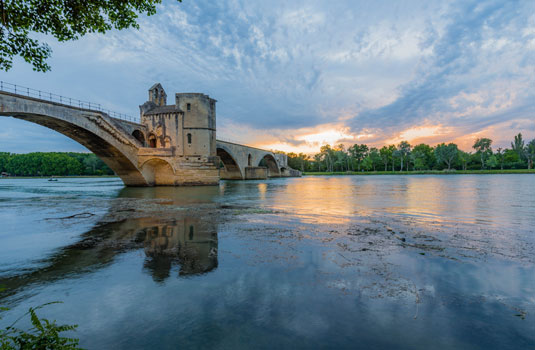
Did you know?
The Pont d’Avignon received the “Tourisme et Handicap” label (recognition of reliability and quality of tourist service to disabled persons) in 2016.
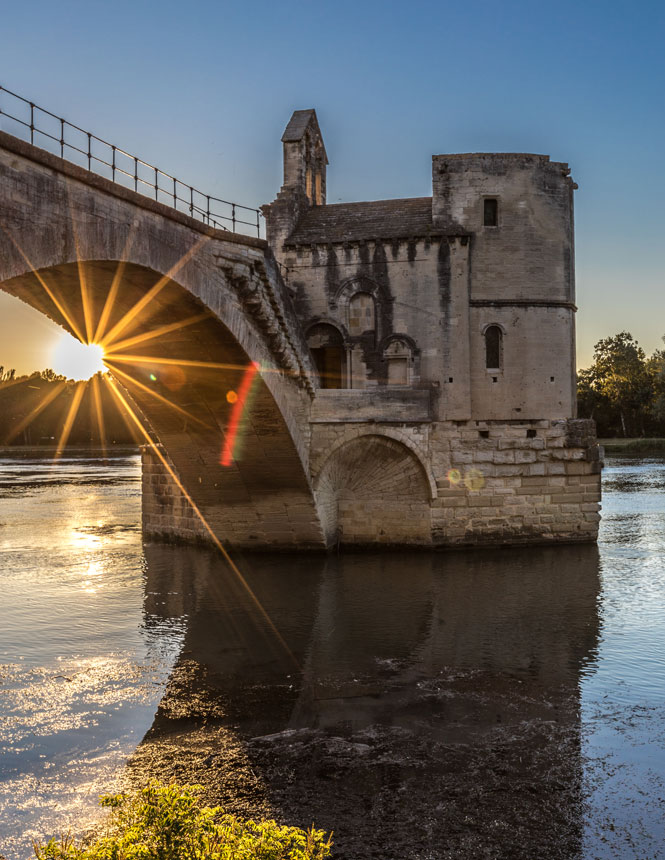
It’s impossible to talk about Avignon without mentioning the celebrated Popes’ Palace, listed as UNESCO World Heritage site
Given the Palace’s colossal size, looming over the town, it’s perhaps no surprise that this is the biggest gothic palace in the world. Definitely a must-see! Once inside the Palace, choose between a themed guided tour or freely wander around, accompanied by a digital tablet so you don’t miss anything! From the Pope’s private apartments to the frescos painted by the artist Matteo Giovannetti, the Popes’ Palace is an immense playground for lovers of architecture and history.

Firm favourite
Relive the grandeur of the Popes’ Palace thanks to the Histopad – an augmented reality tablet – included in the price of each ticket!
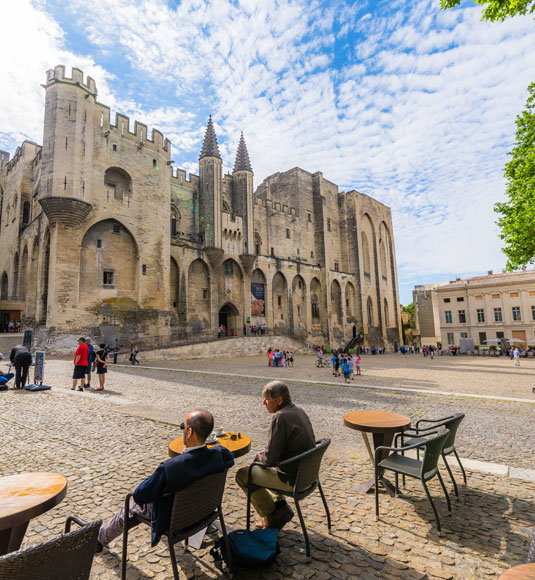
With more than 600,000 visitors per year, the Popes’ Palace is one of the 10 most visited monuments in France. An unmissable part of Avignon!
An ideal place for a stroll, go to the Doms Garden to recharge your batteries and take a refreshing break on hot summer days.
At the weekend, go for a walk as a family, as a couple, whether you’re particularly sporty or you simply want to admire the landscapes. Several spots offer a magnificent view over the surroundings, from the Rhône plain up to Mont Ventoux – it is a beautiful Provençal scene! Another great idea is to stroll around the side of the lake – children will be amazed by the swans and carps and will surely want to stop and have a look, ice cream in hand!
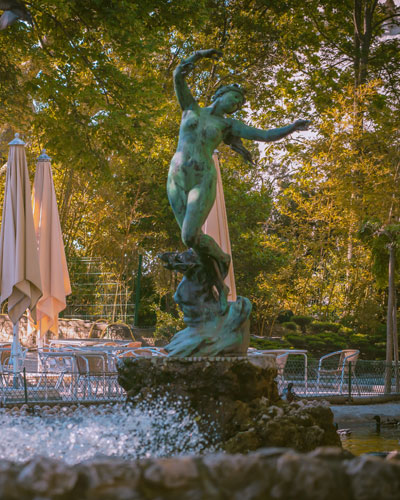
Take the little train to get to Doms Garden – even the journey up to the garden is a lovely experience which will delight both children and parents.
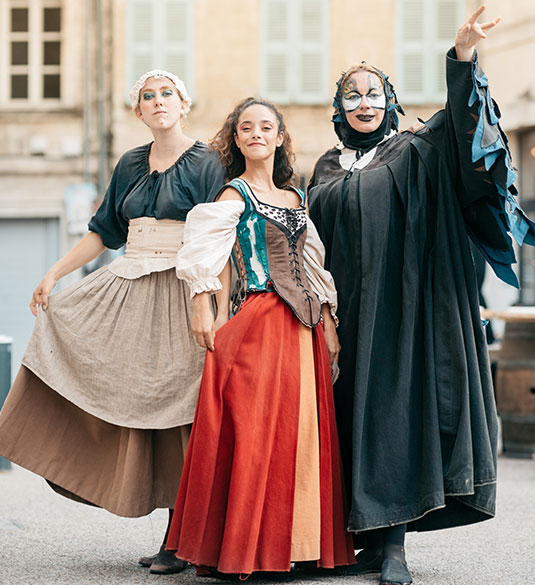
The festival d’Avignon
One city, 2 festivals, more than 1,000 performances.
Since 1947, the world of theatre and live performance has come together in Provence for 3 weeks every July. The city becomes one big stage – from pavements to cinemas, from gardens to the main courtyard of the Popes’ Palace – a whirlwind of colours, languages, and styles. African dance mixing with Chinese theatre, renowned literary authors mingling with contemporary comedians… It’s clear that the Avignon Festival is one of a kind!
By crossing the bridge which spans the Rhône (Daladier, not the Pont d’Avignon, as you may have realised…) the day continues in Villeneuve-lès-Avignon, a medieval-looking village with an impressive, dominant fort on the Mont Andaon. Only a few kilometres from Avignon, this military architectural masterpiece boasts a stunning view of the Mont Ventoux, the Alpilles and the Luberon. Further down – in the heart of the village – is La Chartreuse. Founded by Pope Innocent VI, today this is a cultural centre and artists’ residence which welcomes visitors curious to discover the monastic atmosphere in the cloisters, the 40 cells and the chapel.
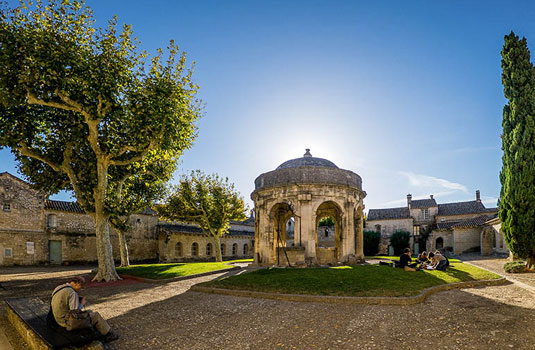
Another unmissable gem: the Abbey of Saint-André and its gardens, which boast a fantastic view over the Popes’ Palace and the Rhône valley. These romantic gardens are home to a range of different areas: tuscan-style flowerbeds, a one-hundred-year-old olive grove, panoramic patios…
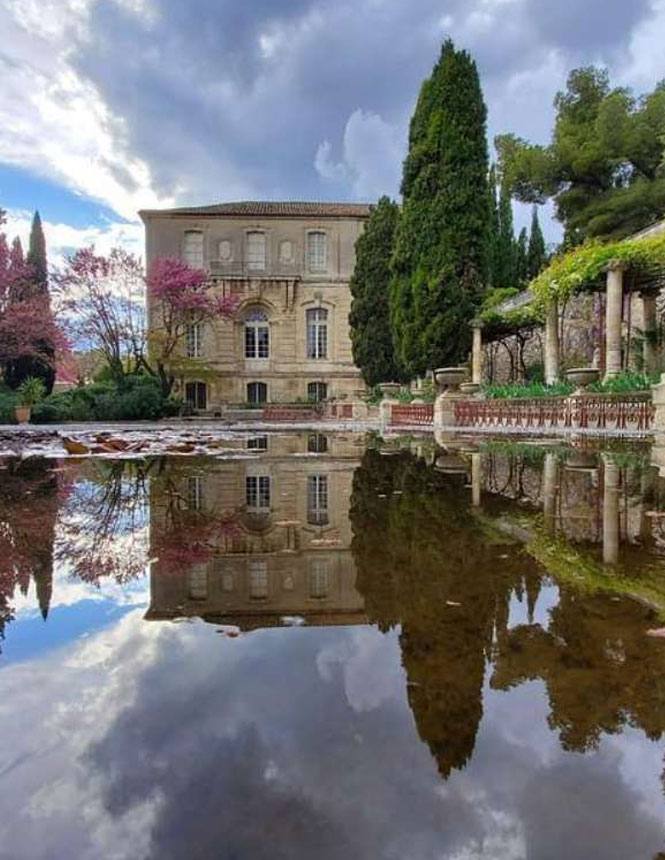
Outdoor activities in Avignon and surrounding areas
Avignon’s natural surroundings offer ample opportunities for outdoor activities and exploration.
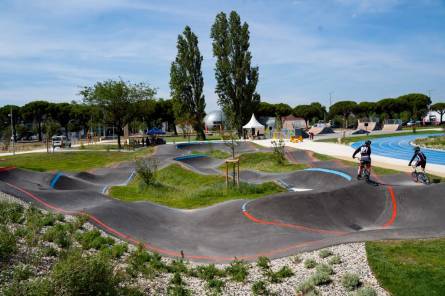
Pumptrack de la Plaine des sports Avignon
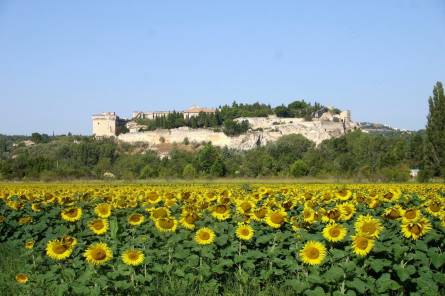
La Rive droite du Rhône-balade à vélo-50 Villeneuve-lez-Avignon

L’Île de la Barthelasse-balade à vélo-4 Avignon
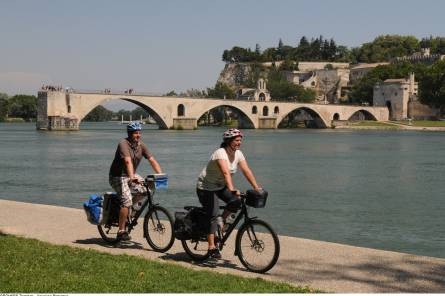
Bike ride on Barthelasse Island – Countryside in the city Avignon
Itinerary ideas.
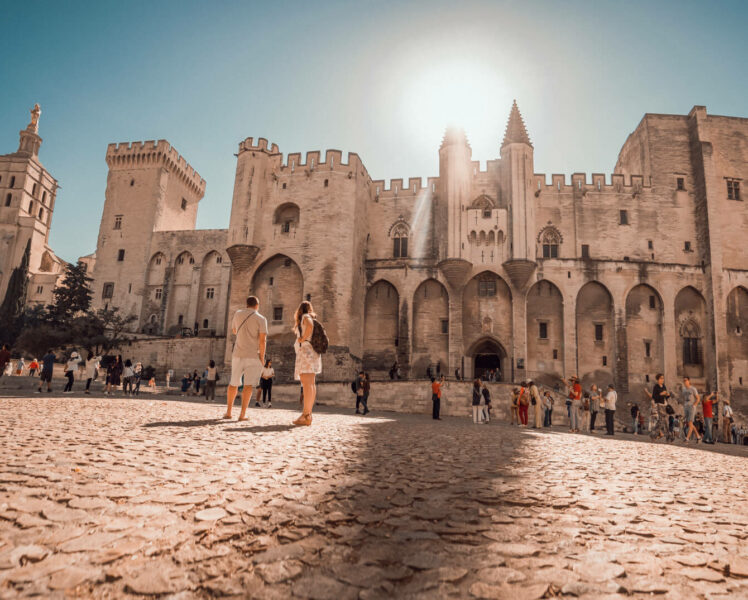
Avignon in the time of the Popes
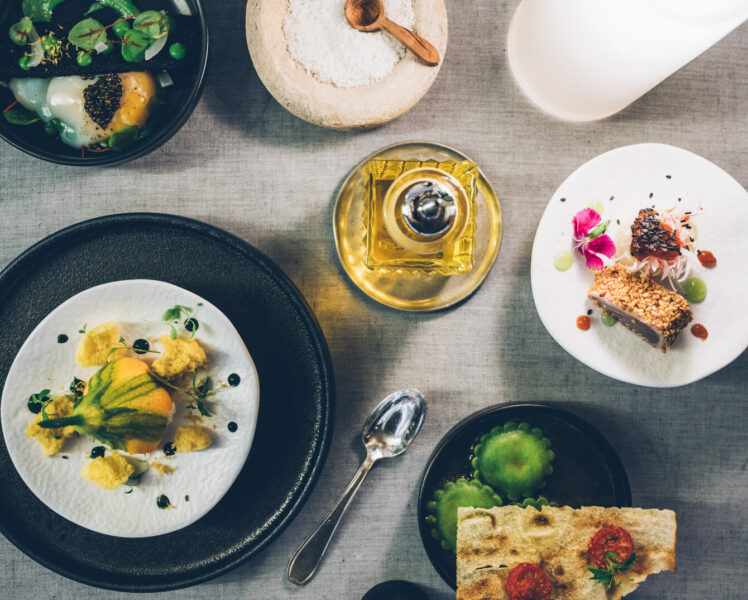
Avignon for food lovers
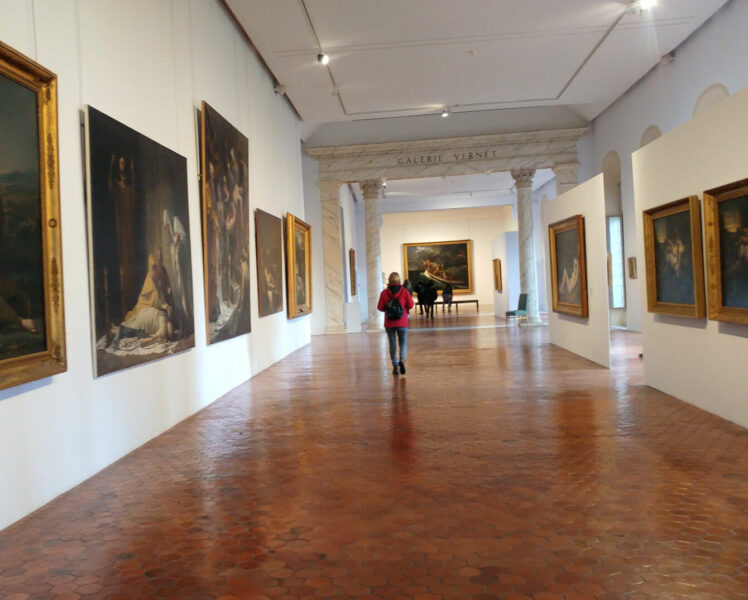
The cultural side of Avignon
Planning your visit to avignon.
When planning your visit to Avignon, it’s important to consider the best time to go. The summer months of June to August are the peak tourist season, with warm weather and a bustling atmosphere. However, these months can also be crowded, so if you prefer a quieter experience, consider visiting in the shoulder seasons of spring or fall. Avignon is well-connected by train, making it easy to reach from major cities in France. Once you arrive, the city is compact and easily walkable, making it convenient to explore on foot. There are also several options for accommodation, ranging from luxury hotels to budget-friendly guesthouses. Whether you’re planning a short weekend getaway or a longer stay, Avignon is sure to enchant you with its beauty and charm.
Practical information
Access Direct TGV (high-speed train) to Avignon from – Paris Gare de Lyon by TGV (2 hours 38 mins) – Roissy Charles de Gaulle by TGV – Lille– Nantes – Rennes – Strasbourg – Nice – Geneva (3 hours) – London by Eurostar (6 hours) More information: www.sncf-connect.com Prepare your journey: www.thetrainline.com
Paid parkings: Parking du Palais des Papes , parking des Halles et parking Jean Jaurès Free parkings: île Piot , Parking des italiens
Public transport Orizo is the public transport company in Avignon ORIZO Shop Avenue de Lattre de Tassigny 84000 AVIGNON – 04 32 74 18 32 Monday to Friday 8am to 12:30pm and 1:30pm to 6pm and Saturday 9am to 12pm
The Pont d’Avignon through the seasons
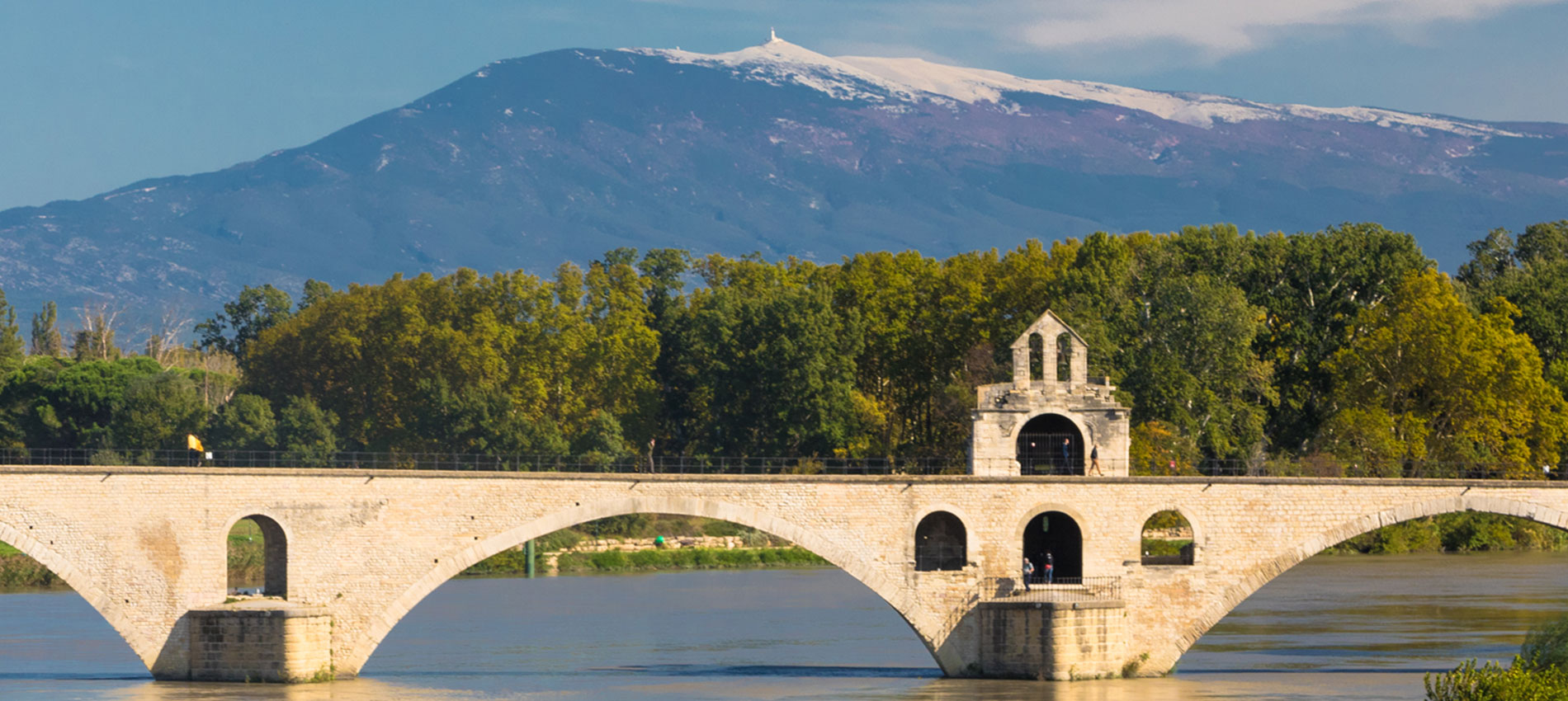

Home » Travel Guides » France » 15 Best Things to Do in Avignon (France)
15 Best Things to Do in Avignon (France)
In the 14th century Avignon was the most important city in Europe: It was the seat of the Catholic church, represented in spectacular style by the Palais des Papes, the largest gothic building in the world.
This period furnished Avignon with a glorious cityscape of gothic and renaissance buildings that today are protected as a UNESCO site. The Pont Saint-Bénézet for example has a special place in French culture, while there’s also an assortment of art and history museums that will keep inquiring minds enthralled for days.
Lets explore the best things to do in Avignon :
1. Palais des Papes

You can’t comprehend the scale of the 14th-century Papal Palace until you see it in real life.
Just to trying to convey the size, you could fit four gothic cathedrals in here and there are 24 rooms to visit on the tour.
It’s the marquee attraction in Avignon’s World Heritage site and one of France’s most famous and valuable historical buildings.
Get the audio-guide for the full story, and pause in the papal apartments with walls adorned with frescoes painted almost 700 years ago by the gothic artist Matteo Giovanetti.
2. Pont Saint-Bénézet

Known to all as the Pont d’Avignon, the mythic bridge is from the late-12th century, linking France with Papal Territory.
It was positioned on the tightest part of the bend in the Rhône to lessen its exposure to the river’s notorious strong currents.
Originally there were 22 arches, of which four remain today, and the bridge was 915 metres long, sensational dimensions for the time it was built.
Over the next few hundred years the bridge was damaged and rebuilt by flooding, until finally a catastrophic flood in the 17th century carried off most of the arches.
What remains is beautiful though, and you can visit the gatehouse that defended the crossing, the stranded western terminal, the Tour Philippe-le-Bel and the Chapel of St. Nicholas above the second arch.
3. Place du Palais

The wide open space that sets off the Papal Palace isn’t here by accident.
It was laid out by the antipope Benedict XII in the early 15th century, when the winding streets around the palace were razed to enhance the grandeur of the structure.
On the square you’ve got the perfect view of the palace, as well as the renaissance Petit Palais, Avignon’s romanesque cathedral and the Hôtel des Monnaies (mint), which was renovated in the baroque style in 1619.
4. Collection Lambert

Collection Lambert is one of Avignon’s newer art museums and was founded in 2000 by the art dealer Yvon Lambert as a space to display the works he had donated to the French government.
The galleries are set across two marvellous 18th century Hôtels.
The museum expanded dramatically in 2009 when Lambert made another donation of 560 pieces, the largest gift of art to France since Picasso’s posthumous donation in the 1970s.
The art on show is contemporary, with photography, video, paintings and sculpture from the 1980s up to the last few years from the likes of Cy Twombly, Anselm Kiefer and Nile Toroni.
Temporary shows are put on in the Hôtel de Caumont, while the Hôtel de Montfaucon has the permanent collection.
5. Place de l’Horloge

Avignon’s main square is where you’ll find the city hall and opera house.
Place de l’Horloge is named after the Avignon’s gothic clock tower, but this can actually be quite tough to spot on the square as it’s hidden behind the newer neoclassical city hall buildings.
In the summer nearly half of Place de l’Horloge is taken up by rows of seating for the line of restaurants that spans the entire length of the square.
There’s a carousel for kids, while in December the Christmas mark is held in front of the city hall.
But the ideal time to be here is in July when public performances for the OFF theatre festival take place under the square’s plane trees.
6. Basilique Saint-Pierre d’Avignon

Local folklore has it that this church’s predecessor was destroyed by the moors in the 7th century.
The current gothic building was started in the 1300s during the papacy of Innocent IV, who was the fifth Avignon Pope.
Before you enter, take a little time to appreciate the monumental wooden tours, sculpted from walnut in 1551by Antoine Volard.
There’s a trove of art to see inside too, like the gilded choir from the 1700s, renaissance and baroque paintings, as well as the 15th-century relics of Saint-Pierre de Luxembourg, with his actual cardinal’s robes and hat.
7. Petite Train

If you don’t mind everybody knowing you’re a tourist, Avignon’s road train is a useful way to see the main sights but also get your bearings in a city that can be puzzling for first-timers.
It will take around 40 minutes and covers the famous bridge, the picturesque streets and neighbourhoods around the centre, the Rocher des Doms on the left bank of the Rhône and, naturally, the Palais des Papes.
The train is a particular favourite with older visitors, families with toddlers and anyone with limited time on their hands.
8. Île de la Barthelasse

At 700 hectares the Île de la Barthelasse is one of Europe’s largest river islands.
It belongs to Avignon and is connected to the city by the Pont Daladier, although you might find it more fitting to catch the free ferry across the Rhône.
The island is mostly peaceful orchards with only clusters of houses because a few times every century there’s a catastrophic flood.
The highest point of the island is just 18 metres; it’s what makes the Île de la Barthelasse vulnerable to inundation, but so enjoyable to discover on two wheels.
Hire a bike in the summer and bring a picnic to while away a few hours on the banks of the Rhône.
9. Musée Calvet

Open to the public for more than 200 years the Calvet Museum was founded after the local doctor and collector Esprit Calvet donated his art, library and cabinet of curiosities to the city of Avignon.
This diverse collection has since been expanded by donations from a host of patrons, and contains ancient archaeology, fine art, a wide array of decorative art and ethnological artefacts from Oceania, Asia and Africa.
There’s a serious amount of interesting stuff to get through, but the part many come to see is the Egyptology department with a sarcophagus, canopic jar and offering table.
10. Rue des Teinturiers

This old street traces the Vaucluse Canal and is painfully cute.
Rue des Teinturiers was the intense centre of Avignon’s silk spinning and dyeing industry from the 1300s up to the 1800s.
There are still charming clues in the form of four water-wheels mills suspended from the embankment next to the water.
The beautiful stone houses on the other side of the canal are linked to the cobblestone street by little bridges, and the whole route is shaded by tall old plane trees.
Look out for the Maison du IV de Chiffre, one of Avignon’s oldest mansions, as well as the home Jean-Henri Fabre, the revered 19th-century entomologist, at no. 14.
11. Musée du Petit Palais

Part of the same ensemble as the Palais des Papes is a smaller renaissance palace on the north side of the square.
If it looks a bit like a fortress that’s because it had been a citadel during the Western Schism that followed the Avignon Papacy.
The palace has barely changed since the start of the 1500s, when the future Pope Julius II revamped the building and added his coat of arms to the south facade, still visible above the entrance.
The Petit Palais is just the right building for 327 paintings and 600 sculptures by Italian and French artists from the gothic and renaissance periods.
Nearly all were commissioned for churches around Avignon, many from the 14th century during the Avignon Papacy.
12. Musée Angladon

Jacques Doucet was a Parisian tailor active at the turn of the century and regarded as one of the pioneers of fashion design.
During his lifetime he amassed an immense art collection, including world-famous pieces like Picasso’s Demoiselles d’Avignon, displayed as New York’s MoMA. Doucet’s heirs founded this museum in a fabulous early-18th-century mansion in the middle of Avignon to exhibit the remainder of Doucet’s paintings.
So you can revel in the palatial setting as you view works by Degas, Sisley, Cézanne, Picasso, Manet, Derain and Modigliani, as well as the only van Gogh painting hanging in Provence.
13. Avignon Les Halles

Every morning from Tuesday to Sunday some 40 merchants set up their stalls at this superb covered market on Place Pie.
If you’re renting an apartment you needn’t look any further for your food shop: There’s seasonal meat, fish, fruit and veg, as well as wine, olive oil, herbs, cheese and charcuterie from around the region.
Amateur cooks need to make sure they’re here on Saturdays as this is when the market welcomes prominent local chefs to its designated exhibition space.
You can watch them work as they put on cooking demonstrations and if you’re lucky you’ll get to taste their creations.
14. Pont du Gard

What could be Roman Gaul’s most photogenic ruin is 25 kilometres to the west of the city.
The Pont du Gard is magnificent, but it’s astonishing to think that it’s just a fragment of a system that once spanned 50 kilometres, descending just 17 metres on its route from Uzès to Nîmes.
What’s more it was made in just five years.
The 275-metre-long, 50-metre-high section built to cross the Gardon River has astounded people for two millennia, and you’d be remiss not to see it if you’re in Avignon.
On the site is a compact museum of Roman history with kid-friendly displays, and a video explaining how this work of ancient engineering was undertaken.
15. Les Baux de Provence

Just 30 kilometres south of Avignon, tucked in the magical countryside Alpilles, Les Baux de Provence is one of the “most beautiful villages in France”. It’s a tiny hillside settlement of houses bunched together on steep slopes, dwarfed by large slabs of limestone rock.
Even higher is the Château des Baux, a ruined fortress built in the 900s, promising a fun time for kids with its full-size recreations of siege engines.
They’ve got the largest trebuchet in Europe, flinging missiles all day long in summer.
Also local is the Carrières de Lumières, a multimedia art experience with the iconic works of a chosen artist (in 2016 it was Chagall) projected onto the high faces of a former quarry.
15 Best Things to Do in Avignon (France):
- Palais des Papes
- Pont Saint-Bénézet
- Place du Palais
- Collection Lambert
- Place de l'Horloge
- Basilique Saint-Pierre d'Avignon
- Petite Train
- Île de la Barthelasse
- Musée Calvet
- Rue des Teinturiers
- Musée du Petit Palais
- Musée Angladon
- Avignon Les Halles
- Pont du Gard
- Les Baux de Provence

- Destinations
Avignon Travel Guide
Nestled along the Rhone River and only a quick 2.5-hour train ride from Paris, Avignon is the perfect city to begin your journey through Provence, one of France's most sought-after regions. While the main attraction of Avignon is the papal palace towering over the town, there is plenty of history, art, and theater to appreciate in this prosperous city. Its famed indoor market is open year-round and is a sure way to experience the local food culture. — Delisa and Marcin Zak
- Terms of Use
- Privacy Policy
- Your US State Privacy Rights
- Children's Online Privacy Policy
- Interest-Based Ads
- About Nielsen Measurement
- Do Not Sell or Share My Personal Information
- Nat Geo Home
- Attend a Live Event
- Book a Trip
- Inspire Your Kids
- Shop Nat Geo
- Visit the D.C. Museum
- Learn About Our Impact
- Support Our Mission
- Advertise With Us
- Customer Service
- Renew Subscription
- Manage Your Subscription
- Work at Nat Geo
- Sign Up for Our Newsletters
- Contribute to Protect the Planet
Copyright © 1996-2015 National Geographic Society Copyright © 2015-2024 National Geographic Partners, LLC. All rights reserved
Guide to the Top Attractions in Avignon, France
Overview of avignon.
A landmark from across the lavender fields of Provence , the imposing Pope’s Palace stands at the north end of the walled city. Towering above the mighty Rhône, the fourth longest river in France, Avignon was the home of the papacy from 1309 to 1377. Seven French popes ruled the Catholic world at a time when Italy was too dangerous. Between 1334 and 1352, they built this wonderful, extraordinary and rich structure. The largest Gothic palace in the world, it served both as fortress and palace. It’s made up of two buildings: the Palais Vieux (Old Palace) to the north and the Palace Neuf (New Palace) to the south.
Allow 4 hours to wander through the courtyards that lead to the magnificent collection of small and large rooms. Their uses were diverse and necessary for what was a mini city within a city: rooms to store arms and armour, or the copious gold and silver that kept the Papacy going; banqueting halls decorated with tapestries to eat and drink in; chapels to pray in; bedchambers to sleep in, audience chambers to impress both secular and religious visitors, and terraces to admire the view from.
The UNESCO World Heritage Site is very well organized with audio guides in different languages, films and multi-media points to show you the life of the past.
There’s also a good behind-the-scenes tour, called the Secret Palace, that takes you to areas you might not see and includes interpretation in French and English.
During the summer, the walls of the palace are lit up with Les Luminessences D’Avignon . The sound and light show takes you back to the past in a pretty spectacular way and is well worth booking .
The Petit Palace Museum
The Petit Palais was bought by the pope in 1335 as a house but neglected then renovated in the 15 th century. Used as a lodging for important visitors (the likes of Cesare Borgia in 1498, Francis 1 in 1533, and the Duke of Orleans in 1660), today it's the Musée du Petit Palais . The delightful palace is a museum full of treasures: Romanesque and Gothic sculpture, and the Campana collection, which shows Italian paintings from the 13 th to the 16 th centuries.
Walk past the art and you can see how perspective and realism developed from the Siennese School of the early period to the Renaissance. Paintings and sculpture from the Avignon School of the 15 th century can also be viewed here.
Walking Tours of the Old Town of Avignon
Old Avignon stretches around the imposing Palais des Papes. Pick up a map from the Tourist Office and set off along the narrow cobbled streets which fill the old town, protected originally by the circular ramparts. This is a picture-perfect medieval and Renaissance town. Don’t miss King René’s house in the rue Roi-René; the rue des Teinturiers which follows the river Sorgue, providing the waters needed by the 18 th and 19 th century calico cloth–dyers who lived here; the Quartier de la Balance that runs down to the Pont Bénézet, and the Place de l’Horloge, a vast square shaded by trees with the theatre, town hall and numerous pavement cafes to while away the hours.
Stroll a little further to the 15 th -century Palace du Roure for the gateway and courtyard which you can walk into. If you're there on a Tuesday at 3pm, take the guided tour which takes you into the rooms of Provençal costumes and textiles, old photographs of the Camargue and more.
The Famous Pont St-Bénézet, Bridge of Avignon
The iconic, instantly-recognizable Pont St-Bénézet was built in the 12 th century, according to legend, by a young shepherd boy after receiving a message to do just that by an angel. Whatever its origins, the bridge became the only crossing point on the all-important Rhône between Lyon and the Mediterranean. The arched bridge survived until the 17 th century and remains today one of the great symbols of the attractive city. It’s famous for the children’s song Sur le Pont d’Avignon , though it was never big enough to dance across.
But it was a great feat of engineering, which you can appreciate today in the new museum displays, films and interactive media that shows how the bridge changed over the centuries.
Musée Calvet
Esprit Calvet (1728-1810) was a successful physician who left his considerable collections to a foundation that today runs different museums and institutions in Avignon.
Housed in a beautiful 18 th -century neo-classical palace, the Calvet Museum starts with the ancient world and particularly 4 th -century BC stelae, upright stones carved with faces. Sculptures, silverware, and faience (tin-glazed ceramicware) sit alongside French, Italian and Flemish paintings from the 16 th to the 19 th century.
Rocher des Doms Park
You’ll find this lovely park, an oasis of green peace, north of the Palais des Papes. Climb up past the manicured lawns and tinkling fountains to the hilltop for a fabulous view over the city and the river. Directly below you, the gilded Madonna gleams on the tower of the Cathedral Notre-Dame-des-Doms in front of the Pope’s Palace. Buy everything for a picnic in the Halles Market Place and sit eating charcuterie and cheese, fresh bread and pates overlooking the glorious stone city laid out below.
Markets and Special Shopping in Avignon
Avignon has a good selection of shops and some of those great south of France markets .
The modern covered market, Les Halles in place Pie, is the place for serious food shopping. 40 different stalls sell the local produce of Provence from Tuesday to Sunday, 6am to 1pm.
Make for the Place des Carmes for the flower market on Saturday mornings, and the flea market on Sundays. From June to September the 3 rd Monday of each month in the Allées de l'Oulle , a specialist food market brings smaller producers to the city.
The weekends mean numerous food markets on St-Michel and place Crillon .
Specialist Shopping
Start with chocolates at one of the best chocolatiers, Puyricard, which has branches all over the south of France. In Avignon, the shop is at 33 rue Joseph Vernet, tel: 00 33 (0)4 90 85 96 33.
If you're in Provence, lookout for those brightly-colored, classic textiles. Try Les Indiennes de Nîmes , Mistral at 9 rue des Fourbisseurs, tel: 00 (9) 81 44 90 24 for a good selection.
Antiques, including old pottery and Provencal furniture and kitchenware, are on display at Herve Baume , 19 Rue de la Petite Fusterie, tel: 00 33 (0)4 90 86 37 66.
For everything lavender, that most Provencal of plants, make your way to Lavande & Co , 61 Rue Grande Fusterie, tel: 00 33 (0)4 90 14 70 05.
Avignon Festival and Events
Of all the events that this lively city puts on, the Avignon Festival is the best known, both nationally and around the world. It was started in 1947 by the actor-director Jean Vilar whose aim was to bring theatre to the masses with top actors like Jean Negroni and Jeanne Moreau. Held each year in July, the now 3-week-long event takes over the main courtyard of the Pope’s Palace which can hold up to 2000 spectators. It’s a truly international event with over 40 different performances of theatre, dance, and music as well as fine arts exhibitions throughout the city. Companies from around the world perform works from Euripides to Chekhov, Shakespeare to Mikhaïl Boulgakov.
There’s also a fringe-style festival called Avignon Public Off which takes over 100 smaller locations. There are free performances in the place de l’Horloge.
Other don't-miss events include the Avignon Blues Festival in October with musicians from New Orleans to London and Paris.
The annual Christmas Market takes over the central streets with craft stands, musical performances, folk dancers and creche scenes and figurines.
3-Day tour in and around fabulous Nice
The 10 Best Things to Do in Provence in the South of France
The Top 15 UNESCO World Heritage Sites in France
Arles, France Travel Guide | Provence
Top French Wine Tours, Regions and Wine Routes
Bourges Cathedral, Hotels and Restaurants
Viking River Cruises and Portraits of Southern France Itinerary
Images of Provence - Provence, France Picture Gallery
Provence Map and Illustrated Travel Guide
Best Markets in Provence and the South of France
Top 20 Most Popular French Cities for International Visitors
The 15 Best Things to Do in Strasbourg, France
The 9 Best Day Trips From Marseille, France
32 Top Things to Do in Paris, France
The 8 Best Day Trips From Lyon, France
Guide to Nimes in the south of France
France Travel Blog
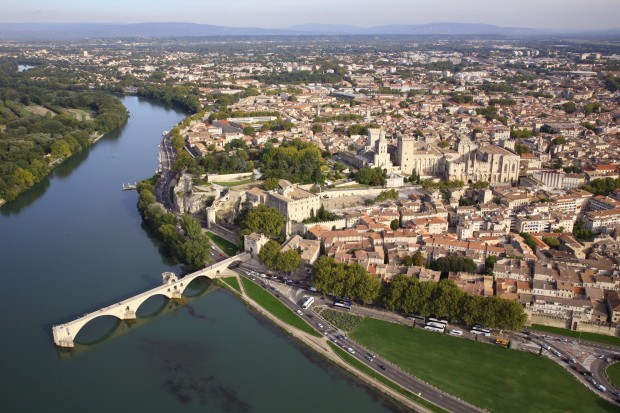
Avignon Travel Guide
Famous for its walls, among other things, the Avignon is located in south-central France in the region of Provence. The city used to be the seat of the papacy for about 67 years. Today, it is one of France’s leading tourist destinations and home to some of the most brilliant museums and splendid architecture. Place de l’Horloge is the city’s central square while the Pope’s palace is another attention-grabbing landmark. Avignon is one of the great French cities and I hope that this travel guide will help you explore it.
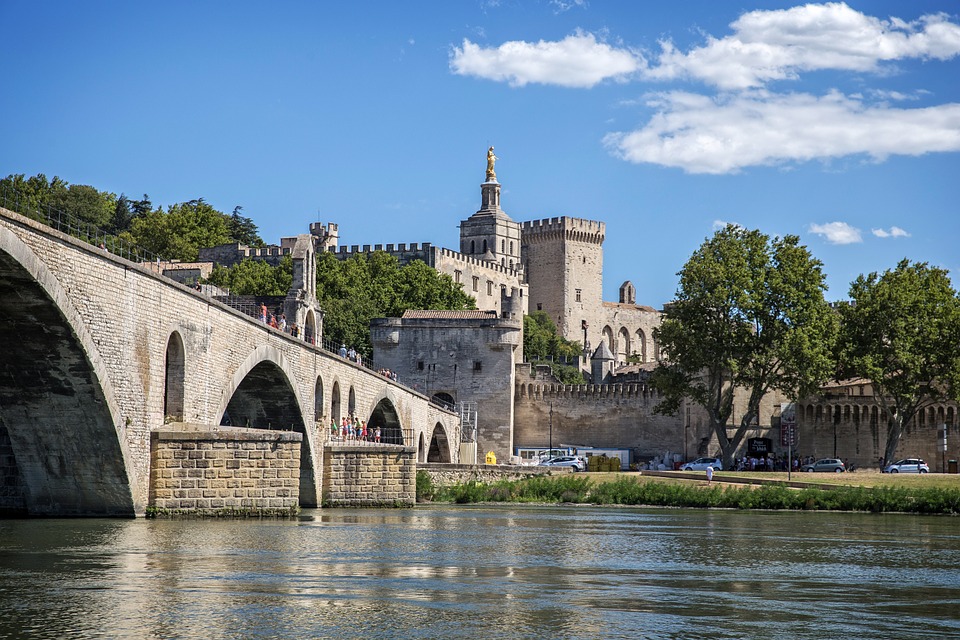
Towering above the majestic Rhône river, Avignon was the home of the pope from 1309 to 1377 as seven popes ruled the Catholic world when Italy was deemed highly unsafe. Between 1334 and 1335, this vast and rich structure was built as it is revered as the largest Gothic palace in the world. It served as both a fortress and palace.
Here is a Detailed Travel Guide on What to See and Do in the city of Avignon:
Avignon’s museums offer a tremendous array of collections. Be lost in the world of prehistory at the Musée Lapidaire (Lapidary Museum). There you will discover paintings from the Middle Ages at the Petit Palais museum. Fine arts at the Musée Calvet. The impressionists at Angladon. Decorative arts at Musée Louis Vouland (Louis Vouland Museum) and modern art at the Collection Lambert.
The city also has a well-known theatre festival, as it is the host for contemporary works in the performing arts. Also, Avignon is an essential center for culinary peculiar to the Provence region. Illustrious chefs prepare local and innovative menus in alluring restaurants throughout the city. And you can have a great time on a wine tour as the city is the capital of the Côtes-du-Rhône wines, as you relish every taste.
Accommodation
Throughout the city are fascinating attractions that will remind you of how beautiful France is. And although there are many good hotels in Avignon, they get quickly booked-up when the summer tourist season begins.
How to get there
Avignon is easy to travel to by train from Marseille, Paris, and other European cities. And although it does have its own airport, lots of visitors arrive through the Marseille Provence airport.
Palais des Papes
You cannot apprehend the scale of the 14th-century Papal Palace unless you see it in real life. In trying to describe the size; you could fit four gothic cathedrals in there, and it has 24 rooms to visit on the tour. The Palais des Papes is the biggest attraction in Avignon’s World Heritage site and one of France’s most popular and priceless historical buildings.
You can secure an audio-guide for the full story, and pause in the papal apartments with walls decorated with frescoes paints almost 700years ago by the gothic artist Matteo Giovanetti.
Musée du Petit Palais (The Petit Palace Museum)
Among the cast as the Palais des Papes is a smaller renaissance palace on the square’s north side. It slightly has the likeness of a fortress because it used to be a citadel during the Western Schism that trailed the Avignon Papacy. As you will see, the palace has hardly changed since the beginning of the 16th-century; when the future Pope Julius II furbished up the building and added his coat of arms to the south façade.
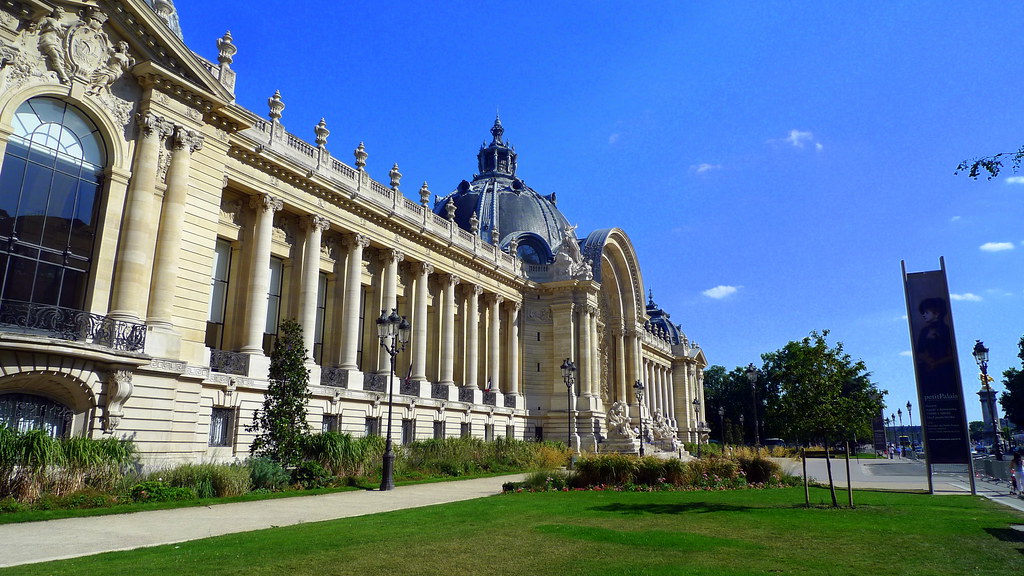
The museum houses about 337 paintings and 600 sculptures by Italian and French artists from the gothic and renaissance eras. The pope bought it in 1335 as a house, and it was used as a lodge for distinguished visitors (like Cesare Borgia in 1948, Francis I in 1533, and the Duke of Orleans in 1660). Strolling past the art, you will see how specific art movements developed from the Siennese School of the early period to the Renaissance developed. And if you are a lover of 15th-century European arts, there are lots to see here; from paintings to sculpture.
Old Town of Avignon
Walking tours can be breathtaking, especially when you stroll in a group. It is always pleasant to navigate a historical place as you see engaging, attractive spots. Walking in the old Avignon can be everything, and that could be the height of your tourist’s adventure. The old Avignon extends around the imposing Palais des Papes. And you can pick a map before setting off along the narrow cobbled streets which fill the old town. It used to be secured by the circular wall as you will see.
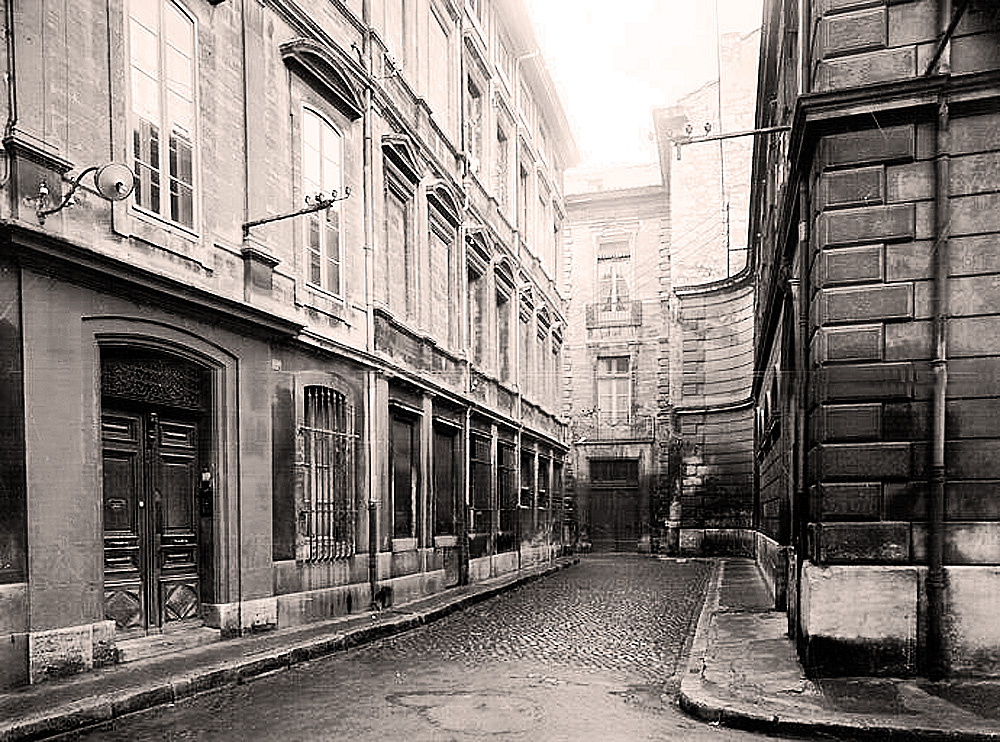
Do not miss King René’s house in the rue Roi- René. The rue des Teinteuriers which follows the river Sorgue, offering the waters that the 18th and 19th-century cloth dryers who lived there needed. Do not forget the Quartier de la Balance that flows to the Pont Bénézet, and the Place de l’Horloge, an enormous square shaded by trees with theatre, town hall, and many pavement cafes. You can also walk a little further to the 15th-century Palace du Roure for the courtyard and gateway that you can visit.
Rocher des Doms Park
How about a trip to adore nature? You will find this fantastic park, an oasis of green peace, north of the Palais des Papes. Find your way past the well-mowed lawn and fountains to the summit for a fantastic view of Avignon and the river. Just below you is the embellished Madonna gleams on the tower of the Cathedral Notre-Doms in front of the Pope’s Palace. You can get everything you need for a picnic in the Halles Market Place. It is comfortably poised while you eat some cheese, fresh bread, with some wine; overlooking the shining city below.
Petit Train
If you do not mind everyone staring at you as a tourist (not in a weird way though), the road train is a handy way to see the city’s landmarks. Also, that will help you find your way around a city that can be confusing for some visitors.
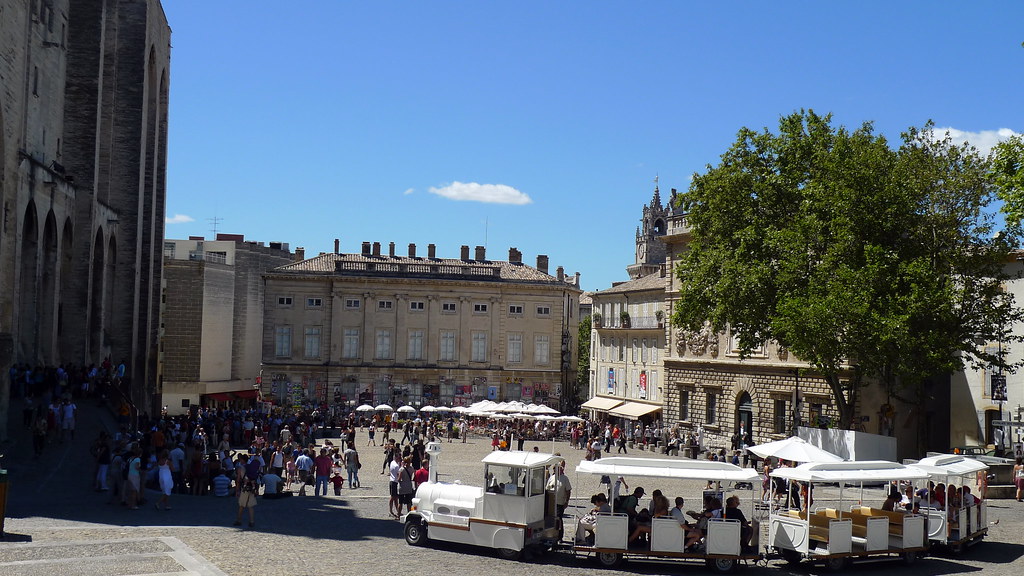
Covering the famous bridge, the picturesque streets, and neighborhoods around the center, and the Rocher des Doms which is on the left bank of the Rhône would take about 40 minutes.
Île de la Barthelasse
Here is another top spot you should add to your itinerary before taking on Avignon. With 700 hectares, the Île de la Barthelasse is one of Europe’s largest river islands. It belongs to the city and is linked to Avignon by the Pont Daladier. Although one might find it more fitting to grab the free ferry across the Rhône.
With peaceful orchards with only clusters of houses, the island is mostly quiet. The island’s highest point is 18 meters, and as such, the Île de la Barthelasse is exposed to the current. Hiring a bike in the summer and having a lavish picnic at the banks of the Rhone will be a brilliant idea.
Rue des Teinturiers
This was the flourishing center of Avignon’s silk spinning and dyeing industry from the 14th-century to the 19th-century. You will still find enchanting clues in the form of four water-wheels suspended from the bulwark next to the water. The gorgeous stone houses on the other side of the canal are connected to the cobblestone street by little bridges. And, the entire way is shaded by tall old plane trees. Do not forget to visit the Maison du IV de Chiffre. It is one of Avignon’s oldest mansions, and the home of Jean-Henri Fabre, the respected 19th-century entomologist at no.14
Basilique Saint-Pierre d’Avignon
According to a local folktale, the Basillique’s Saint-Pierre d’Avignon church’s predecessor was destroyed by the Moors in the 7th-century. The gothic buildings that are currently at the site were started in the 14th-century during the papacy of Innocent IV, who was the fifth Avignon Pope.
Just before you make your way into the church, take a little moment to adore the massive wooden tours. They were sculpted from walnut in 1551 by Antoine Volard. You will also find a wealth of art to see inside as we, like the decorated choir from the 18th-century, renaissance, and baroque paintings, and the 1400s relics of Saint-Pierre de Luxembourg with his real cardinal’s robes and hat.
Pont St-Bénézet
This site is popular among both visitors and locals. It is also known as the Pont d’Avignon, the mythic bridge from the 12th-century connects France with the Papal Territory. The bridge was positioned on the tightest part of the bend in the Rhône to minimize its exposure to the river’s cruel, strong currents.
There used to be 22 arches, of which you will see four today, and the bridge was 915 meters long- an impressive length for the time it was built. After a few hundred years, the bridge was destroyed by flood and rebuilt until an unfortunate flood in the 17th-century carried off most of the arches.
However, in the midst of the ruins is a piece of beauty. You can visit the gatehouse that defended the crossing, the stranded western terminal, the Tour Philippe-le-Bel and the Chapel of St. Nicholas on top of the second arch. In addition, the new museum show films and interactive media that display how the bridge morphed over the centuries.

Musée Calvet
The Calvet museum has been open to the public for over two centuries. That was after Esprit Calvet, a local doctor and collector, donated his art, cabinet of curiosities, and library to the city of Avignon. This diverse collection has since been expanding by donations from many collectors and contains ancient artifacts, an array of decorative and fine art, as well as cultural artifacts from different parts of the world.

There is even a considerable amount of exciting things to see, but the part many come to see is the Egyptology department. Among other things, they display a sarcophagus, canopic jar, and offering table. You will also see sculptures and silverware sit with French, Flemish, and Italian paintings from the 16th to the 19th century.
Markets and Special Shopping in Avignon
The contemporary covered market, Les Halles, in place Pie, is the perfect spot for some heavy shopping. About 40 different stalls sell the local produce of Provence from Tuesday to Sunday, from 6 am to 1 pm. The flower market at the Place des Carmes opens on Saturday mornings and the flea market on Sundays. And from June to September on the 3rd Monday of each month in the Allees de l’Oulle; a food market brings small scale producers to the city. You are sure to experience a massive array of food on weekends at St-Michel and place Crillon. You can start your shopping spree with some chocolates at one of the best chocolatiers, Puyricard. Also, it has branches all over Southern France.
Avignon Events and Festivals
The city hosts cultural fares, musical fests, art exhibits, and a lot of other social events that attracts visitor from far and near. Of all the events that the city hosts, the Avignon festival is the most popular, both locally and globally. This festival kicked off sometime in 1947 Jean Vilar, the actor-director, whose aim was to bring theatre to the people with top actors like Jeanne Moreau and Jean Negroni.
The Avignon festival is observed every year in July. The now 3-week-long event dominates the central courtyard of the Pope’s Palace which has a 2000 capacity. Featuring over 40 different performances of theatre, dance, fine arts exhibitions, and music throughout Avignon, the festival’s appeal is quite huge. In fact, companies from around the world have performed works from Shakespeare to Mikhail Bulgakov, Euripides to Chekhov. Another event is the Avignon Public Off which takes over 100 smaller locations.
Avignon Travel Blog – Conclusion
Avignon is full of history and a vibrant city with a lively social and cultural life. Whether it is the cinemas or museums, shops, wine, cuisine, events, tourists always come in their troves for one attraction or the other. Avignon is that welcoming.
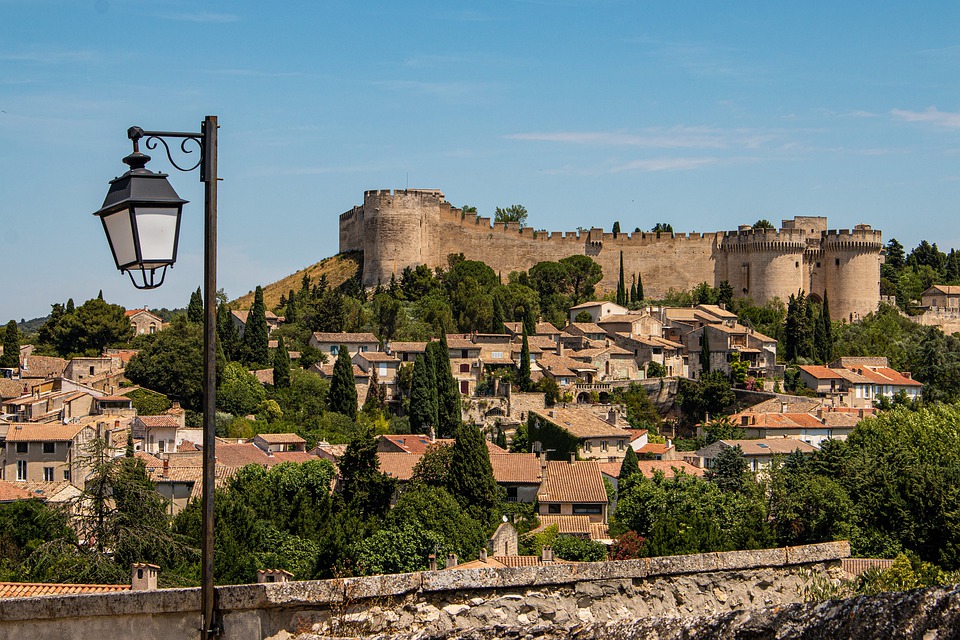
Peter is the editor of France Travel Blog. He has traveled to France many times and is ready to share the knowledge in this travel guide for France.
Related Posts
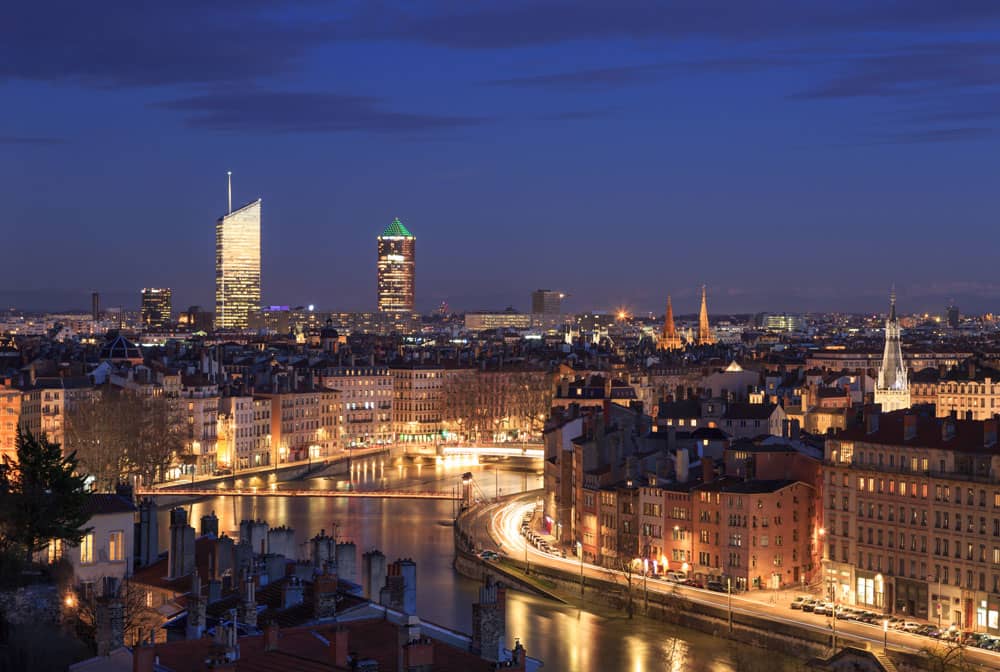
Lyon Travel Guide

Gordes Travel Guide: Tips for Visiting Gordes
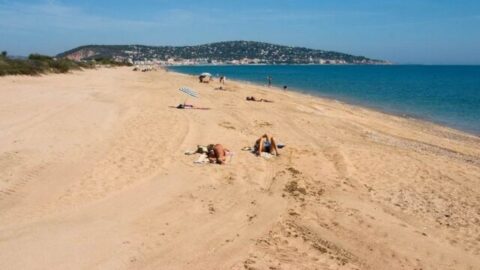
Best Beaches near Sete

10 Places To Visit On Your Next Europe Travel
Recent posts.
- Get Amazing Hotel in New York – Your Guide to Exclusive Deals
- The Gorges du Verdon: A Scenic Road Trip In Southern France
- Marseille Unveiled: Immerse Yourself in the Charm of the Mediterranean with a Captivating City Break
- A Beginner’s Guide to Road Cycling
- 5 Things to Look for When Buying Digital Cameras
- Entertainment
- Things To Do
- Travel Guides
- Travel Ideas
Social Links

Brittany Travel Guide

Best Honeymoon Destinations in France

Study in France Requirements and Student Visa Application Process

Is Tignes Expensive?

Is Reims Worth Visiting?
Hit enter to search or ESC to close.
Must-see attractions in Avignon
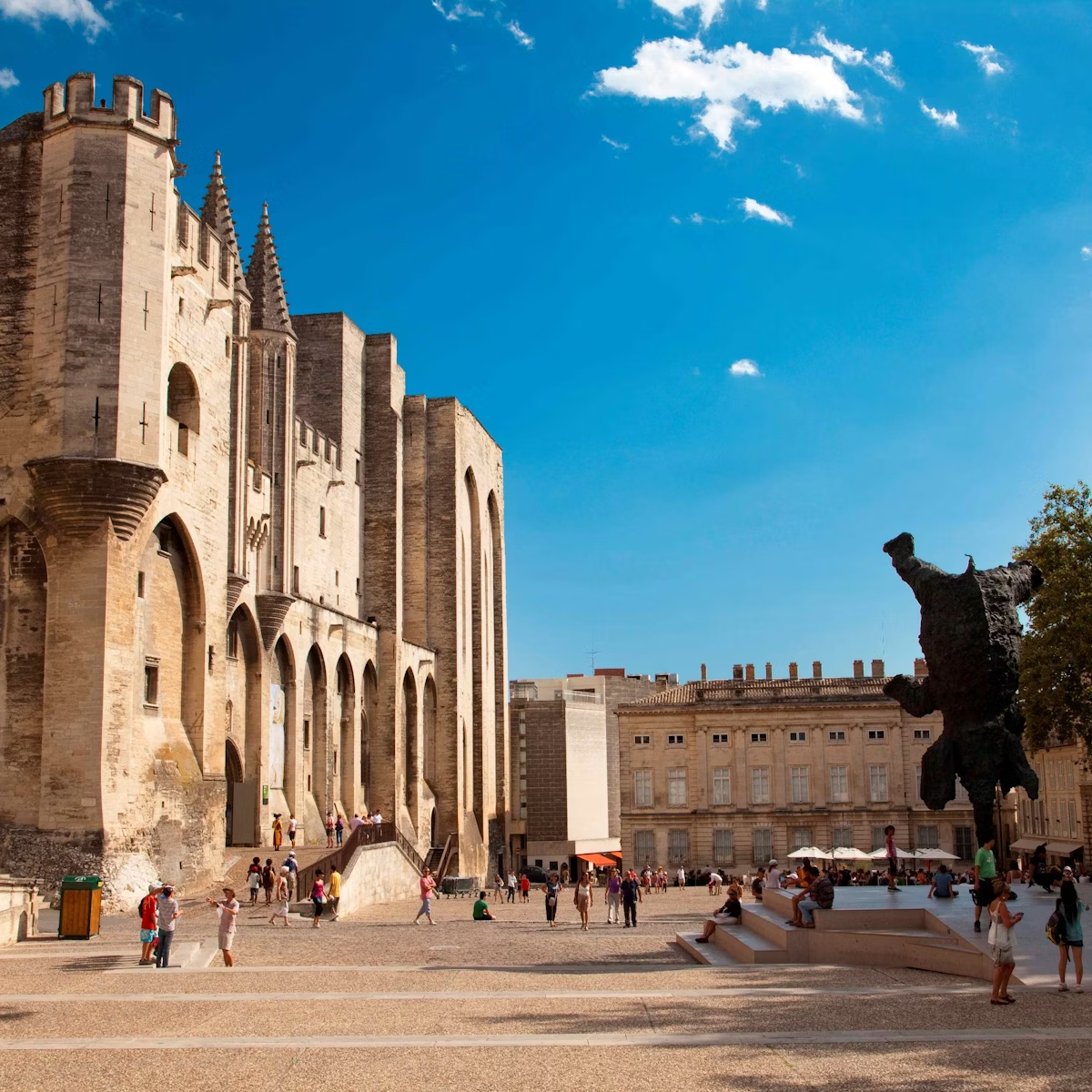
Palais des Papes
The largest Gothic palace ever built, the Palais des Papes was erected by Pope Clement V, who abandoned Rome in 1309 in the wake of violent disorder after…

Pont St-Bénézet
Legend says Pastor Bénézet (a former shepherd) had three visions urging him to build a bridge across the Rhône. Completed in 1185, the 900m-long bridge…
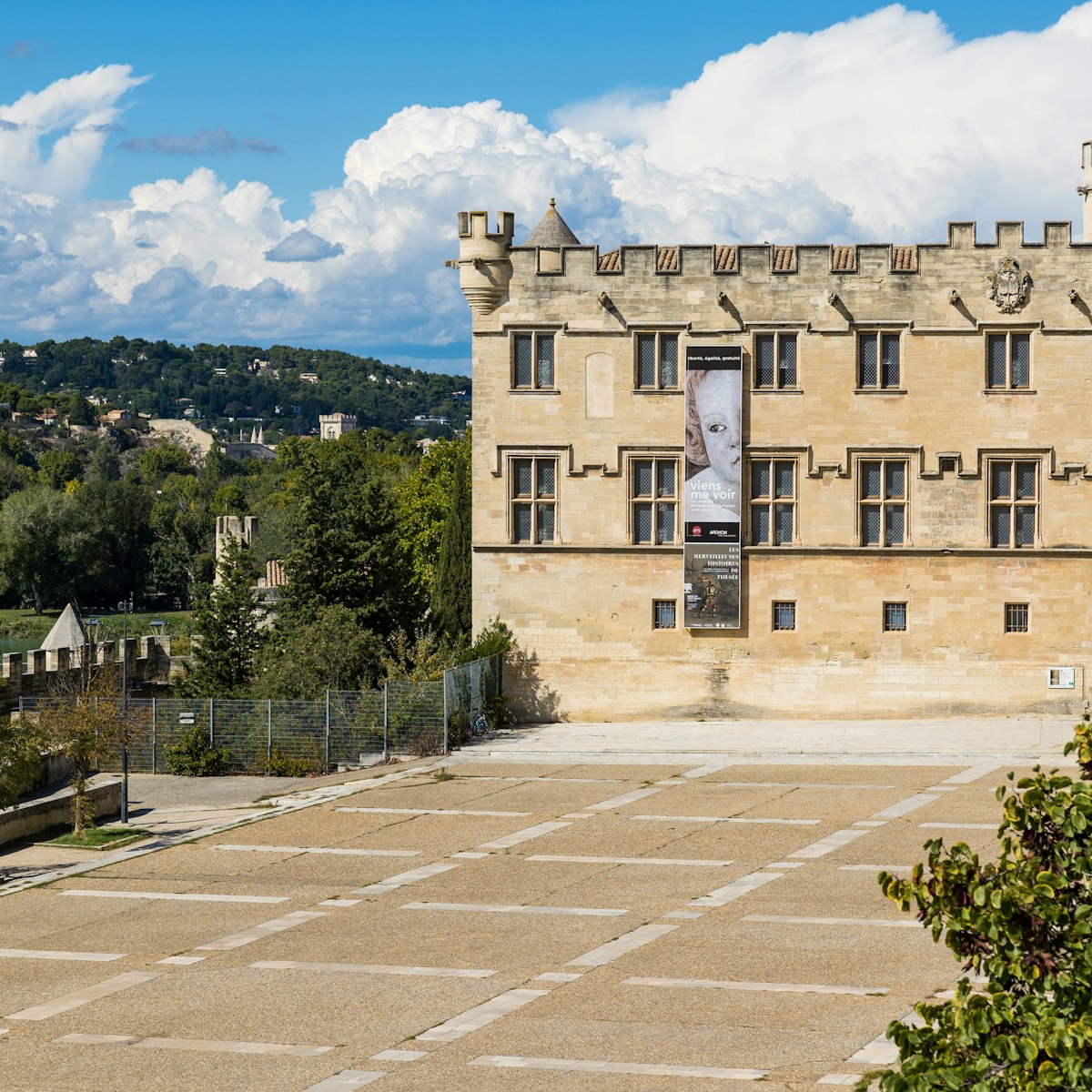
Musée du Petit Palais
The archbishops' palace during the 14th and 15th centuries now houses outstanding collections of primitive, pre-Rennaissance, 13th- to 16th-century…

Musée Angladon
Tiny Musée Angladon harbours an impressive collection of realist, impressionist and expressionist treasures, including works by Cézanne, Sisley, Manet,…
Place du Palais
This impressive vast square surrounding the Palais des Papes provides knockout photo ops. On top of the Romanesque 17th-century cathedral stands a golden…
Musée Lapidaire
Housed inside the town's striking Jesuit Chapel is the archaeological collection of the Musée Calvet, newly displayed since 2015. There's a good display…
Collection Lambert
Reopened in summer 2015 after significant renovation and expansion, Avignon's contemporary-arts museum focuses on works from the 1960s to the present…
Musée Calvet
The elegant Hôtel de Villeneuve-Martignan (built 1741–54) provides a fitting backdrop for Avignon's fine-arts museum, with 16th- to 20th-century oil…
Basilique St-Pierre
Basilique St-Pierre, in the centre of the walled city of Avignon, was built between the 14th and 16th centuries in the Flamboyant Gothic style.
Église et Cloître des Carmes
Construction on this Romanesque and Gothic Carmelite church and cloister began in the 13th century. It became one of the first theatre and dance venues of…
Porte St-Charles
Porte St-Charles is one of the entryways to Avignon's Unesco-registered walled city, located on the walls' southwestern edge; it's a modern-day breach cut…
Porte de la République
Porte de la République is one of the gateways to Avignon's walled city, located on the southern edge of the walls, and across from the central train…
Porte de I'Oulle
Porte de l'Oulle is one of the entryways to Avignon's walled city, located on the northwestern edge of the walls, near the River Rhône and Pont d'Avignon.
Porte du Rhône
Porte du Rhône is one of the entryways to Avignon's Unesco-registered walled city, located on the northwestern edge of the walls, near Pont St-Bénézet.
Porte de la Ligne
Porte de la Ligne is one of the entryways to Avignon's Unesco-registered walled city, located on the northen edge of the walls, near the River Rhône.
Porte St-Dominique
Porte St-Dominque is one of the entryways to Avignon's Unesco-registered walled city, located on the western edge of the walls, near the River Rhône.
Porte St-Roch
Porte St-Roch is one of the gateways to Avignon's walled city, located on the southwestern corner of the walls; it's particularly well preserved.
Porte St-Lazare
Porte St-Lazare is one of the entryways to Avignon's Unesco-registered walled city, located on the northeastern edge of the walls.
Porte Magnanen
Porte Magnanen is one of the entryways to Avignon's Unesco-registered walled city, located on the southeastern edge of the walls.
Porte Limbert
Porte Limbert is one of the entryways to Avignon's Unesco-registered walled city, located on the southeastern edge of the walls.
Église de St-Agricol
The relics of the patron saint of Avignon, St Agricol, are kept in this 14th-century church.
- United Kingdom
- Curated Stays
- Wine Travel
- About Isabelle
- Work with Us
23 Captivating Things to Do in Avignon: 2024 Insider’s Guide
- Isabelle Hoyne
- February 29, 2024
** Disclosure: some of the links on this site are affiliate links and should you make a purchase through these, I may receive a small commission at no extra cost to you. Thank you for your support!**
Uncover Avignon’s charm with our insider’s guide to the top 23 things to do in Avignon. From historic wonders to culinary delights, immerse yourself in this enchanting city. Explore attractions, indulge in local flavours and create unforgettable memories, discovering the essence of Avignon in every step.
Essential resources for your trip to Avignon
Top-rated tours and experiences: ☆ Avignon Walking Tour including the Pope’s Palace ☆ Tickets for Palais des Papes & Pont d’Avignon ☆ Provence in One Day Small Group Day Trip from Avignon ☆ Provence Lavender Full Day Tour from Avignon ☆ Chateauneuf du Pape wine tour Cultured Voyages recommended accommodation: Le Bristol ( well located, well designed ) // Hotel De Cambis ( rave reviews, stylish decor ) // L’Observance Bed & Breakfast ( gorgeous guesthouse with pool ) // Les Précieuses Suites & Sp ( gorgeous apartment with spa bath )
We arrived to Avignon in late March, having passed two sun-drenched months in vibrant Sevilla and got a bit of a shock.
The weather was decidedly cooler, thanks to the blustery Mistral wind which blows through this part of Southern France and sunny days were frequently interspersed with much drabber ones – truth be told, we’d hit Provence a little too early in the year.
However, as the weeks went on the beauty of Avignon gradually unfurled itself, bit by bit. Delicately pink cherry blossoms came and went and young, light-green leaves filled naked branches begging for new life.
Avignon had well and truly been awoken from its winter slumber, and its canvas had been painted anew with the brushstrokes of spring. Golden sunshine shone its light into the winding old streets, with ancient stone walls basked in light revealing intricate details and carvings made on golden stone – Avignon, for sure, is a city where it’s always worth looking up.
As each week went on, the streets filled with more and more people, gathering in squares shaded by elegant trees to meet, eat and drink.
With our patio doors flung open, sounds of spring found their way into our little apartment – the chirping of birds, rustling leaves, raucous laughter too, sometimes, as well as the ever so faint trickle of the old canal that meanders along historic Rue de Teinturiers nearby.
What brought us to Avignon originally were its more famous trappings – the imposing Palace of the Popes, the mighty city walls that surround the city, its famous bridge that leads to nowhere – but it was other things that made us fall in love with Avignon.
Things like its oddly-shaped squares, lined with cafés that were perfect for languid hours of people-watching. Or the kindness of its citizens, who patiently waited for me to butcher their language with my shoddy, school-girl French before coming to my aid in perfect English, many times over.
Also, how you could never really get lost in Avignon – somehow, someway, you would always stumble upon some narrow, well-placed, time-worn slip between buildings, which would eventually lead you down a path to one of those aforementioned, oddly-shaped squares.
Avignon is a special city, dusted with the magic of the South of France, along with its own specific brand of enchantment that’s been woven deep into its storied fabric. Take your time to explore it, take your time to read this blog post and discover the very best things to do in Avignon.
Table of Contents
An introduction to avignon, the best things to do in avignon, france, avignon attractions on the map, practical matters for visiting avignon, what to do in avignon – faq, why visit avignon.
Avignon is a city that boasts a rich history, centred around the majestic Palace of the Popes, which is a must-see attraction for anyone visiting the region.
But beyond its historical significance, Avignon is a vibrant university town, with a bustling arts scene that comes to life during the annual festival. The city’s architecture is truly stunning, with a mix of Gothic and Romanesque styles that give it a unique character.
And for those who love to explore, the compact city centre is filled with quaint shops, boutiques, and winding streets just waiting to be discovered.
As for dining options, Avignon offers an impressive selection of high-quality restaurants with diverse menus to satisfy any taste – I can more than happily testify to this, having spent a good number of weeks contentedly eating my way around the city.
A short history of Avignon
Avignon has a long history, with evidence of settlement dating back 5,000 years. It was once the stronghold of the Gallic tribe of Cavares, and later became the Roman city of Avennio.
In the 12th century, it gained independence and flourished in trade, but lost its independence in the 13th century after being occupied by King Louis VIII. This paved the way for the city’s later role as the seat of the papacy.
In 1309, Pope Clement V chose Avignon as the location for the papal residence, partly due to its central location within Christendom as well as the instability in central Italy at the time.
The papacy remained in Avignon for over 60 years, with seven popes residing there during that time. The papal presence in Avignon expanded significantly after the fourth pope, Clement VI, purchased the city in 1348.
Despite calls from St. Catherine of Siena and others for the popes to return to Rome, the papacy remained in Avignon until 1377, and the city continued to be one of the residences of the papacy during the Great Schism.
Having been governed by papal legates until then, Avignon was eventually annexed by the French National Assembly in 1791, and there was bloodshed during the seizure of the city.
The Palais des Papes, then an eight-towered fortress that served as the papal residence, was damaged during its seizure and was subsequently used as a barracks from 1822 to 1906.
Today, Avignon is an administrative and commercial centre, specialising in fruits and vegetables. The city’s economy thrives on tourism and light industries.
Learn about Avignon’s history on a walking tour
Avignon is so incredibly full of history, and taking a walking tour is a wonderful way to fully understand its history and cultural significance.
By exploring on foot, you can properly soak up the atmosphere of this UNESCO-listed city and appreciate its ancient Roman roots as well as its role as the seat of the Papacy in the 14th century.
This 3-hour walking tour of Avignon and the Pope’s Palace is a fantastic option for those looking to dive deep into the city’s history and beauty.
Led by an expert guide, the tour takes visitors on a journey through the heart of medieval Avignon, providing a comprehensive understanding of the city’s development and its place in European history.
One of the highlights of this tour is access to the Pope’s Palace, which is often subject to long waiting times during high season. By having priority access, you can explore the ornate chambers and chapels without wasting time waiting in lines.
In addition to the historical and cultural aspects of the tour, you will also have the opportunity to enjoy panoramic views of Avignon and the Rhône River from the top of the fortified city walls.
The tour concludes with a glass of Côtes du Rhône wine near the Place de l’Horloge, where you can admire the 19th-century architecture.
LEARN MORE | BOOK YOUR AVIGNON WALKING TOUR HERE
Visit the Palace of the Popes and the Musée du Petit Palais
If you’re planning a visit to Avignon, there are two must-see attractions that showcase the city’s rich history and cultural heritage: the Palace of the Popes and the Petit Palais museum.
The Palais des Papes is an imposing Gothic structure that was built over a period of less than 20 years in the 14th century. It served as the residence of the popes who lived in Avignon during the 14th century and is considered one of the most important buildings of its time.
Today, visitors can explore more than 25 rooms that are open to the public, including audience rooms, ceremonial rooms, and the Pope’s private apartments.
You’ll get a sense of the grandeur and opulence of the papal court and the incredible craftsmanship that went into building and decorating the palace.
Before you visit the Palais des Papes, it’s a good idea to stop by the Petit Palais museum. This museum houses a stunning collection of medieval art and artefacts, including over 300 Italian primitives, sculptures from the 12th to the 16th centuries, and significant holdings from the Avignon School.
The museum is housed in a beautiful former palace that was renovated in the late 1400s and is a ‘ Musée de France .’
When you’re ready to visit the Palais des Papes, be sure to take advantage of the histopads, which are digital tablets that really elevated the visit.
With augmented reality, you can see what the rooms of the palace looked like in the 14th century and get a better sense of what life was like during the time of the popes.
I’ve read in other posts that people found the histopads glitchy, but I didn’t find this at all – they worked great and had plenty of information should you wish to read more – I feel like the software may have been improved since the original complaints.
The visit to the Palace of the Popes usually takes about two hours, and in high season, it can be very busy. To avoid long waits, it’s a good idea to book your tickets in advance. Note that admission is free for children under eight years old.
PLAN YOUR VISIT | Book skip-the-line Palace of the Popes tickets here . The Palace of the Popes is open every day, all year round. Beginning of March to end of October, open 9am – 7pm. Slightly later opening and earlier closing outside these months
// Entry to the Petis Palais is free, with the museum closed on Tuesdays. Nov-Feb open from 10am-1pm / 2pm-5pm. Mar-May & Oct open from 10am-1pm / 2pm-6pm. Jun- Sep open 10am-1pm / 2pm-7pm.
Enjoy the atmosphere on Rue des Teinturiers
Rue de Teinturiers is a beautiful and atmospheric street that comes alive at night. It gets its name from the intense textile industry that flourished there between the 14th and 19th centuries.
The street follows the narrow Sorgue river, fed by the waters from the Fontaine de Vaucluse. You can still see four water wheels as testimonies to this past.
In the past, mills were installed in the houses across from each wheel, and the machines were driven by an axle that ran under the street. The demolition of some old premises uncovered one of the drive shafts still with its mechanisms.
The street is lined with old, large stones all carrying unique (and sometimes strange) carvings that decorate the uneven cobbles, and tall shaded trees as the river gently trickles by.
It’s a lovely place to stroll and take in the historical charm of Avignon, especially at night when the street comes alive with restaurants, bars, and cafes.
At the bottom of Rue de Teinturiers, on the corner of Rue des Lices, you can see one of the remaining chapels and the bell tower of what was once one of the largest churches in Avignon in 1226.
Further along the street, in the shade of the sycamores, stands the Grey Penitents’ Chapel, open to the public during mass hours.
This brotherhood, founded by King Louis VIII who visited Avignon in 1226 is the oldest brotherhood in Avignon, and is still active today. Every November 30th, members celebrate a miracle that occurred in 1433.
Despite flooding by the Rhône and the inundation of the Sorgue, the water in the nave remained parted, leaving open a passage by which the penitents could evacuate the blessed sacrament. This strange procession is recreated each year, with penitents making their way up the aisle on hands and knees!
Discover Avignon’s atmospheric squares
I’ve mentioned in the introduction to this post how much I fell in love with Avignon’s many squares. While most guides will recommend Place de l’Horloge as a must-see square, there are plenty of other charming squares worth visiting that trump the heavily-touristed Place de l’Horloge in my opinion.
For example, Place Pie , located in front of Les Halles marketplace, is a lively square full of sidewalk cafes, bars, and brasseries. It’s a real sun-trap and we found ourselves heading here for a drink and to people watch when the sun was out.
Meanwhile, Place des Corps Saints is a foodie’s paradise, with excellent restaurants (like the wonderful L’Agape), a beautiful church, and plenty of shade from stately plane trees.
Just a few streets away from Place des Corps Saints is Place Saint-Didier, my favourite square in Avignon and one which has an unassuming, neighbourhood feel to it. Covered by the shade of some huge trees, this is where the silkworm market used to be, as an inscription on a stone wall tells us today.
There are plenty of shops, cafes, and a charming church to explore here. You’ll find the bakery Violette and speciality coffee shop Tulipe on the edge of this square.
As you walk up Rue de la République, the main street in Avignon, you’ll come across Place de l’Horloge , the city’s main square.
While it’s worth checking out for its lovely carousel mayor’s office, don’t miss the nearby Place du Palais , in front of the Palace of the Popes, which offers a expansive view of the palace, the basilica of Notre Dame des Doms, and the Petit Palais.
In the popular neighbourhood around Rue de la Carreterie, which although close to city centre still feels off the beaten track, you’ll find Place des Carmes , a square with a covered marketplace, thriving theatres, and plenty of restaurants and cafes.
Finally, if you’re looking for a chic square to relax and enjoy a glass of bubbly, head to absolutely beautiful Place Crillon , one of the most bourgeois squares in Avignon, where you can soak up the sun and admire the city mansions and the beautiful Hôtel d’Europe.
It’s especially lovely when viewed with your back to the old city wall.
Walk along the Pont d’Avignon
If you visit Avignon, then you’ll likely catch sight of Saint Bénezet bridge , better known as the Pont d’Avignon . This historic bridge is famous throughout the world thanks to the children’s song “ Sur le pont d’Avignon “.
The bridge was built in the 12th century and originally spanned approximately 900 meters and was made up of 22 arches, making it the only place to cross the Rhône between Lyon and the Mediterranean sea.
However, it was washed away several times by flood waters and was finally abandoned in the 17th century.
Today, all that remains of the bridge are four arches and a chapel dedicated to Saint Nicolas. Despite its partial state, it is classified as a World Heritage site by UNESCO and is a of engineering that was continually being worked on and repaired.
It is also a source of legends and an emblematic monument of the area.
If you visit the Pont d’Avignon, make sure to avail of the multi-media display and audioguide, which offers descriptions based on scientific research about the legends and history of the bridge.
You don’t need to spend a whole lot of time at the bridge – probably about 30-45 minutes in all, but if you’re interested in history then you will enjoy the experience.
PLAN YOUR VISIT | Open daily year round. Opening times vary throughout the year, from 9/10am – 5/7pm depending on the season. Tickets available on the door, but you’re better off purchasing a combined Pont d’Avignon and skip-the-line Palace of the Pope ticket .
Discover some of Avignon’s beautiful religious buildings
With such strong links to the papacy, it should come as no surprise that Avignon is home to several beautiful churches and religious buildings, each with its unique history and architectural style.
One of the most impressive structures is the Basilica of Notre Dame des Doms , located near the Palace of the Popes. It was built in the 1100s and underwent renovations in the 15th and 17th centuries.
The church’s gilded lead statue of the Virgin Mary is an iconic landmark that seems to reach up to the sky and is visible from many points around the city (we even caught a shimmering glimpse when cycling round Barthelasse Island) and you can now explore its grand interior after a two-year renovation.
The basilica is open to the public from September to June, Monday to Saturday, and on Sunday afternoons, with free admission.
Another noteworthy site is the Gothic Notre-Dame Collegiate Church and Cloister .
This church, built under Cardinal Arnaud de Via, houses several paintings and a replica of the famous Pièta de Villeneuve Lez Avignon. Visitors can explore its historic cloister and church free of charge, except during liturgical services.
The Saint-Pierre church is a hidden gem tucked away in a small square. The church’s intricate facade, with richly-carved walnut doors and decorative ornaments, dates back to 1512, while the interior features impressive woodwork, paintings, and an altarpiece.
Visitors can access information at the presbytery, and entrance is free, but no visits are allowed during services.
Other religious buildings include a neoclassical synagogue , which has been rebuilt several times after fires, and the Penitents Gris Chapel , a 16th-19th-century chapel with stunning stained-glass windows and a history dating back to the 17th century.
RELATED READING | Best Day Trips from Avignon for Curious Travellers
Get lost in Avignon’s city centre
When in Avignon, don’t miss the opportunity to explore the city’s rather lovely backstreets. They offer a glimpse into the local pace of life and also reveal the city’s medieval roots.
Wandering through these winding lanes, you’ll come across pastry shops, quaint cafes, interior design stores and tiny galleries, all of which exude a unique charm.
As you stroll through the cobblestone streets, you’ll notice the niches on house fronts and the old-fashioned street signs with names like “Street of the Animal Furriers” and “Hosiery Street”. Each of these names is a reminder of the city’s past and adds further to the overall medieval atmosphere.
Make sure to visit the legendary Rue des Teinturiers, where waterwheels and canals used to power the city’s textile industry.
The medieval Rue Peyrolerie is another worth walking down, as you’ll pass under the buttresses of the Palace of the Popes through a street that is hewn from rock – this street was where the art of boiler-making was practiced in the Middle Ages.
At every turn, history is waiting to be discovered in Avignon’s backstreets.
Find some treasures in Avignon’s boutiques
Shopping in Avignon is an indulgent experience that fashion lovers will certainly appreciate. With an eye for all things stylish, the Avignonnaise have curated a range of luxury boutiques that offer the latest trends and quality pieces delivered with French flair.
The famous Rue Joseph Vernet has been a hub for trendsetters and style-seekers for years, attracting customers in search of the latest fashion.
For those looking for a range of French (and other) designers, the streets of Saint-Agricol and Petite Fusterie offer a range of boutiques that provide a secret alcove for brands like The Kooples, Max Mara, Longchamp, Sandro, Gérard Darel, ba&sh, Maje, Father & Sons and more.
Jewellery and leather goods enthusiasts will not be left out as Avignon also hosts many great jewellers, perfumers, and beauty stores. The array of stores in Avignon offers something for everyone, catering to various tastes and budgets.
Myself (and my mother who visited) spent several happy hours browsing the shops.
Admire Avignon’s unique buildings
Avignon is home to some wonderfully unique buildings. One of the most striking features of some of these structures is their Trompe L’Oeil façades.
Trompe L’Oeil is a painting technique that gives the illusion of three-dimensional objects on a two-dimensional surface. These paintings on buildings create a visual effect that makes it look as if there are statues, columns, or other architectural elements where there are none.
In Avignon, if you look up, you’ll likely start noticing many of these paintings within boarded up windows.
In addition to Trompe L’Oeil, many of Avignon’s buildings have intricately carved decorations over their windows and doors. These carvings are made of stone and depict various characters from history or mythology.
There are also plenty of religious carvings set into niches high up on street corners. They serve as a testament to the skilled craftsmen who built these buildings centuries ago – some look so old and it’s really impressive to think the sculptor’s artwork has withstood both the elements and the test of time.
At night time, many of these over-door carvings are illuminated with LED lights – so keep an eye our for them.
I had a couple of favourites, but one that’s definitely worth looking out for and easy to find is the gargoyle over the doorway of the building directly across the street from the entrance to Le Nid.
Discover Avignon’s exceptional art collections & museums
Art lovers will really enjoy Avignon’s offerings. There are many museums to explore, both free and with an entry fee. What I particularly loved about them is that they are quite small, but well curated, meaning that it’s difficult to reach a saturation point as you can toddle in and out of them as you wish.
Let’s first begin with the museums that charge an entry fee:
Collection Lambert is a must-visit museum for contemporary art lovers. The museum is housed in two 18th-century townhouses in the heart of Avignon and features an outstanding collection of major works from the second half of the 20th century and beginning of the 21st century.
The museum’s collection includes works by famous artists such as Jean-Michel Basquiat, Miquel Barceló, Sol LeWitt, and Bertrand Lavier. The museum also hosts ambitious exhibitions and a varied cultural and educational program.
Musée Angladon is another museum that you shouldn’t miss. It’s a “home that is a museum,” which holds a collection of treasures and has kept the charm of an art-lover’s interior. The museum features works by Modigliani, Cézanne, Van Gogh, Picasso, and many other prestigious artists.
There are several other marvels to discover at Musée Angladon, making it a very worthwhile museum to visit. It was incredible to get so close the paintings and I would highly recommend a visit.
Musée Louis Vouland is located in a magnificent 18th-century private mansion. Visitors are invited to discover a decidedly French taste with furniture, porcelain sets, tapestries, chandeliers, and other pieces of decorative arts from the 17th and 18th centuries.
The museum also hosts high-quality temporary exhibitions each year, and a monthly programme of readings, concerts, thematic guided tours, and other workshops.
Now let’s talk about the free museums:
Avignon is home to five free museums that complement each other well and display several thousand works of art – objects, documents, paintings, sculptures – housed in some of the most beautiful buildings in Avignon. Click here for further information. These museums are:
- Musée Calvet , housed in a listed 18th-century private residence, displays painting and sculpture collections from the 15th–20th centuries, along with Egyptian objects, bas-reliefs, mummies, and more.
- Palais du Roure , another 15th-century palace, which houses a museum of Provençal history and traditions.
- Musée Requien , Vaucluse’s Museum of Natural History.
- Musée Lapidaire , a former Jesuit chapel displaying Etruscan, Greek, Roman, and Gallic antiquities.
- The Petit Palais , home to a wealth of medieval religious art and that I recommend visiting before you head into the Palace of the Popes.
Cycle around Île de la Barthelasse
One of my favourite things that we got up to in Avignon was cycling around Île de la Barthelasse. It offered a fantastic opportunity to experience Avignon’s countryside while being so close to the historical city centre.
It was a super relaxing bike ride in a green setting that offered a perfect escape from the hustle and bustle of the city, which felt a million miles away.
La Barthelasse is a unique place that is worth exploring. It is the largest river island in Europe, covering 700 hectares of farmland that overlooks the Palace of the Popes. The island is rich in woodland that is home to many species of birds, beavers, and otters, providing evidence of preserved nature.
To access Barthelasse Island, you can take a free ferry service that runs every few minutes and gets you across in just two minutes. Once there, you can enjoy the shade of the huge plane trees on the towpath, where you can also get beautiful views of the city.
You can also purchase fresh fruits and vegetables at the Ferme de la Reboule, a local farm, or have lunch beside the water at Le Bercail restaurant, which boasts views of the Pont d’Avignon and the city walls.
For those who are more energetic, you can rent a ‘ Vélopop ‘, a city bike that can be hired from docks located all over the city, and follow one of the signposted cycle routes between apple trees and cherry orchards.
Alternatively, you can rent a better quality of bike for a half or full day. We rented ours from South Spirit Bikes .
Head across the river to Villeneuve-les-Avignon
Villeneuve-les-Avignon, located on the other side of the Rhône River from Avignon, is a charming medieval town with a rich history and plenty to see and do. The town’s origins date back to the tenth century, when a small abbey was built at the top of Mont Andaon.
Villeneuve gradually developed around the abbey, and in the twelfth century, the town erected a protective wall to fend off Avignon’s advances. The Fort Saint-André and Tour Philippe le Bel were built to guard the new frontier for the Kingdom of France.
The arrival of the Papacy in Avignon in 1309 transformed the city, and Villeneuve benefited from the newfound prosperity. Agriculture and wine-growing were developed to meet the needs of the growing population, and magnificent palaces were constructed on the riverbanks.
One of Villeneuve’s most entrancing jewels is the Chartreuse du Val de Bénédiction, founded during the 14th century as a monastery.
The site has been superbly refurbished and is a fascinating place to visit, with its monks’ cells, painted frescoes, cloisters, and church, which houses the mausoleum of Pope Innocent VI.
Other sites of interest include the old town, the museum Pierre de Luxembourg, the chapel of the Pénitents Gris, and the hill of Les Mourgues.
You can climb the Tour Philippe le Bel for good views across to the papal buildings of Avignon, and the Collegial Notre-Dame Church has a cloister and some noteworthy artworks.
The town also has several medieval properties, originally the palaces for the cardinals of Avignon, to admire as you pass. Finally, don’t miss the weekly markets, which take place on Thursday and Saturday mornings.
RELATED READING | Best Things to Do in Arles: From Van Gogh’s Legacy to Ancient Roman Ruins
Take a boat trip on the Rhône
If you’re looking for a unique way to experience Avignon, I highly recommend taking a boat trip on the Rhône River. From April to September, you can hop aboard the Saône and embark on a one hour and fifteen minute outing that showcases some of the most beautiful sites of the Papal City.
During the sightseeing trip, you’ll have the opportunity to see Avignon’s famous landmarks from a different perspective.
You’ll get to admire the wonderful Pont d’Avignon, the majestic Palace of the Popes, the bustling marina, the Rocher des Doms, the elegant Pont Eiffel and the picturesque banks of Barthelasse Island and Piot Island.
You’ll even get to catch a glimpse of Villeneuve-lez-Avignon and the Philippe-le-Bel Tower from a great vantage point. They also offer lunch and dinner boat trips, along with further sightseeing tours to Arles, Tarascon and Villeneuve-lez-Avignon.
MORE INFO | for more information, or to book click here .
Explore the stalls of Avignon Les Halles
If you’re a food lover, then the shrubbery-shrouded Les Halles will likely call out to you during your visit to Avignon.
While not the most beautiful building you’ll ever see, or potentially not the biggest or ‘best’ covered food market you’ll ever come across either, it’s packed to the rafters with the flavours of Provence and allows you to rub shoulders with the locals as they pick up their groceries, or stop in for a glass of wine.
One of the most popular spots in Les Halles is La Cabane d’Oleron , which was always busy any time it was open. Here, you can enjoy celebrated oysters such those from Utah Beach and Fines des Claire, along with mussels, platters and a range of other seafood delicacies.
I loved the atmosphere here – exceptional quality without any ceremony, with deliciously fresh seafood washed down with a glass of chilled white wine.
But there’s more to Les Halles than just oysters. With over 40 vendors offering a wide variety of specialties, you’ll find everything from artisanal cheeses to fresh produce, spices, cured meats, and baked goods. It’s a true paradise for foodies and the energy and friendliness of the vendors is palpable.
Also, if you need a break from perusing, you can always stop by one of the little bars in the market. Locals come here to prop their elbows and enjoy a glass of wine or a coffee, and it’s a great way to soak up the vibrant atmosphere of Les Halles.
If you happen to be in Avignon on a Saturday, make sure to catch the chefs’ demonstration. From 11am to 12 noon, talented chefs from the city showcase their skills by preparing a dish using produce from Les Halles.
It’s a great way to learn more about Provençal cuisine and get inspired to try cooking some of these dishes at home.
OPENING HOURS | Open every morning from Tuesday to Sunday // 6am – 1:30pm (weekdays) / 6am – 2pm (weekends)
Walk around the Remparts d’Avignon
Becoming a go-to activity when we fancied stretching our legs, it was quite the novelty to be able to walk around a fully walled city.
The ramparts are a testament to the rich history of Avignon and are one of the few remaining fortifications from the 14th century in France. These walls surround the entire old city and are 4.3 kilometres long – perfect for getting that step count up!
The ramparts were built in the mid-14th century, during the Papacy of Pope Innocent VI, to protect Avignon from the attacks of roving bands of mercenaries. They were finished in 1370 under Pope Urban V.
Today, the ramparts are a UNESCO World Heritage site and offer stunning views of the city and the Rhône River.
You can complete a full circuit around the outside, although I preferred to follow the walls along the inside – you’ll have to go outside them a couple of times however as certain areas within are private property and inaccessible.
Still, it’s worth the slight inconvenience as you’ll catch glimpses down intriguing little streets that you probably wouldn’t have otherwise stumbled upon. To access the highest part of the ramparts, you can enter through the Avignon Bridge and make your way up to the Rocher des Doms Gardens.
The views from there are expansive and offer a perspective of the city and its natural surroundings, including the river, Barhalesse Island and the Norman tower in Villeneuve-lez-Avignon.
Head to Le Nid for some hipster vibes and speciality coffee
There’s really only one place to go in Avignon if you’re on the hunt for speciality coffee, but thankfully that offering, in the form of Tulipe , is a rather good one.
Tulipe is part of a larger concept store called Le Nid d’Avignon, which also includes CQFD, a boutique featuring fashion and design products, and Inspire Yoga, a yoga studio.
The entire space is focused on well-being and responsible consumption, encouraging visitors to consider a new definition of the art of living.
At Tulipe, the coffee shop within Le Nid, you’ll find a carefully curated selection of specialty coffees, including single origin and organic options. The coffee is sourced from small producers and the space itself is upmarket yet inviting, with eclectic decor and plenty of natural light.
Andy became particularly partial to heading down to Tulipe to do a bit of work and you’ll find several others doing the same whenever you pop in too.
You can also choose to sit outside on their chic, striped furniture and watch the word go by while enjoying one of their delicious pastries or cakes – of which there are plenty of vegan options.
Dine at some of Avignon’s superb restaurants
Avignon is a city known for its superb restaurants and delightful cuisine, with chefs who love to work with their local products. Here are some of the top restaurants to try in Avignon:
Carré du Palais : This elegant bistro is known for its vast selection of AOC wines and offers outdoor seating with views of the palace, as well as inside the grand buildings it’s located in. The chef curates a gourmet menu using fresh, local, and seasonal products. Highly recommend this buzzy, slick operation.
L’Agape : Situated in the lovely square Place des Corps Saints, L’Agape offers chic bistro cuisine prepared by Chef Julien Gleize, who uses ultra-fresh ingredients from the best artisans and growers in and around Avignon. We really, really enjoyed our meal here.
Maïnama : Located on Rue des Teinturieries, Maïnama is an artisanal burger restaurant with flavors from around the world. The charming, laid-back owner adds to the welcoming ambiance, as does its situation at the edge of the Sorgue river.
La Mirande : Located in the historical medieval part of the hotel by the same name, this Michelin starred restaurant curates traditional cuisine served at one big shared table, with the chef preparing a market-inspired menu.
La Canoa : This cheery eatery boasts a glorious outdoor setting and serves up extremely fresh flavours in their ceviche dishes. Additionally, they offer an assortment of moreish empanadas. Sit down on the polished stone street under the sun, enjoy a glass of rosé, and revel in the simple pleasures.
Big Fernand : Gourmet French burgers, this restaurant only works with fresh, top-quality French products that are locally sourced. I gorged on a delicious blue cheese concoction. Three types of fries with a range of different dipping sauces, all made in house.
Mamma Corsica : This charming restaurant serves Corsican cuisine, featuring traditional recipes and new creations with Corsican ingredients straight from the island, in a great location just off Place Pie.
Grand café Baretta : This restaurant/brasserie is located in the heart of Place Saint Didier (my favourite square). Perfect for taking five and resting your weary feet.
Vivotto : Gourmand, healthy “fast” food with an Italian accent. Their artisanal cuisine uses only fresh and natural products, with most dishes being gluten-free. Sit outside under the cherry-blossoms for a beautiful dining experience.
Overall, dining in Avignon is a fantastic experience, with plenty of delicious restaurants to choose from. Whether you’re looking for French cuisine or something else, Avignon has it all.
Visit some local caves to taste the wine of Provence
If you’re looking for a unique and authentic experience while in Avignon, I highly recommend visiting some local caves to taste the wine of Provence.
La Cave Des Pas Sages is a great little bar off the tourist trail, nestled under old trees next to a water mill on Rue des Tenturiers. The wine there is really well-priced and the atmosphere is cozy and charming.
Another great option is Vins-7 , which is not strictly a bar as you’re required to eat in order to have a drink. The owner, a former sommelier, is super knowledgeable and there is a great selection of wines, especially from the Rhone region.
Tapis Rouge is another excellent wine bar, located in the heart of the historic centre of Avignon. They have a focus on Rhone varieties, and their staff is friendly and knowledgeable.
We enjoyed a lovely glass of Châteauneuf-du-Pape here. To accompany the wines are quality products that include cheeses from Les Halles d’ Avignon, Ardèche charcuterie from Teyssier, and wild Scottish salmon from Kaviari.
RELATED READING | Provence Itinerary: 5 Days of Enchanting Scenery, Historic Landmarks & Culinary Delights
Chill out in Parc Rocher des Doms
If you’re looking for a tranquil spot to unwind in the heart of Avignon, you should pay a visit to Parc Rocher des Doms. This beautiful English-style public garden is situated atop the Rocher des Doms and provides breathtaking views over the surrounding countryside, the Rhone plains, and Mont Ventoux.
In the 18th century, it became a popular strolling spot, highly appreciated for the quality of the air and the views over the beautiful landscapes.
Major work was done in the 19th century to turn it into a public park with trees and grasses from the former Jardin des Plantes being planted, water pools created, and statues of famous persons being erected.
You can reach the gardens from the Popes’ Palace Square, the watchman’s walk along the ramparts from the Pont d’Avignon, or the escalier Sainte Anne, behind the Palace of the Popes. You can even take the little tourist train up to the garden.
The park is generously planted with shrubs and trees, covers 29,000 square metres / seven acres, and dotted with signs in English and French outlining its history.
The park’s centrepiece is a large pond with swans, ducks, geese, and carp. The highest point, a small crag, offers some of the park’s best sweeping views across the valley.
There are plenty of benches for the weary tourist, two small children’s playgrounds, a picnic area, and several toilets. And if you need a snack, there’s an adjacent snack bar serving sandwiches, salads, pizzas, hot snacks, and waffles.
Note that its opening hours are restricted outside the summer season.
Experience Avignon’s theatres and festivals
The Festival d’Avignon, founded in 1947 by Jean Vilar, is a much-cherished event for theatre-goers. For a month every July, Avignon becomes a city-theatre and transforms its architectural heritage into majestic performance venues.
The festival offers a program of around 45 shows from France and abroad, with a total of about 300 performances and over 400 events, including readings, debates, and screenings.
Apart from the Festival, theatre in Avignon is a year-round affair. The area boasts numerous established and emerging theatres with productions performed throughout the year.
Special events such as Fest’hiver in February and festivals like Morières de Rire and Roquemaure de Rire bring theatre enthusiasts together for unique experiences. With more red velvet theatre seats than inhabitants, the city is steeped in a rich theatrical culture.
Avignon’s theatres are diverse in both architecture and maximum occupancy, with some seating as few as 50 and others seating up to 2,000 people. Keep an eye out for them as you make your way around Avignon – I was astounded at the sheer volume, and often on tiny, quiet streets too.
The city is also home to several historical and outdoor scenic venues that provide a unique atmosphere for theatrical performances.
MORE INFO | For more information on theatre performances and/or festivals, check here for current events .
Take the Petit Train to get your bearings
If you want to explore the beautiful city of Avignon but have trouble getting around on foot, taking the Petit Train d’Avignon is an excellent option.
This train offers a memorable tour of the city’s most stunning sights, including the UNESCO World Heritage Site, Palais des Papes, the medieval shopping streets, picturesque districts, and the famous Pont d’Avignon.
For children, there is a specially designed audio commentary that immerses them in a medieval and futuristic history.
The Petit Train will climb some hills so you don’t have to, allowing you to discover the marvellous panoramas and monuments of Avignon, Villeneuve-les-Avignon and the Island of Barthelasse.
You can buy a ticket valid for the day, allowing you to get on and off at your own pace and leisure to explore the city.
By taking a combined ticket (City tour + Little Train), you can take advantage of the intimate richness of Avignon city centre, the majesty of the river and the discovery of Villeneuve-les-Avignon.
MORE INFO | See here for further information
Attend the opera in Avignon
The Opera in Avignon is intimately linked to the history of the city and is a testament to several families’ will in the 17th century to make Avignon a stronghold of culture in France.
The Opéra Grand Avignon has undergone several renovations and restorations over the years to become the magnificent building it is today.
The theatre was initially built in 1824 on the Place de l’Horloge, but it was destroyed in an arson fire in 1846 and had to be rebuilt on the same site. The Opera has played host to several famous artists over the years and has been an essential venue for national-level performances.
In 2017, the Opéra Grand Avignon was refurbished to improve its visibility, comfort, and air conditioning for the audience. The four-year-long restoration was completed in 2021 and the result is a stunning blend of modern comfort and historic charm.
If you’re lucky enough to attend a performance, you’ll be amazed by the beauty and elegance of the building, from the corridors that lead to your armchair to the magnificent stage where the performers showcase their art.
The Opéra Grand Avignon is a must-visit destination for opera lovers and history buffs alike.
MORE INFO | Click here for the season’s schedule and to book tickets .
Use Avignon as a base to explore the region of Provence
If you’re planning to explore the beautiful region of Provence , I highly recommend considering Avignon as a base camp. It’s the perfect location for those who want to make the most of their time in this region of France , especially if you only have a few days to spare.
From Avignon, you can easily explore many of the highlights of Provence, including the stunning Alpilles, the iconic Mont Ventoux, the picturesque Chateauneuf-du-Pape vineyards and the unique Camargue areas. All of these attractions are less than an hour’s drive from Avignon.
We rented a car from Avignon TGV station via Rentalcars which we found to be a very straightforward process. You’ll need to get from Avignon city centre to the TGV station (by train or by taxi).
In terms of parking if you’re planning on renting a car, there are several paid larger car parks, on-street paid parking which you can pay for via an app called Flowbird, as well as free carparks outside the city centre.
Accommodations may also have private parking, or will be able to assist you in terms of best options.
If you prefer to use public transportation, Avignon is also an excellent choice. Many cities in the region, such as Marseilles, Nîmes and Arles can be easily reached by train from Avignon.
You’ll also be able to find less frequently running busses to some of Provence’s smaller nearby towns, like L’isle-sur-la-Sorgue and Saint-Rémy-de-Provence as well as a bus to the Pont du Gard.
RELATED READING | A Guide to the Châteauneuf-du-Pape wine region
Most popular day trips from Avignon
Avignon is a fantastic base from which to explore the Provence region.
You can choose to hire a car (there are a number of free carparks outside the city walls if you’re worried about paying for parking) or you could alternatively take day trips independently via train to places like Nîmes, Arles , Orange and Marseilles.
For harder to reach areas, or if you don’t want to get too caught up in logistics, then you could consider taking a number of guided day tours from Avignon. I’ve included a curated list of some of the best below.
- Provence in One Day Small Group Day Trip from Avignon
- Chateauneuf du Pape wine tour
- Provence Highlights Full-Day Tour from Avignon
- Provence Cru Wine Small-Group Half-Day Tour from Avignon
- Luberon, Roussillon & Gordes Half-Day Tour from Avignon
- Provence Lavender Full Day Tour from Avignon
I appreciate that there has been a lot included in this guide, therefore I’ve put as much of these things to do in Avignon it as I can into a map, which you can save for your own trip to Avignon should you wish.
Attractions, outdoor areas, museums and galleries, restaurants, shopping and wine bars have all been colour coded and saved into different layers. Click the star beside the title on the map to add to your own Google account.
When is the best time to visit Avignon
The best time to visit Avignon all depends on your preferences and what you want to do.
The peak tourist season in Provence is during the summer months, from June to August. The weather is hot and sunny, and the region is bustling with tourists from all over the world.
This is also when the famous Avignon Theatre Festival takes place in July. However, keep in mind that the crowds can be overwhelming during this time, and it can be challenging to find affordable accommodation.
Personally, I stayed in Avignon in the spring, and I found it to be an ideal time to explore the town and surrounding areas. By early May, the weather was beautiful, with plenty of sunshine yet tolerable temperatures.
There was a nice buzz in the city centre, but without the hordes of tourists that come during the peak season.
If you’re interested in visiting wineries and vineyards nearby , then one of the best times to go is during the harvest season, which usually takes place from late August to October.
During this time, you can witness the grape-picking process and even participate in wine tastings. Crowds will also have fizzled out a little, as will the temperatures as you head towards autumn.
How to get to and around Avignon
Avignon is a well-connected city in the south of France and there are several ways to get there:
By plane : The closest airport is Avignon-Provence Airport, located about 10 kilometres from the city centre although you likely will not find flights from your original destination to here. Alternatively, you can fly into Marseille Provence Airport, which is about 75 kilometres away, and take a train or bus to Avignon.
By train : Avignon is served by two train stations: Avignon Centre and Avignon TGV. Avignon Centre is located in the heart of the city and serves local and regional trains, while Avignon TGV is located outside of the city and serves high-speed trains. We actually flew home to Ireland via Lyon when we departed Avignon and were at Lyon Airport’s TGV station in 50 minutes from Avignon TGV, making this a great alternative option.
By car : Avignon is well-connected by highways and there are many car rental agencies available.
Once you’ve arrived in Avignon, there are several ways to get around:
- On foot : Avignon is a small city and most of the main attractions are within walking distance of each other, within the old city walls. With the exception of the hill up to Parc Rocher des Doms, it is also very flat.
- By bike : Avignon has a bike-sharing program called Vélopop, which allows you to rent a bike for short periods of time.
- By bus : Avignon has an extensive bus network that connects the city centre to the surrounding areas.
- By taxi : Taxis are widely available in Avignon and there are several taxi stands throughout the city. We were also able to hail taxis via Uber and Bolt (but just make sure to give yourself plenty of lead time if you need to be somewhere for a certain time, as they may take a while to reach you).
What is the difference between Avignon Centre and Avignon TGV
Avignon Centre is located in the heart of the city and serves local and regional trains. If you’re staying in Avignon or plan to explore the surrounding areas by train, Avignon Centre is likely the station you’ll be using.
Avignon TGV is located outside of the city, about 6 kilometres from the city centre, and serves high-speed trains. If you’re travelling from other parts of France or Europe and want to get to Avignon quickly, Avignon TGV is the station you’ll be arriving at.
To get from Avignon TGV to the city centre, you can take a taxi, train, or rent a car. Trains run regularly between Avignon TGV and Avignon Centre and the journey takes only around 5 minutes.
RELATED READING | A Guide to Saint Remy de Provence: a Provençal Paradiseuide to Saint Remy de Provence
Where to stay in Avignon
Cultured voyages recommended hotels in avignon.
Hotel d-Europe | Avignon’s most luxurious hotel
A 16th-century gem in Avignon’s heart, a short 5-minute walk to Palais des Papes and Avignon Bridge. Enjoy elegant rooms with free Wi-Fi and savor gastronomic delights at the on-site restaurant.
Hotel De Cambis | boutique belle with patio
Nestled within the historic city walls, Le Magnan is a tranquil oasis surrounded by lush greenery. Immerse yourself in comfort and modern amenities, with picturesque garden views from most guestrooms. Indulge in a delightful breakfast on the charming garden patio.
Hôtel Le Bristol | beautifully decorated, well-located 4-star
Discover the perfect blend of convenience and comfort at Hôtel Le Bristol, ideally situated within Avignon’s historic ramparts. Experience the charm of recently renovated rooms with modern amenities and a cosy lounge that invites relaxation.
Start your day with a delicious breakfast before exploring the city’s highlights, all just steps away.
Le Magnan | rave reviews, stylish decor
Enjoy a truly exquisite experience at this recently renovated hotel, where well-designed rooms ensure a comfortable and clean stay. Located at the heart of Avignon, it offers convenience and a delightful view of the nearby church.
Highly recommended for its friendly staff, ideal location, and fantastic amenities.
Cultured Voyages recommended guesthouses & apartments in Avignon
L’Observance Bed & Breakfast | superb B&B with outdoor pool
Discover a hidden gem in Avignon, where hospitality reigns supreme. This spacious property offers a perfect base for exploring the city on foot, with attentive hosts and a serene pool surrounded by gardens.
Indulge in a comfortable room, delightful breakfast, and personalised recommendations for an unforgettable stay.
Les Précieuses Suites & Spa | stylish apartment rental
Step into a beautifully renovated apartment in the heart of historic Avignon. This tastefully decorated duplex offers comfort and convenience, with easy access to major attractions, restaurants, and all you need for a memorable stay. Ideal for families or groups of up to four, it’s a true gem.
La Banasterie | Avignon’s (charming) oldest B&B
Experience the enchantment of history at La Banasterie, Avignon’s oldest B&B (founded in 1521). Nestled in the heart of the city, steps away from the Palais des Papes, it offers individually decorated rooms, a charming terrace, flowered patio, and a library.
Is Avignon a walkable city?
Avignon is a very walkable city. The old town, which is surrounded by medieval walls, is compact and easily navigable on foot. The main attractions, such as the Palais des Papes, Pont Saint-Bénézet, and the Avignon Cathedral, are located within a short distance of each other and can easily be visited on foot.
Walking is also a great way to discover the city’s charming streets, squares, and hidden corners. There are also very few hills – Avignon is a very flat city, so it’s not too taxing to explore by foot at all.
How many days do you need in Avignon?
You can visit Avignon in one day, but I would recommend staying for at least two or three days to explore the city and its surroundings. This will give you enough time to visit the main attractions, take a leisurely stroll through the charming streets and enjoy the local cuisine and wine.
You can also use Avignon as a base to explore the wider Provence region, which is home to stunning landscapes, historic towns and vineyards. In this instance, then you can easily plan for longer.
One added benefit to staying in Avignon as a base for exploring Provence , is that when you return home in the evening, you will in no way run out of superb restaurants to eat at.
What is Avignon best known for?
Avignon is best known for its UNESCO World Heritage-listed historic centre, which is home to the imposing Palais des Papes, the iconic Pont Saint-Bénézet and the picturesque Place de l’Horloge.
The city is also known for its rich cultural heritage, which is celebrated every year during the Avignon Festival, one of the most important theatre festivals in the world. Additionally, Avignon is renowned for its food and wine, including the famous Chateauneuf-du-Pape wine which is made nearby.
Is it worth visiting Avignon?
Absolutely. Avignon is a beautiful city with a rich cultural heritage and a vibrant local culture. Whether you are interested in history, art, architecture, or gastronomy, Avignon has something for everyone.
The city is also a great base for exploring the wider Provence region, which is home to some of the most beautiful landscapes and historic towns in France.
RELATED READING | Why It’s Worth Visiting Avignon: 11 Unmissable Reasons
Is Avignon better than Aix en Provence?
Both Avignon and Aix-en-Provence are beautiful cities with unique cultural and historical attractions. I enjoyed my time in both cities, but as a ‘cultural’ traveller who explored the region of Provence, I was happier to have chosen Avignon as a more long-term base (I spent a week in Aix).
Avignon is best known for its UNESCO World Heritage-listed historic centre and its rich cultural heritage, while Aix-en-Provence is famous for its elegant streets, fountains, and museums.
The choice between the two cities depends on your personal interests and preferences. However, if you are interested in exploring the wider Provence region, Avignon may be a better base as it is more centrally located.
I would, however, recommend that you visit both if you can – despite being relatively close to on another, both cities have a distinctly different feel.
Do they speak English in Avignon?
Yes, English is widely spoken in Avignon, especially in the tourist areas. In fact, the level of English spoken is truly impressive and made me very embarrassed to be stumbling through ill-remembered school-French.
However, I always think it’s nice to learn a few basic French phrases to show your appreciation for the local culture and make the most of your visit. A “ bonjour ” followed by “ parlez-vous Anglais? ” can go a long way – you’re a visitor in their country, after all.
What to see in Avignon in one day?
If you only have one day in Avignon, I would recommend visiting the Palais des Papes, deliberating over Pont Saint-Bénézet (I wouldn’t deem this to be a ‘must-see’), and taking time to visit one or two of Avignon’s museums or churches.
I’d also highly recommend a jaunt down Rue des Tenturieres, as well as taking a leisurely stroll through the charming streets of the historic centre and enjoying the local cuisine and wine.
I’d also urge you to seek out a café in a square that sounds appealing to you, to sit and watch the world go by amongst the locals. By all means, pop your head in too to the food market in Les Halles – just remember that this closes in the early afternoon.
Related reading for the South of France
Interior provence.
- Avignon wine tours | 10 Wonderful Avignon Wine Tours Worth Taking
- Avignon day trips | 24 Best Day Trips from Avignon for Curious Travellers
- Arles | Best Things to Do in Arles: From Van Gogh’s Legacy to Ancient Roman Ruins
- Saint Remy de Provence | A Guide to Saint Remy de Provence: a Provençal Paradise
- Châteauneuf-du-Pape | Visiting Châteauneuf-du-Pape: A Journey Through a Historic Wine Region
- Châteauneuf-du-Pape accommodation | Hostellerie du Château des Fines Roches – A Luxury Provençal Retreat
- Provence itinerary | Provence Itinerary: 5 Days of Enchanting Scenery, Historic Landmarks & Culinary Delights
- Where to stay in Provence | Where To Stay in Provence: 10 Best Places + Accommodation Picks
Coastal Provence & French Riviera
- Antibes | Things to Do in Antibes: 23 Must-Visit Attractions & Memorable Experiences
- Is Antibes worth visiting? | Is Antibes Worth Visiting? Discover Why This Riviera Gem Is a Must-Visit
- Antibes travel guide | Visiting Antibes: Insider’s Guide to a Riviera Gem
- Sentier du Littoral Wall | Walking the Sentier du Littoral of Antibes – Essential Guide
- Cap d’Antibes Coastal Walk | coming soon
- A day in Cannes | coming soon
- 1 day in Nice | coming soon
- Nice wine tours | 10 Fantastic Nice Wine Tours Worth Taking
- 4 days in French Riviera | coming soon
- 5 days in French Riviera | coming soon
- 7 days in French Riviera | coming soon
- South of France Road Trip | coming soon
- Where to stay on the french riviera | Where to Stay on the French Riviera: 11 Best Locations (& Hotels)
Like this post? Please share or save for later

Related Topics
- Inspiration
Hi there! I'm Isabelle, aficionado of immersive travel experiences and unique, luxurious hotels. You'll most likely find me camera in hand, or nerding out on research in advance of my next trip. A major foodie, history and scenery lover, nothing makes me happier than soaking in the atmosphere and culture of the destination I'm visiting.
You May Also Like
Florence travel guide: 28 unmissable tips for the first-time visitor.
- July 15, 2024
20 Best Sri Lanka Safari Hotels Across 6 National Parks
- June 13, 2024
- Lisbon & Tagus
Is Sintra Worth Visiting? 12 Pros, 5 Challenges + Top Tips
- March 5, 2024
Input your search keywords and press Enter.

The Perfect 1, 2 or 3 Days in Avignon Itinerary
Published on April 18, 2023
by Brittany Scott-Gunfield
Disclaimer: This article contains affiliate links. That means if you click a link and make a purchase, we may make a small commission. As an Amazon Associate we earn from qualifying purchases. For more information, see our privacy policy.

Our Avignon itinerary will take you on a fantastic journey through the historic streets of this provencal city, from palaces and popes to wine and walls. Over 1, 2 or 3 days in Avignon, you’ll have plenty to do at a relaxed pace to really get a feel for life in this former papal residence.
Table of Contents
How Many Days in Avignon?
Although small in size, Avignon has a long and rich history, from the Romans to the present day, with most of the city’s attractions becoming World Heritage Sites in 1995.
Its main significance lies in being one of only three papal seats outside of Rome, and of course, the Papal Palace remains Avignon’s main tourist attraction. However, you’d be forgiven for wondering how many days to spend in Avignon, as little else is known about the city unless you’re a true francophile, a local, or from its twinned town of Colchester, England.
For 1 day in Avignon, you can plan to see the main historic sites as they are located very close together within the city’s walls, such as the Pope’s Palace and gardens, and the neighbouring semi-destroyed bridge.
If you have 2 days in Avignon, you can add a walk around the ramparts and through the charming city streets as well as a visit to a museum.
However, if you have 3 days, you can even go on a day trip to one of the vineyards on the Rhône, to the hilltop villages or to the nearby historic city of Arles , overflowing with Roman history and delighted with memories of Van Gogh.

Getting To & Around Avignon
Avignon is located in the South of France, relatively centrally, at 100 km northwest of Marseille , 100 km northeast of Montpellier and 230 km directly south of Lyon . The easiest way to reach Avignon from outside France is by flying into Avignon-Provence Airport, which is a 20-minute drive from the city centre or one hour via bus line 62.
From other cities in France, you can reach Avignon by high-speed train (TGV) from most major cities, including Paris , or via coaches or ridesharing applications. Avignon’s central train station is just outside of the city walls, however as it’s a small city, it’s just a ten-minute walk to the centre. You can view train schedules here.
You can enjoy a very pleasant long weekend in the city without needing a car, however, if you want to go further afield during a longer stay or as part of a Provence itinerary , you should rent a car to be able to get around more easily, particularly to the charming small villages located to the South and East of Avignon or even make your way to Aix-en-Provence .
Rental cars are available from Avignon-Provence Airport as well as other rental agencies outside of the city centre. You can browse car hire options here .
Within Avignon, there are buses and trams around the outside of the city walls, and some bus routes crossing the centre, however, due to the proximity of Avignon’s main highlights and the charming cobbled streets, it’s much better to explore the city on foot or by rental bike.
There is also the “Petit Train” also known as the little touristic train that takes you through a small circuit around the city to see 11 stops, including the Palais des Papes, Rocher de Dom and the Pont d’Avignon. Or a longer city circuit takes you over the rivers to Barthelasse island and the Philippe le Bel Tower.

1, 2 or 3 Days in Avignon Itinerary
Day 1 – historic centre.
Whether you take the Petit Train first or explore Avignon on foot, in one day in Avignon, you can take your time while visiting the most important historic buildings and relics the city has to offer. You can also take a walking tour to get more historical information about the city.
Palais des Papes
The Pope’s Palace is undoubtedly the highlight of any Avignon itinerary, so naturally comes as the first stop on ours. While most people know of the Vatican City being a papal enclave in Italy, few know that Avignon was formerly one in France, after Pope Clement V moved to France in 1309.
It was in 1316 that Pope John XXII began construction on the Palais des Papes, aided significantly by his successors Benedict XII and Clement VI, as demonstrated by the slight archaeological differences in the palace’s design.
The Papal Schism took place in 1378 as the College of Cardinals in Rome, eager to bring the papacy back to Rome, elected the first Pope Urban VI before nullifying this election and electing Pope Clement VII instead.
Due to Pope Urban VI’s unwillingness to step down, Pope Clement VII was forced to return to Avignon, with the support of King Charles V of France, beginning the era of two Popes that caused chaos in Europe as leaders were forced to recognise only one.
The schism ended finally in 1429 with the resignation of the Avignon and Roman Popes, the death of the Pisan Pope who ruled briefly from 1409 to 1410, and the election of Pope Martin V.
Later becoming a governmental residence and then barracks during the French Revolution, the Palais des Papes is now open to visitors who can learn more about the former papal residence, complete with awe-inspiring frescoes by Matteo Giovannetti and gardens.
If you’re spending one day in Avignon, you can buy a ticket that includes a visit to the Pont d’Avignon. You can also visit the Notre Dame des Doms d’Avignon (the main cathedral of the city), next to the palace, which is also a UNESCO World Heritage Site from the 12th century, holding several tombs on the Popes of Avignon.
Head down from the Palais des Papes, past the impressive baroque façade of the Hôtel des Monnaies to the palace gardens.

Jardin des Doms
Sat alongside the Rhône River, is a beautiful elevated public garden that gives visitors views of the provencal countryside and Mont Ventoux to the Northeast.
It’s the perfect place for a picnic, so pick up a fresh baguette and some fromage before you arrive, to sit and relax among the ponds, ponies, and palace to the rear, before continuing your Avignon itinerary.
The Jardin des Doms, also referred to as the Rocher de Doms, is free to enter every day from 7.30 am until sunset.
Pont d’Avignon
Actually called Pont Saint-Bénézet, but affectionately nicknamed the Pont d’Avignon, this mediaeval bridge over the Rhône was built in 1234 with 22 stone arches, replacing the wooden bridge that had been located there one hundred years before.
Unfortunately, the new stone Pont Saint-Bénézet faced the same misfortune as the wooden bridge, being regularly destroyed by the Rhône floods and finally being abandoned after a major flood of 1669.
Now with only its gatehouse and four remaining arches in Avignon, the Chapel of Saint Nicholas on the second pier of the bridge, and the Philippe-le-Bel Tower on the West side, little remains of the historic bridge, but it’s still worth a visit.
Famous in France due to a little ditty from the 15th century, while you’re on the bridge, make sure to give a rendition of “Sur le Pont d’Avignon, l’on y danse, l’on y danse…” as you spin in circles with your partner for the full experience; if you’re alone, here’s your chance to make a friend!

Tour de Philippe-le-Bel
Crossing the Rhône River on Pont Édouard Daladier, or taking a free boat, to the Île de Piot, and continuing across Pont du Royaume over the West divergence of the Rhône River, you’ll reach the small village of Villeneuve-lès-Avignon, where after a couple of minutes walking along the riverside, you’ll come across the wonderful Philippe-le-Bel Tower.
This tower marked the end of the Pont d’Avignon and provided the French gateway to the Papal enclave of Avignon before the river destroyed it in the 1600s. Meaning, Philip “the fair” the tower’s name comes from King Philippe IV who commissioned it around the turn of the 14th century.
Closed in January and on Mondays, you can go up the tower for €4.50 before finishing your evening with a stroll along the riverside, or a 15-minute walk up to one of France’s oldest olive oil manufacturers, Maison Bronzini, formerly The Moulin de la Chartreuse, to try some delicious natural olive products and perhaps buy a souvenir, or enjoy a freshly prepared meal in their new restaurant.
Day 2 – Ramparts
Continue to discover the historic sites if you have 2 days to spend in Avignon, with its well-preserved ramparts, museum and exquisite cuisine.
Remparts d’Avignon
As you start your second day, you can see remnants of the former defensive perimeter from the 1200s in the city planning as you navigate the winding cobbled streets towards Avignon’s Ramparts.
This 8-metre tall city wall extends for 4.3 km around the historic centre since it was built by order of Pope Innocent VI in the mid-1300s to protect the papacy from angry French mercenaries. Over the centuries, the ramparts have met a great number of attacks and required numerous repairs; today there are 15 entrances for vehicles and a further 11 for pedestrians.
As it’s free to go up and walk around every day of the year, this is a must-do activity over 2 or 3 days in the city. You can pick up a brochure in the tourist information centre before walking around the ramparts, or book a guided tour to learn more about the history of the city walls.

Palais du Roure
The Palais du Roure is less of a palace and more of a hôtel particulier – an old French mansion belonging to one family over many years.
Formerly the home of the Baroncelli-Javons, a Florentine family, for 5 centuries before being changing hands and eventually being bought by author Jeanne de Flandreysy in 1918, the Palais du Roure is now a diverse centre of provencal history and culture, an art museum and the location of Flandreysy’s bell collection.
Although the contents are a touch bizarre, this Gothic mansion is architecturally charming and is free to enter to see the permanent collections from Tuesday to Saturday.
Musée Calvet
Just a 4-minute walk from the Palais du Roure towards the Rhône, lies another incredible hôtel particulier, this time from the 18th century, and a Jesuit Chapel forming the Calvet Museum.
Esprit Calvet, who gives the museum his name, was an enlightenment-era economist and collector, who donated his full collection of antiques, his library and natural history collection to the city of Avignon to be turned into a museum upon his death in 1810.
The mansion houses a wonderful fine art collection, while you can find all kinds of gemstones, precious metals, porcelain and tapestries in the lapidary area of the museum located in the former chapel. You can also find a number of archaeological finds from other continents that Calvet had collected.
Closed completely on Tuesdays and every other day from 1 – 2 pm for lunch, the museum’s permanent collection is free and you can pay on arrival for any current exhibitions.
Eating in Avignon
Due to its location and climate, the food in Avignon is exceptional, with seafood from the nearby Mediterranean, Spanish influence from the West, French influence from the North and perfect vegetable-growing land, giving the city an abundance of fresh ingredients to use in its cuisine.
Depending on which season you’re visiting Avignon in, you can find ample fresh cherries and strawberries, asparagus and garlic, and of course cheese, at most regional markets in the area as well as being served in the bistros and auberges.
Try the typical Avignon dish Foie de Veau en Persillade (veal liver in a parsley sauce) from central restaurant Caf’Thiers on Rue Thiers to get a taste of the area, or pick up some famous provencal charcuterie from your nearest butcher, supermarket or market stall (such as in Les Halles d’Avignon) to enjoy with your picnics or apéritifs. You can even do a cooking class with a chef at Les Halles market!
There is no doubt that eating local cuisine is one of the best things to do in Avignon.
Day 3 – Day Trips from Avignon
Avignon is a small city but in a great location, so once you’ve seen its highlights, take a day trip to one of the many interesting provencal villages and historic sites, by car, public transport or guided tour.
Pont du Gard
Just 26 km West of Avignon is the amazing 1st-century aqueduct, the Pont du Gard.
Either by car or line 115 bus from Avignon’s central bus station to Vers-Pont du Gard, you can easily arrive at the historic site, walking from the entrance into the grounds, with the museum where you can learn about the history of the aqueduct, shops full of local souvenirs and cafe where you can have a pleasant breakfast or light lunch. You can also take a guided half-day tour that also visits some other nearby villages.
After 15 minutes walking through the site, you’ll arrive at the incredible bridge. Although 2,000 years old the Pont du Gard is an amazing piece of architecture today, with its three arched tiers spanning 275 metres across the river Gardon. You can buy entry tickets here.
You can cross the aqueduct to get a different perspective and head to the Terrace restaurant for dinner if you have your whole day there, or explore the other historically significant bridges, Pont du Combe Roussière, or Pont de Valmale, or visit the ancient Chapel of St Peter or ruins of the formerly 50 km long aqueduct.

Driving 50 minutes South or taking the TER for 17 minutes from Gare d’Avignon to Gare d’Arles, you’ll arrive in the magnificent city of Arles. The centrepiece of the city is the Arènes d’Arles – an incredible two-tiered Roman amphitheatre. You can also take a guided half-day tour.
You can visit the amphitheatre to learn of its history as a place of gladiator battles, or book an event in advance, as the amphitheatre now hosts concerts and other events throughout the summer months.
You can also wander down the Alyscamps; a seemingly Gothic version of the Parisian Champs Élysées, this spectacular tree-lined route takes you past many ornate sarcophagi into an old Roman cemetery with a church from the 1100s.
Or, you can head to the Fondation Vincent Van Gogh, an art museum dedicated to the artist who lived in the city from 1888 to 1889, proving to be one of his most prolific periods in which he produced 200 paintings and 100 drawings and watercolours, including one of his most revered works, Sunflowers.
Although many of his famous works are scattered around Europe or housed in the Van Gogh Museum in Amsterdam, this museum provides a great opportunity to see a broad spectrum of the artist’s work in the very place that inspired them. It was also while living in Arles that Van Gogh cut off his ear while being visited by friend Paul Gaugin.

Châteauneuf-du-Pape
One of the best day trips that you can do, even if you just have 2 days in Avignon, is to the village of Châteauneuf-du-Pape, just 12 km north of Avignon. There are a number of tour options such as this half-day tour or this afternoon tour.
Although its name is larger than the village itself, Châteauneuf-du-Pape is an absolute must-see place in Provence and one of the best places to visit in Avignon, especially for oenophiles, or connoisseurs of wine, as the region produces around 14 million bottles of wine annually.
Gaining its name officially in 1893, Châteauneuf-du-Pape is named due to the ruins of the mediaeval castle that sit above the village that was originally built for Pope John XXII in the 1300s. Nowadays, the village is much more famous for its production of deep red wines, which you can taste at many of the 320 local vineyards and wineries, covering 7,746 acres.
One of the most notable is Château Fortia, a family-run vineyard whose post-WWI struggle prompted husband and pilot Baron Le Roy and his friend Joseph Capus to begin work on a system of naming and protecting French wines, which was adopted in 1936 and is known today as the appellation d’origine contrôlée, or AOC.
Or visit Château La Nerthe; one of the oldest wineries in the region, dating back to 1570 and now one of Châteauneuf-du-Pape’s biggest and best.
Since 93% of wine produced in the Châteauneuf-du-Pape region is red, you won’t find much white wine, however there is a great variety in the types of red on offer, which you can see in the AOC wine shop, Vinadea.
Gordes, Roussillon and Sault
If you have 3 days in Avignon or more, you should definitely rent a car or book a guided tour such as this full-day tour or this half-day tour to visit the nearby villages of Gordes, Roussillon and Sault. A circular drive visiting each provencal village from Avignon would take under 3 hours, so you have plenty of time to spend in each village between enjoying the views from the road.
40 minutes driving from Avignon is the hilltop village of Gordes, with scenic views of the surrounding countryside and winding cobbled streets taking you past the white stone buildings.
Just 15 minutes East of Gordes, is the picture-perfect village of Roussillon. Sat at the foot of the red Vaucluse mountains which lend its colour to the pinkish houses, in one of the world’s biggest ochre deposits, surrounded by Provence’s famous lavender fields and green pine trees, Roussillon is bursting with so much colour, it’s hard not to take out your sketchbook and paint brushes or takes picture on every corner.
There are many little ateliers dotted around the village too, demonstrating the influence the amazing landscape has on the artistic side of its inhabitants.
Continue for 30 minutes to the village of Sault for a real taste of Provence. You can take a free 30-minute guided tour of the Distillery Aroma’Plantes where you can take part in workshops to make your own lavender oils and soaps with the natural fragrances available to learn the skills passed down through generations of the lavender farmers of Provence.

Where to Stay in Avignon
Hotel Boquier – Mid-range visitors to Avignon will love the cosy hotel. Situated in the city centre within easy reach of all of the top attractions, there is a range of rooms to choose from, parking included and breakfast on offer in the mornings.
Hotel De Cambis – Luxury travellers will love this sophisticated hotel in the centre of Avignon. There are plush and comfortable rooms to choose from, a hearty breakfast available in the morning and a range of other amenities for guests to enjoy.
Chapelle du Miracle – These apartments are a great choice for those who would prefer their own flat when visiting Avignon. There is a range of different apartments to choose from, all fully furnished with everything you may need and they’re located in an excellent location for exploring the city.
Not quite what you’re looking for? Click here to browse more Avignon hotels!
Although small, Avignon has a long and significant history which can be witnessed all over the city, from the food to the art and architecture. So don’t miss out and book your trip to Avignon today!
Are you planning a trip to Avignon? Have any questions about this itinerary? Let us know in the comments!

Related Posts:

One Day in Cannes Itinerary: A Day Trip from Nice

The Perfect Loire Valley Day Trip from Paris

Is Paris Expensive? A Paris Trip Cost Guide

About Brittany Scott-Gunfield
Brittany is a writer for The World Was Here First. Originally from Colchester, England, she is slowly but surely travelling the world as a digital nomad. She loves to hike around different landscapes and has a deep love for travelling around France (and elsewhere in Europe).
Leave a Comment Cancel reply

- To do on site
Guided tours
There’s so much to see and understand in the Avignon area. From the cobbled streets of the historic center of the city of the popes to the secret charms of the surrounding villages, a world of discoveries awaits you. Guided tours, fun tours, guided walks, experiential tours… Follow the guide!

Avignon

- Agenda of the day
- Where to eat ?
- To do today
- Visits of the day


Lire le numéro
- Mes favoris
- Mes alertes et mes newsletters
- Mes commentaires
- Mon abonnement
- Se déconnecter
Appuyez sur la touche échap pour fermer la recherche.
Festival d’Avignon 2024 : les dix spectacles à ne pas rater
SÉLECTION. La Cité des papes accueille cette année près de 1 700 spectacles. Que voir sur place dans le « in » ou le « off » ? « Le Point » vous conseille.
Par Baudouin Eschapasse
Temps de lecture : 8 min
L'article a été ajouté à vos favoris
- Google News
- Copier le lien
Lecture audio réservée aux abonnés
D ifficile de faire son choix à Avignon cet été tant l'offre du festival officiel et de son pendant, le « off » alternatif, est pléthorique. Alors que la manifestation, avancée cette année en raison des Jeux olympiques, entre dans sa troisième semaine, Le Point vous signale dix spectacles à réserver de toute urgence.
Tous les mercredis à 16h
Recevez l’actualité culturelle de la semaine à ne pas manquer ainsi que les Enquêtes, décryptages, portraits, tendances…
Votre adresse email n'est pas valide
Veuillez renseigner votre adresse email
Merci ! Votre inscription a bien été prise en compte avec l'adresse email :
Pour découvrir toutes nos autres newsletters, rendez-vous ici : MonCompte
En vous inscrivant, vous acceptez les conditions générales d’utilisations et notre politique de confidentialité .
Forever… Pina Bausch
Après avoir fait danser 200 danseurs amateurs dans Cercles, fin juin, puis avoir créé, en plein air (au stade de Bagatelle à Avignon), sa nouvelle pièce, Liberté cathédrale pour l'Ensemble du Tanztheater Wuppertal qu'il dirige, Boris Charmatz investit le plateau de la FabricA à partir du 14 juillet pour une « immersion dans Café Müller de Pina Bausch. » C'est en assistant aux répétitions de cette œuvre majeure de la créatrice allemande disparue en 2009 , dont il a pris la suite à la tête du Tanztheater, que le chorégraphe a eu l'idée de cet opus baptisé Forever . Un titre qui vaut programme.
Boris Charmatz dit avoir « voulu transmettre l'émotion toujours recommencée de la pièce mythique de Pina Bausch, qui semble avoir débuté avant l'arrivée du public et se poursuivre après son départ ». Pour ce faire, il a imaginé un dispositif impressionnant : un spectacle joué en continu sept heures durant. Une installation que l'on est invité à visiter, tel un monument. Vingt-cinq interprètes se relaieront pour jouer plusieurs fois Café Müller.
Une initiative heureuse tant ce spectacle, initialement créé en 1978 et qui figure parmi les plus joués du répertoire de Pina Bausch, offre une multitude de lectures possibles. Le sujet central peut être envisagé tantôt comme une évocation de l'enfance de la chorégraphe, dont les parents ont travaillé dans un bar d'hôtel à Solingen pendant la guerre, tantôt comme une parabole décrivant les difficultés de communication entre les hommes et les femmes au sein d'un couple. Ces représentations seront entrecoupées d'interludes parlés évoquant l'histoire personnelle de Pina Bausch… Une manière de multiplier les points de vue sur son travail.
La FabricA de 13 heures à 20 heures, les 14, 15, 17, 18, 20 et 21 juillet.
Hécube, pas Hécube
Au printemps dernier, Clotilde de Bayser incarnait une Hécube magnétique dans le texte de Claudine Galea mis en scène par Laëtitia Guedon, au théâtre du Vieux Colombier. Sous la direction de Tiago Rodrigues , la reine de Troie prend, cet été, les traits de la non moins talentueuse Elsa Lepoivre. Celle-ci joue plus précisément le rôle de Nadia, une comédienne amenée à dire les mots d'Euripide et à se glisser dans le costume de cette héroïne de la mythologie grecque.
Elsa Lepoivre est donc Nadia jouant la veuve de Priam, trahie par Polymnestor qui a tué son fils. Une figure inspirante pour cette femme qui, dans sa vie privée, est également en quête de justice. Nadia est de fait la mère d'un enfant victime de sévices : un garçon autiste, maltraité dans une institution spécialisée et dont les tortionnaires sont convoqués devant un tribunal. Entre les planches du théâtre et le Parquet du procès, Nadia va se battre sur tous les fronts. Le cadre majestueux de la carrière de Boulbon sied particulièrement bien à ce drame contemporain qui résonne avec la tragédie antique.
À la Carrière de Boulbon à 22 heures, jusqu'au 16 juillet.
L'Abolition des privilèges
Quoi de plus spectaculaire qu'une révolution en train de se faire ? Huit ans après l'enthousiasmant Ça ira (1) Fin de Louis de Joël Pommerat …, Hugues Duchêne nous offre de revivre un épisode majeur de 1789 en adaptant pour le théâtre le roman de Bertrand Guillot : L'Abolition des privilèges (Les Avrils). Cet ouvrage reconstituait habilement la folle « nuit du 4 août » , où, réunis à Versailles dans un modeste entrepôt, les membres de la jeune Assemblée nationale mirent à bas l'Ancien Régime.
La pièce qui en est tirée restitue tout aussi ingénieusement l'événement. Le dispositif scénique (quadrifrontal) permet de distribuer le public dans des tribunes qui rappellent les trois États de cette société de classe. Petit conseil : choisissez les sièges sur scène. Noblesse oblige, vous vous y verrez offrir un verre de vin. Sur le plateau, le fougueux Maxime Pambet incarne une dizaine de personnages avec brio. Tour à tour Adrien Duquesnoy, Joseph Delaville Le Roulx, Pierre-François Lepoutre, Isaac Le Chapelier, Jean-Jacques Duval d'Eprémesnil, Guy-Jean-Baptiste Target, mais aussi Louis Marie Antoine de Noailles, Armand du Plessis, Guy Le Guen de Kerangal, Anne-Louis-Henri de La Fare, ou encore Jean-Baptiste de Lubersac.
Le jeune comédien redonne vie à ces personnages qui contribuèrent à infléchir le cours de l'histoire. Après Je m'en vais mais l'État demeure , fresque politique à l'humour mordant sur le premier quinquennat d'Emmanuel Macron, Hugues Duchêne signe là une magistrale leçon de théâtre.
Théâtre du Train bleu à 15 h 50, jusqu'au 21 juillet. Relâche le 15 juillet.
Le mythe de Sisiphe
Plongée dans l'obscurité, la salle ressemble à une grotte. Pour seul décor, des ampoules nues pendent du plafond et éclairent à peine une table, deux micros ; projetant aussi, sur les parois, l'ombre géante du comédien qui s'avance. Ce cadre austère suscite immédiatement une image : celle de l'allégorie de la caverne de Platon. La scénographie – signée Jean-Claude Fall – du Mythe de Sisyphe* , adapté du livre éponyme d' Albert Camus , joue à dessein la carte du dépouillement.
Pierre Martot, seul en scène, dit ce texte philosophique bouleversant publié en 1942. Et ces mots résonnent de manière étrange aujourd'hui. Surtout lorsque le comédien énonce, visage fermé, sourcils froncés : « Ce malaise devant l'inhumanité de l'homme même, cette incalculable chute devant l'image de ce que nous sommes, cette nausée comme l'appelle un auteur de nos jours, c'est aussi l'absurde. » Singulièrement sobre, le jeu de Pierre Martot invite à la méditation.
Théâtre Transversal à 13 heures, relâche le mardi.
Le Mensonge
Attention, pépite ! Catherine Dreyfus adapte le livre-jeunesse de Catherine Grive et Frédérique Bertrand, paru aux éditions du Rouergue en 2016. L'histoire est toute simple. C'est celle d'une petite fille qui a menti à ses parents, un soir à table. Rentrant se coucher dans sa chambre, après le repas, elle découvre avec effroi que son mensonge a investi les lieux sous la forme d'une grosse boule rouge qui ne va cesser de gonfler, jusqu'à l'empêcher de respirer.
Fable subtile, pour tout public (dès 5 ans), ce Mensonge , qui donne son titre au spectacle, développe une narration d'une rare poésie en plongeant les spectateurs dans un monde onirique restituant le point de vue de l'enfant taraudée par la mauvaise conscience. Alternant tableaux dansés et moments d'acrobatie, cette pièce invite le public à redécouvrir l'espace mental des tout-petits, où le moindre grain de sable peut devenir une montagne. Une manière habile d'aborder la question du respect de la vérité et de la confiance au sein d'une famille.
La Scierie à 9 h 45, jusqu'au 21 juillet, relâche le 15 juillet.
L'Odeur de la guerre
Impressionnante Julie Duval… La comédienne, formée au cours Florent de 2011 à 2015, a consacré deux spectacles à sa passion : la boxe thaïe, qu'elle pratique en compétition amateur à la Team Alamos. En 2019, elle créait et jouait Aux poings avec Alix Andréani au « 100ecs » à Paris, spectacle ensuite repris au Théâtre de la Tempête. En 2020, elle a écrit une seconde pièce en forme de « seule en scène ». Intitulé L'Odeur de la guerre , ce monologue mis en scène par Juliette Bayi et Élodie Menant a été créé au Théâtre de La Flèche à l'automne 2021.
Le texte raconte l'histoire d'une jeune femme qui se prépare à monter sur le ring pour son premier championnat de boxe. Dès le vestiaire, des souvenirs d'enfance lui reviennent qui expliquent pourquoi elle a choisi d'apprendre à se battre. La sincérité du jeu de Julie Duval comme la force de son témoignage ont fait chavirer un immense public. Ce spectacle avait triomphé à Avignon l'an dernier. Il est tout autant plébiscité cette année. Bonne nouvelle, cette pièce sera reprogrammée dans la grande salle de la Scala-Paris à la rentrée.
La Scala Provence à 18 h 20, jusqu'au 21 juillet, relâche le 15 juillet.
Je m'appelle Asher Lev
À Brooklyn, au lendemain de la Seconde Guerre mondiale, un jeune « hassid » (juif orthodoxe) rêve de devenir peintre. Seul problème, sa famille ne voit pas d'un bon œil son souhait de se consacrer à l'art et non à l'étude de la Torah. Réflexion autour du poids du conformisme mais aussi du respect de la tradition de ses ancêtres, le roman de Chaïm Potok, paru en 1972, avait inspiré la formidable série télévisée Shtisel . Ce livre, qui compte parmi les grands classiques de la littérature mondiale, a aussi été adapté pour le théâtre par Aaron Posner en 2009. Traduit en français (et mise en scène) par Hannah-Jazz Mertens, il est porté par une formidable distribution : Guillaume Bouchède (nominé aux Molières), Stéphanie Caillol, Martin Karmann et Benoît Chauvin.
Au théâtre des Béliers à 12 heures, jusqu'au 21 juillet, relâche le 15 juillet.
Le Géniteur
Victoire et Pierre, jeunes mariés BCBG, rêvent d'une famille nombreuse mais ils ne parviennent pas à enfanter. Est-ce en raison de leur capital génétique ? Tous deux sont d'anciens bébés « éprouvette ». Leur géniteur est un donneur anonyme. Les deux époux ne vivent pas de la même manière le fait d'être ainsi le fruit d'une procréation médicalement assistée. Là où Victoire envisage la chose avec légèreté, Pierre, au contraire, s'inquiète énormément de ne pas connaître celui qui est « vraiment » son père. Hypocondriaque, il craint d'avoir hérité, à son insu, d'une tare.
Explorant ce que peuvent éprouver les enfants nés de PMA, cette fantaisie n'est pas signée par n'importe qui. Son auteur, François de Mazières, est maire de Versailles. Passionné de théâtre, il a fondé, il y a vingt-sept ans, le mois Molière dans sa ville. La manifestation est devenue, au fil du temps, l'antichambre du Festival d'Avignon. Cette année, la municipalité a d'ailleurs pris ses quartiers dans la cité des Papes en investissant l'ancien couvent des carmélites, où elle programme sept autres spectacles.
Chapelle de l'Ancien Carmel à 17 heures, jusqu'au 21 juillet, relâche le 15 juillet.
Historia d'un senglar (o alguna cosa de Ricard)
Un acteur se prépare à incarner le rôle de Richard III dans la pièce de William Shakespeare. C'est pour lui une forme d'aboutissement après une carrière hachée qui a nourri son amertume. Réflexion sur le théâtre… cette pièce, écrite par l'Uruguayen Gabriel Calderón, est portée par l'extraordinaire acteur catalan Joan Carreras. Le texte confronte les passions tristes du comédien à l'ambition et au machiavélisme du monarque anglais. Et la folie du comédien fait merveilleusement écho à la monstruosité du tyran britannique.
Théâtre Benoît XII, à 19 heures, jusqu'au 21 juillet, relâche le 15 juillet.
Frida Kahlo
Helena Noguerra révèle une facette méconnue de sa personnalité à travers ce spectacle où elle lit des lettres de l'artiste mexicaine, rédigées après un terrible accident. La chanteuse se glisse avec une aisance déconcertante dans le costume de Frida Kahlo. Née d'une commande pour le festival de Biarritz, cette pièce donne lieu à de beaux intermèdes musicaux.
La Scala à 15 h 35, jusqu'au 21 juillet, relâche le 15 juillet.
À ne pas manquer
Le musée du louvre, ses 60 000 amis et le dessin de victor hugo, mélanie biessy : après le théâtre… le cinéma .
Signaler un contenu abusif
Code erroné
Voir les conditions d'utilisation Lire la charte de modération
Commentaires (2)
Il semblerait que les spectateurs payants soient absents des spectacles. Quand il faut choisir entre les amusements et éventuellement remplir le frigidaire (marque déposée), le choix des « gens qui ne sont rien » est vite fait. Des spectacles WOKE, Même gratuit, non merci.
Je n’irai pas voir un seul spectacle. ces intermittents et soi disant acteurs sont toujours en train de pleurer… Ils ne savent même pas que peu de pays comme la France les payent… Et ensuite ils font de la politique… de quel droit ?
Avignon (2/2) - "Quichotte", "La vie secrète des vieux", "Història d’un senglar", "Hécube"…
Pour la deuxième semaine, nos critiques sont allés voir "quichotte" par gwenaël morin, "la vie secrète des vieux" de mohamed el khatib, "història d’un senglar" par gabriel calderón, "hécube" par tiago rodrigues, mais aussi "poil de carotte" et "le repas des gens"..
- Vincent Josse Producteur et critique de théâtre chez France Inter
- Fabienne Pascaud Journaliste chez Télérama
- Sandrine Blanchard Journaliste et critique pour Le Monde
- Pierre Lesquelen Critique à I/O Gazette et Détectives sauvages, dramaturge et enseignant-chercheur
"Quichotte" d’après Miguel de Cervantes, par Gwenaël Morin
► Maison Jean Vilar
L'histoire d’un hidalgo, qui décide de mener sa vie comme dans les romans de chevalerie. Il plaque tout pour devenir un chevalier errant et redresseur de torts, coûte que coûte, quitte à y laisser sa peau. Il sait que son épopée est vouée à l’échec, mais il est certain que l’aventure est essentielle. Nous allons donc parler maintenant de Quichotte, adaptation du “Don Quichotte” roman de Cervantès par le metteur en scène Gwenaël Morin. 1000 pages deviennent 2h de spectacle où le bouclier de Don Quichotte est en carton, son casque et son armure, c’est idem, quant à sa lance, ce sont deux bouts de bois scotchés et une table peut devenir un fidèle destrier.
Rocinante, cheval de Quichotte est jouée par Marie-Noëlle, qui est aussi récitante, Thierry Dupont est Sancho Panza, entre autres personnages et Jeanne Balibar est Quichotte.
"La vie secrète des vieux" de Mohamed El Khatib
► La Charteuse de Villeuve Lez Avignon
“Si vous avez plus de 75 ans et des histoires d’amour, appelez-moi". C’est l’annonce que le metteur en scène Mohamed El Khatib a passé pour construire son nouveau spectacle intitulé “La vie secrète des vieux”.
À partir des témoignages recueillis, Mohamed El Kahtib a composé une pièce documentaire qui réunit, deux hommes et cinq femmes devenus comédiens pour ce spectacle. Ils incarnent des vieux, qui racontent leurs amours et leur plaisir du sexe passé et présent. Quant au futur, toutes et tous ont conscience qu’il n’est pas certain au regard de leur grand âge.
La pièce commence d’ailleurs avec une femme de 91 ans, qui fut présentatrice du journal télé en Belgique.
En prologue, l’avertissement suivant s'inscrit sur un écran : “Compte tenu de leur âge, les personnes sur scène sont susceptibles, comme Dalida, de mourir sur scène.”
"Història d’un senglar" (o alguna cosa de Ricard) d’après Richard III de Shakespeare, par Gabriel Calderón
► Théâtre Benoit-XII
L’espagnol étant la langue invitée du festival d’Avignon cette année, nous vous avons parlé des spectacles de la catalane Angelica Liddell, de l’argentine Lola Arias et voici une figure du théâtre uruguayen, avec l’auteur et metteur en scène Gabriel Calderon.
Gabriel Calderon a 42 ans, il est déjà l’auteur d’une trentaine de pièces et il est à Avignon pour “Historia d’un senglar”, je vous donne le titre en français, “Histoire d’un sanglier (un peu de Richard).”
Un comédien est seul en scène pour un monologue d’une heure. On comprend qu’il n’était qu’un artiste de seconde zone jusqu’à ce qu’on lui propose –enfin– le grand rôle de Richard III, dans la pièce de Shakespeare.
À partir de là, ce comédien va entrer dans son personnage comme on prend une revanche. On va le suivre dans son travail, dans sa folie mégalomane, dans sa soif de pouvoir absolu, finalement très proche du roi monstrueux qu’il doit incarner.
Le comédien s’appelle Joan Carreras. Et la pièce est en catalan, surtitrée en français.
"Hécube, pas Hécube", par Tiago Rodrigues
► Carrière de Boulbon
Nadia est comédienne et elle répète le rôle d’Hécube dans la tragédie grecque d’Euripide à savoir une reine, qui a tout perdu et qui réclame justice. Pendant les répétions, ce personnage d’Hécube vient percuter la vie personnelle de Nadia, puisqu’elle aussi réclame justice : Nadia intente un procès pour maltraitance contre l’institution qui prenait en charge son fils autiste.
Dans “Hécube, pas Hécube”, la tragédie grecque d’Euripide et le récit contemporain se mêlent. Comment le théâtre entre dans nos vies, comment il la révèle, comment une troupe fait collectif autour d’une femme et d’une comédienne.
Cette troupe, c’est celle de la Comédie-Française, cette comédienne, c’est Elsa Lepoivre, tantôt altière, tantôt brisée. Fascinante jusque dans ses mains.
La pièce est écrite et mise en scène par Tiago Rodrigues pour sept actrices et acteurs de La Comédie Française. Il a choisi de scander la pièce par des chansons d’Otis Redding. Je précise que Tiago Rodrigues est aussi directeur du festival d’Avignon.
"Poil de carotte, poil de carotte", par Flavien Bellec et Étienne Blanc
► Théâtre du train bleu
Il ne s’agit pas de l’adaptation du roman de Jules Renard et rien que ce jeu avec le titre raconte cette pièce, qui déjoue nos attentes de spectateurs. Ceci dit, le personnage de poil de carotte a un point commun au moins avec Solal, personnage principal de la pièce : l’un comme l’autre sont malmenés et humiliés.
Solal, lui, est comédien. Un jour, il retrouve son ami Flavien, comédien lui aussi, mais qui connaît le succès, parcourt le monde entier et dit simplement “Lars”, quand il parle de Lars Von Trier. Au début, on rit de bon cœur. Et petit à petit, la relation entre Flavien et Solal vire à l’humiliation. Flavien humilie Solal de plus en plus avec un plaisir et une cruauté grandissants. Dans le public, certains rigolent encore. Et on leur en veut. Et le silence s’installe totalement, tout le monde tendu vers ce qui se passe.
Sur scène, il y a Flavien Bellec, qui a aussi conçu le spectacle avec Etienne Blanc et son partenaire de jeu s’appelle Solal Forte. “Poil de carotte, Poil de carotte” est programmé au théâtre du Train bleu dans le festival OFF.
“Poil de carotte, poil de carotte”, se joue au théâtre du Train Bleu, à Avignon jusqu’au 21 Juillet. La troupe sera à Annecy, au “toujours festival” le 28 Août avant deux dates, les 21 et 22 Novembre au Tangram, scène nationale d’Evreux-Louvriers.
"Le repas des gens" de François Cervantes
► Théâtre des Halles
Une femme et son mari mettent un pied sur la scène et elle, dit, “ah non, c’est pas là” et les revoilà repartis illico en coulisses sous les rires de la salle. Lui, s’appelle Robert et elle, on ne sait pas, pourtant elle mène la danse.
Robert et sa femme ne sont jamais allés au théâtre, ils habitent un quartier sans histoire où personne ne va et les voilà, d’un coup, face au public à l’invitation d’un cousin patron de théâtre. Ils vont dîner devant nous, converser et boire du vin.
On suit ces deux-là pendant 1h30, entre arrivée de leur fille, intervention du régisseur du théâtre et apparition d’un fantôme.
Robert, c’est Julien Cottereau. Et sa femme est jouée par l’excellente Catherine Germain.
“Le Repas de Gens” de François Cervantès, c’est dans le Off d’Avignon jusqu’au 21 Juillet au théâtre des Halles. Le spectacle se jouera le 15 Octobre à Liévin, il y aura ensuite des dates en janvier : le 21 à Gallia Théâtre de Saintes, le 24 au Théâtre des 4 saisons de Gradignan et le 29 au théâtre Victor Hugo de Bagneux.
Coups de coeur
Vincent Josse : “Madame M” par Mathilde Charbonneaux, à la Scala Provence Sandrine Blanchard : “Ring” de Leonore Cofino, au théâtre Actuel (puis au théâtre de l’oeuvre à Paris, à la rentrée) Pierre Lesquelen : “Dans ma Chambre” mis en scène et interprété par Hugues Jourdain, au théâtre du Train Bleu Fabienne Pascaud : “La Joie”, texte de Charles Pépin, mis en scène Tristan Bobin, au théâtre Artéphile Rebecca Manzoni : “Vive” de Clément Carabédian et Joséphine Chaffin, au théâtre du Train Bleu, jusqu’au 21 Juillet
- Ilinca Negulesco Collaboration
- Radio France, aller à la page d'accueil
- France Inter
- France Bleu
- France Culture
- France Musique
- La Maison de la Radio et de la Musique
- L'entreprise Radio France
- Les Editions Radio France
- Personnalités
- Nous contacter
- Comment écouter Radio France
- Questions fréquentes (FAQ)
- La Médiatrice
- Votre avis sur le site
- Accessibilité : non-conforme
- Gestion des cookies
- Mentions légales
Consulter le journal
- Festival d'Avignon
La chorégraphe Marlène Monteiro Freitas « artiste complice » du Festival d’Avignon en 2025
Le directeur du Festival, Tiago Rodrigues, qui s’est réjoui des chiffres de fréquentation élevés en 2024, a également annoncé que l’arabe serait la langue invitée pour l’édition suivante.
Par Fabienne Darge (Avignon, envoyée spéciale)
Temps de Lecture 2 min.
- Ajouter à vos sélections Ajouter à vos sélections
- Partager sur Twitter
- Partager sur Messenger
- Partager sur Facebook
- Envoyer par e-mail
- Partager sur Linkedin
- Copier le lien
Article réservé aux abonnés

En avant vers 2025 ! Le Festival d’Avignon, 78 e édition, ne se termine que le dimanche 21 juillet aux petites heures de la nuit, mais Tiago Rodrigues, son directeur, a tenu à présenter les grands axes pour l’année prochaine, lundi 15 juillet dans la matinée. Les deux annonces les plus attendues et enthousiasmantes concernent l’ « artiste complice » et la « langue invitée » , deux axes qui structurent la programmation. La première sera l’électrisante chorégraphe Marlène Monteiro Freitas, née au Cap Vert en 1979. Cette championne des transformations multiples aura les honneurs du spectacle d’ouverture dans la Cour d’honneur du Palais des papes.
La langue invitée, elle, sera l’arabe, cinquième idiome le plus parlé dans le monde, qui, a souligné Tiago Rodrigues, est « une “langue pont”, d’une énorme richesse patrimoniale » . Cet axe fort, qui a été salué par une salve d’applaudissements, sera mené en collaboration avec l’Institut du monde arabe. Son président, Jack Lang, a lui tenu à rappeler à quel point l’arabe est « une langue de culture, de savoir, de transmission, sans laquelle nous n’aurions pas eu nombre de grands penseurs aussi bien juifs, chrétiens que musulmans » . Les figures du grand poète palestinien Mahmoud Darwich (1941-2008) et de la chanteuse, idole de tout le monde arabe, Oum Kalthoum (1898-1975) , devraient traverser cette programmation. La troisième annonce d’importance concerne le traditionnel spectacle itinérant du festival, voyageant de village en village à la rencontre d’un autre public : il sera signé par le metteur en scène suisse Milo Rau, porteur d’un théâtre très politique .
« Une année atypique »
La direction d’Avignon a également tenu à démentir certaines rumeurs, laissant entendre que la fréquentation du festival avait été affectée, lors de la première semaine d’exploitation notamment, par l’avancée du calendrier et par les élections législatives. Si c’est le cas pour le Festival « off », qui a souffert de ce contexte, il n’en est rien pour le « in », a informé Pierre Gendronneau, le directeur délégué du festival. Le taux de fréquentation s’établit à 92 % pour la première semaine et à 97 % pour la deuxième, et « devrait rester largement au-dessus des 90 % pour la troisième » , a précisé Pierre Gendronneau, alors même que le festival propose une jauge de 25 % plus importante qu’en 2023, avec plus de 121 000 billets à la vente.
« Malgré une année atypique, un festival avancé en raison de la tenue des Jeux olympiques et un contexte politique déstabilisant, le public a été au rendez-vous dès le premier jour » , s’est réjoui Tiago Rodrigues. « Ce fut la très agréable surprise de cette édition 2024 que cette mobilisation dans les salles et dans les urnes » , a-t-il conclu.
Il vous reste 11.94% de cet article à lire. La suite est réservée aux abonnés.
Lecture du Monde en cours sur un autre appareil.
Vous pouvez lire Le Monde sur un seul appareil à la fois
Ce message s’affichera sur l’autre appareil.
Parce qu’une autre personne (ou vous) est en train de lire Le Monde avec ce compte sur un autre appareil.
Vous ne pouvez lire Le Monde que sur un seul appareil à la fois (ordinateur, téléphone ou tablette).
Comment ne plus voir ce message ?
En cliquant sur « Continuer à lire ici » et en vous assurant que vous êtes la seule personne à consulter Le Monde avec ce compte.
Que se passera-t-il si vous continuez à lire ici ?
Ce message s’affichera sur l’autre appareil. Ce dernier restera connecté avec ce compte.
Y a-t-il d’autres limites ?
Non. Vous pouvez vous connecter avec votre compte sur autant d’appareils que vous le souhaitez, mais en les utilisant à des moments différents.
Vous ignorez qui est l’autre personne ?
Nous vous conseillons de modifier votre mot de passe .
Lecture restreinte
Votre abonnement n’autorise pas la lecture de cet article
Pour plus d’informations, merci de contacter notre service commercial.
Envie de lire la suite ? Les articles du Monde en intégralité à partir de 7,99 €/mois
Envie de lire la suite ? Les articles en intégralité à partir de 7,99 €/mois
Services Le Monde

Cours en ligne, cours du soir, ateliers : développez vos compétences

Testez votre culture générale avec la rédaction du Monde

Mots croisés, sudoku, mots trouvés… Jouez avec nous

Gagnez du temps avec notre sélection des meilleurs produits

Retrouvez nos derniers hors-séries, livres et Unes du Monde

At 75, the Aldeburgh Festival Is Bigger Than Benjamin Britten
The coastal festival, founded by the composer and Peter Pears in the 1940s, has built a reputation for rich, forward-looking programming.
Benjamin Britten, whose history is essential to the Aldeburgh Festival, but whose presence there has shrunk over the years. Credit... Popperfoto, via Getty Images
Supported by
- Share full article
By Hugh Morris
Reporting from Aldeburgh, England
- July 11, 2024
When the composer Benjamin Britten died in 1976, it wasn’t clear how the public would remember him.
There was Britten the rooted composer, firmly set in his native Suffolk, England, and the Aldeburgh Festival with his life partner, the tenor Peter Pears; Britten the establishment composer, friendly with the “Queen Mum,” the creator of “Gloriana” and the first composer to receive a peerage; and Britten the immediate composer, whose belief in art’s purposefulness meant he consciously avoided what he called writing for posterity.
Others, however, were committed to the posterity of Britten’s work on his behalf. Rosamund Strode, a Britten assistant since 1964, became the founding archivist of the Britten Pears Foundation, and set the guidelines for one of the most comprehensive composer archives in existence.
What, though, of his festival?
“Understandably, particularly after Britten’s death, and later after Pears’s death, there were people who wanted to properly protect what they felt were the sacred flames, because they were nervous of whether this thing was going to carry on after the two founders of this organization,” Roger Wright, the departing chief executive of Britten Pears Arts, said in an interview. Those people “needn’t have worried,” he added, “but there were bumpy times, and it’s very easy to forget that.”
In the end, the Aldeburgh Festival, which recently celebrated its 75th edition, has produced many more editions without Britten than with him.
The festival has gained a reputation for consistency, with well-attended, well-reviewed and richly programmed seasons. This year was no exception, including a new production of the church parable “Curlew River” alongside “Sumidigawa,” the Noh play that inspired it. (The show was filmed for a future BBC broadcast.)
There’s a quiet confidence to Aldeburgh’s programming, particularly in its support of new work. There were more than 25 premieres at this year’s festival, and a good deal of nearly new pieces from the featured composers, Unsuk Chin and Judith Weir. The festival is also becoming more distinct in England’s classical music ecosystem, as the aftershocks of funding cuts from local governments and national arts organizations are still rattling programming across the country.

“Being a tall poppy is not a place to be,” Wright said. “You want to be in a landscape which is really flourishing, in which everybody has the opportunity to program with confidence.” Despite the festival’s relative prosperity — it receives more than 1 million pounds (about $1.3 million) a year from Britten’s royalties, something most British arts organizations could only dream of — the foundation can’t afford to rest on its laurels.
“None of this stuff does itself,” Wright said. “We’ve got to raise more than £2 million a year in philanthropy in this community, just to stand still.”
This is still Britten country, though. He played a role in transforming Aldeburgh — a coastal town with neither a port nor a pier, and whose train station closed in 1966 — into a tourist destination. The churches and early festival venues remain, as do the houses of Britten’s circle, and the town’s main street retains many of the independent shops that Britten and Pears frequented.
But since Britten’s death, the story of the festival has been of his slow transition from the foreground to somewhere farther back.
THE FESTIVAL BEGAN in 1948, with Pears suggesting “a modest festival with a few concerts given by friends.” Its inception coincided with a surge of arts festivals in Europe, with Cannes and Avignon in France, and Edinburgh in Scotland, all starting within a few years of one another.
In England, Cheltenham, Bath and the Dartington summer school emerged around the same time, all part of Britain’s optimistic, post-World War II rebuilding project that came under Clement Attlee’s Labour administration. “There’s this sense that politics had torn Europe apart, and art was going to be involved in putting it back together,” said Christopher Hilton, the head of archive and library at Britten Pears Arts.
The first editions of Aldeburgh Festival were modest, revolving around the Jubilee Hall, a small, multipurpose red brick hall in the middle of town that Britten and Pears occasionally rented to play badminton.
Knowing that his music would be performed in a venue with limited space for musicians and audience shaped Britten’s compositions. In letters, he referred to the hall as “the real home” of his comic opera “Albert Herring,” which he brought to the festival in 1948, having premiered it at the Glyndebourne festival the year before. That sense of the site-specific work remains. Last month, on the pebble beach at Aldeburgh, Xhosa Cole and Mark Sanders created a collaboration “between saxophone, drums and sea.”
The actor Robert Speight, writing at the time of the first festival, remarked that “no one seemed able to explain where the large audiences came from. The Parish Church was equally full for a recital of verse and music at 11 in the morning as it was for a concert by Britten and Pears or the Zorian Quartet at 6 in the evening.” So it has continued; a recent Thursday morning piano recital by Rolf Hind — with music by Chin and Weir, alongside works by Ravel, Koechlin, Messiaen and Hind — drew a healthy crowd.
As Britten composed “Peter Grimes” from his home in the Old Mill at Snape in 1944, he could see the barley-malting buildings of Snape Maltings in the distance. It ceased operation in 1965, and Britten leased the large central building, which would become the main concert hall. It opened in 1967.
Gradually, the site’s other buildings have been redeveloped as an arts hub that, alongside the festival, houses a Young Artists program and year-round community program. (The singing project “Friday Afternoons,” is one of a number of community projects that make clear their links to Britten.
Britten Pears Arts recently started an investment program that responds to need over want. In addition to modernizing some original parts of the complex — the hall’s wicker chairs mean audiences enter the concert space armed with cushions — the program will address something unusual for a concert hall: flood defenses.
The tranquil location, by the reed beds next to the River Alde, belies its exposure to imminent environmental change. “It’s such a delicate ecology,” Wright said. “If the river overtops, the concert hall will be 10 feet underwater. We’re on borrowed time.”
A few miles up the road lies the Red House, the home of Britten and Pears for many years, which has been lovingly preserved, with their considerable art collection exhibited on rotation. It feels like an extremely comfortable place, demonstrating the kind of bourgeois “nest of love” that W.H. Auden chided Britten about earlier in his career.
Britten and Pears often welcomed other artists with similar mind-sets into their home. “I have to write for people or for occasions,” Britten told CBS in 1968, and the couple’s benevolence to other artists also took the shape of a house to live in, or a quiet place to work.
In the case of the artist Philip Sutton, Britten and Pears “gave him a home to live in for a couple of months, which ended up being a couple of years,” said Ella Roberts, the head of the Red House. “It’s the postwar thing of starting again, of establishing a creative landscape, that they were really invested in.” Today, artists seeking a creative retreat can stay in a house built for the artist Mary Potter on the grounds of the Red House, and, in a cute corner of town, another built for Imogen Holst, the composer, Britten assistant and longtime festival administrator.
Britten once explained what he called “this holy triangle”: composer, performer and listener. It’s not a universally loved idea. But when bound by trust, and buoyed by ample royalty payments, it’s a good guide for the Aldeburgh Festival, even as its main characters change.
Advertisement

IMAGES
VIDEO
COMMENTS
Avignon CitypassBenefit from the destination at the price. Earn more than 50€ on the tourist attractions of the City of Papes, direct access to museums and monuments of Avignon and Villeneuve-lès-Avignon, discounts on your visiting guides and certain places. Activities, as well as your favorite station 24 or 48 hours!
Avignon invites you for a stay beyond all imagination.The historic city centre, the Popes' Palace, all the episcopal buildings and the Saint Bénézet Bridge are listed as world heritage sites by UNESCO. The historic centre radiates from the Place de l'Horloge. Here, you find the City Hall built between 1845 and 1851 over a former cardinal's ...
Things to Do in Avignon, France: See Tripadvisor's 167,919 traveler reviews and photos of Avignon tourist attractions. Find what to do today, this weekend, or in July. We have reviews of the best places to see in Avignon. Visit top-rated & must-see attractions.
Discover the historic and cultural attractions of Avignon, a UNESCO World Heritage Site in Provence. Explore the Palais des Papes, the Pont Saint Bénézet, the Rocher des Doms, and more with this guide.
Avignon Tourisme vous invite à découvrir les richesses culturelles, naturelles et gastronomiques de la cité des papes. Réservez votre séjour et profitez des conseils de l'office de tourisme.
Visits and heritage. Visits and heritage. Avignon, city of the popes, has a date with history: must-see monuments listed as World Heritage Sites by UNESCO, Provencal heritage, religious buildings, listed buildings, townhouses, cardinal's livery…. You'll be spoilt for choice!
A must-visit on any trip to the south of France, Avignon oozes history and culture. Set on the Rhône river, it's best known for the enormous Palais des Papes (Popes' Palace), which reflects its ...
Avignon is a historic town on the Rhone river in Provence, and a beautifully preserved medieval town surrounded by the original fortified city walls. The part of Avignon that is of most interest to visitors falls inside the fortifications and is called the intra-muros quarter, and the bridge (the Pont d'Avignon) which is just outside the walls.
VISITE AVIGNON invites you to discover the cities of Avignon and Villeneuve les Avignon in a tourist Train and an open-top bus, the Open tour. A city tour with thrilling, fun and bucolic itineraries, with a 1 day ticket and more than 19 incredible points linking the Kingdom with the Papal city through the island of la Barthelasse.
The summer months of June to August are the peak tourist season, with warm weather and a bustling atmosphere. However, these months can also be crowded, so if you prefer a quieter experience, consider visiting in the shoulder seasons of spring or fall. Avignon is well-connected by train, making it easy to reach from major cities in France.
Explore Avignon holidays and discover the best time and places to visit.
Discover the history and culture of Avignon, the former seat of the Catholic church and a UNESCO site. Explore the Palais des Papes, the Pont Saint-Bénézet, the art museums and more.
Nestled along the Rhone River and only a quick 2.5-hour train ride from Paris, Avignon is the perfect city to begin your journey through Provence, one of France's most sought-after regions. While ...
Learn more about the top attractions in Avignon, one of the jewels of southern France. These can't-miss sights include museums, markets, and parks.
Avignon Travel Guide. By Peter 19 mins read. Famous for its walls, among other things, the Avignon is located in south-central France in the region of Provence. The city used to be the seat of the papacy for about 67 years. Today, it is one of France's leading tourist destinations and home to some of the most brilliant museums and splendid ...
Explore Avignon! Get inspired with Rick Steves' recommended places to go and things to do, with tips, photos, videos, and travel information on Avignon.
Discover the best attractions in Avignon including Palais des Papes, Pont St-Bénézet, and Musée du Petit Palais.
Uncover Avignon's charm with our insider's guide to the top 23 things to do in Avignon. From historic wonders to culinary delights, immerse yourself in this enchanting city. Explore attractions, indulge in local flavours and create unforgettable memories, discovering the essence of Avignon in every step.
A guide to planning the perfect 1, 2 or 3 days in Avignon itinerary including things to do, where to stay and tips for getting around.
Guided tours. There's so much to see and understand in the Avignon area. From the cobbled streets of the historic center of the city of the popes to the secret charms of the surrounding villages, a world of discoveries awaits you. Guided tours, fun tours, guided walks, experiential tours…. Follow the guide!
City guide to Avignon: tourist attractions, best hotels and restaurants and practical information.
Avignon Tourism: Tripadvisor has 1,67,839 reviews of Avignon Hotels, Attractions, and Restaurants making it your best Avignon Tourism resource.
Châteauneuf du Pape Wine Day Tasting Tour including Lunch from Avignon. 228. Indulge in a full day of wine tasting as you roam the vineyards and medieval villages of Châteauneuf-du-Pape, one of the region's most important wine appellations.
Culture; Festival d'Avignon 2024 : les dix spectacles à ne pas rater. SÉLECTION. La Cité des papes accueille cette année près de 1 700 spectacles.
Pour la deuxième semaine, nos critiques sont allés voir "Quichotte" par Gwenaël Morin, "La vie secrète des vieux" de Mohamed El Khatib, "Història d'un senglar" par Gabriel Calderón, "Hécube" par Tiago Rodrigues, mais aussi "Poil de carotte" et "Le repas des gens".
Conférence de presse pour le pré-bilan de la 78e édition du Festival d'Avignon en présence de Pierre Gendronneau, Marlène Monteiro Freitas, Jack Lang et Tiago Rodrigues, le 15 juillet 2024.
The coastal festival, founded by the composer and Peter Pears in the 1940s, has built a reputation for rich, forward-looking programming.